CONSIDERING COLLABORATION, NEW MATERIALISM and DEVELOPING the BODY of WORK
In this part I am using my research into the mushroom as material to consider making and working with.
4.1. INK from FUNGI
Sheldrake writes about how hard it is for things to make sense to you, without a ‘little part of that something rubbing off on you.” (2020:238) I experienced this as a need to get closer to my subject and collaborate with it. I consider the use of the ink from the Coprinus Comatus mushroom as well as making spoor prints of the mushrooms I can collect. Interesting to read that all the illustrations in Entangled Life were drawn with Coprinus ink.
Both options became reality when I had opportunities to forage during the Winter of 2022. It also gave me the opportunity to consider walking as part of my practice. During walks around our own local mountain, I had opportunities to forage mushrooms for spore printing, but also for eating.
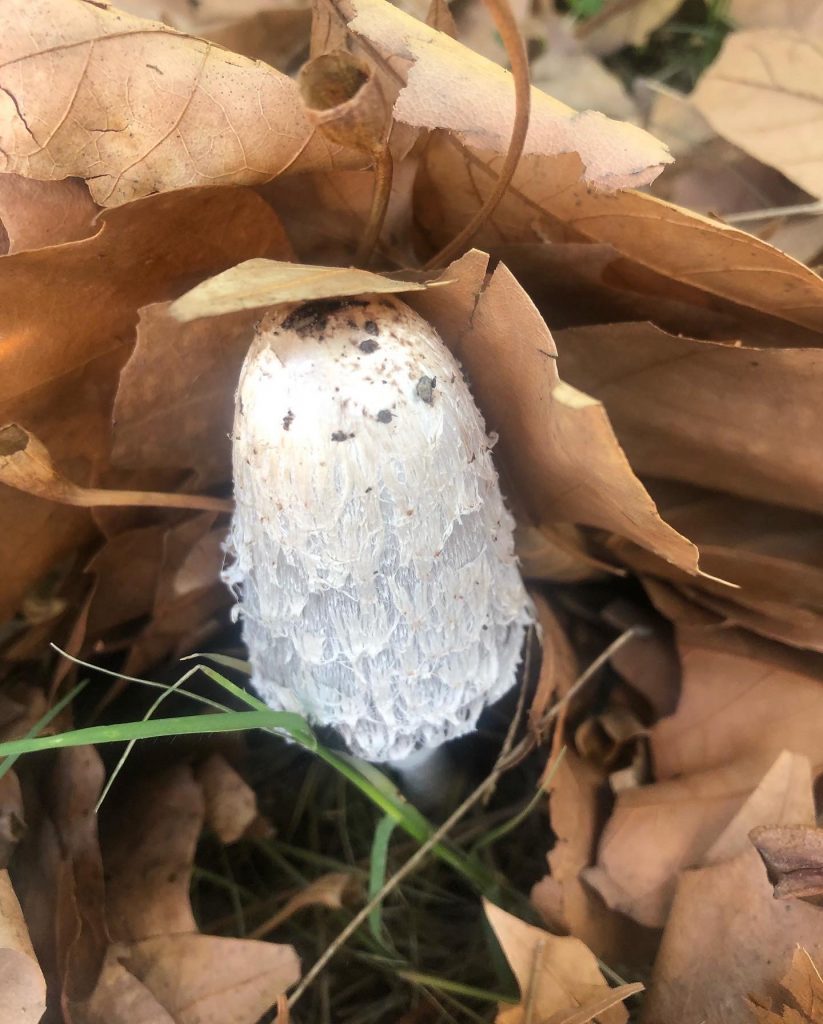
On 29 June 2022, I had the opportunity to forage two Shaggy ink cap mushrooms (Coprinus comatus) to explore using ink from these mushrooms. A friend contacted me when she saw the two mushrooms in her garden. Again this collaboration was much more about what the fungi presented me with. I placed the mushrooms in an airtight glass container and kept them overnight in the fridge. The next day the dark black/brown ink was visible around the fast decaying flesh of the mushrooms. I made small ink drawings with a dipping pen. I was made aware of this use of the Shaggy Ink Cap Mushroom from M Sheldrake. (p 7- 8) Interesting is that it is also an edible mushroom. I learn that it is being researched for health benefits, and one of them is the antioxidant activity which is closely related to other pro‐health properties like anticancer, anti-inflammatory, and anti-obesity. With all this information in mind, I would like to look to fungi as a material to work with – I have now ‘made’ ink, (inkcap mushroom, Coprinus comatus) and consider the collaboration work as a form of network, like the Mycelium of fungi.
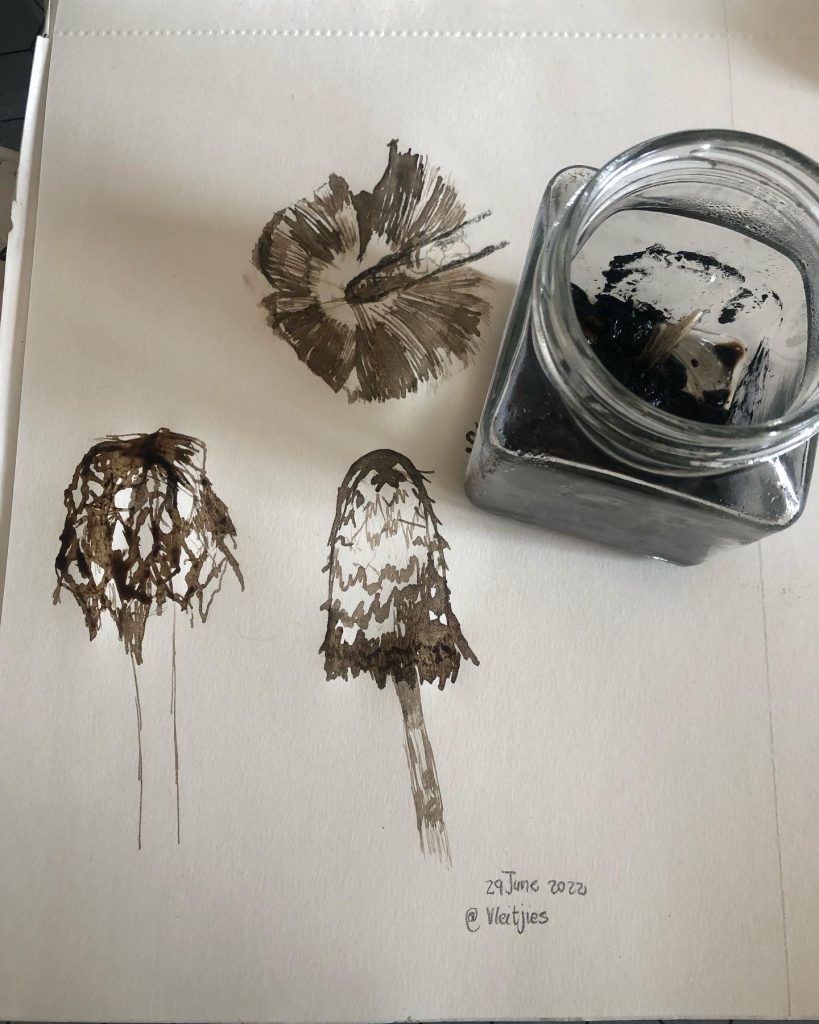
I learn that the use of fungi-derived pigments goes as far back as the Romans. I have no idea about using it as paint and or dye, and my interest develops around the pigment as ink and spores the mushrooms do leave on a surface. Another friend contacted me on 20 July with images of mushrooms she found whilst walking her dog – I was lucky, it was two Shaggy Ink Mushrooms. She took them home for me to collect. I became aware that friends were now becoming interested in my project and would assist with knowledge of sightings of mushrooms. On 21 July our housekeeper took me to a big Stubble Gill (Volvopluteus gloiecephalus); it made lovely spore prints.


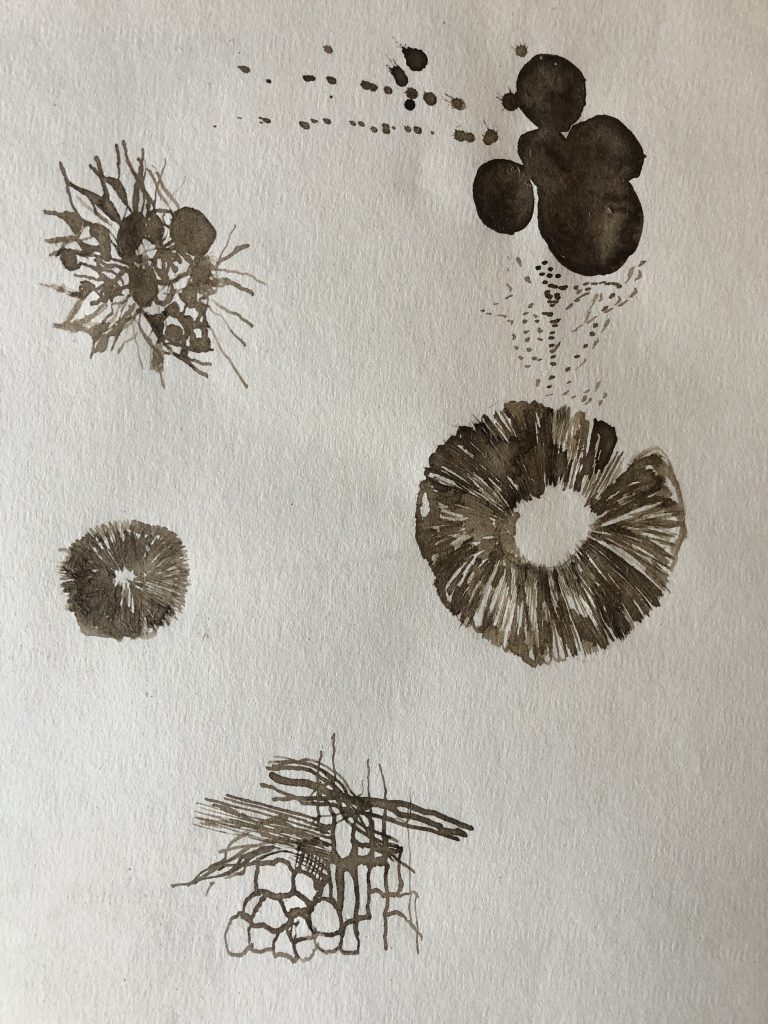
Mushrooms have a short life as we see it, many of the mushrooms I have encountered in nature have started the decaying process, mostly due to the higher temperatures, I would think. I learned that Mushrooms will go away on their own once the weather dries out, but this only means that the fruiting bodies have disappeared, and the fungal mycelia are still growing in the soil, out of sight. In my garden, I look at the presence of mushrooms as a positive indicator of decay in my compost-making. and efforts to keep the soil moist. I have noticed how the mushrooms decay within a few hours in the Summer heat. I started putting all the mushrooms I used for spore making back into my garden and hope the spores will find a space here to grow again.
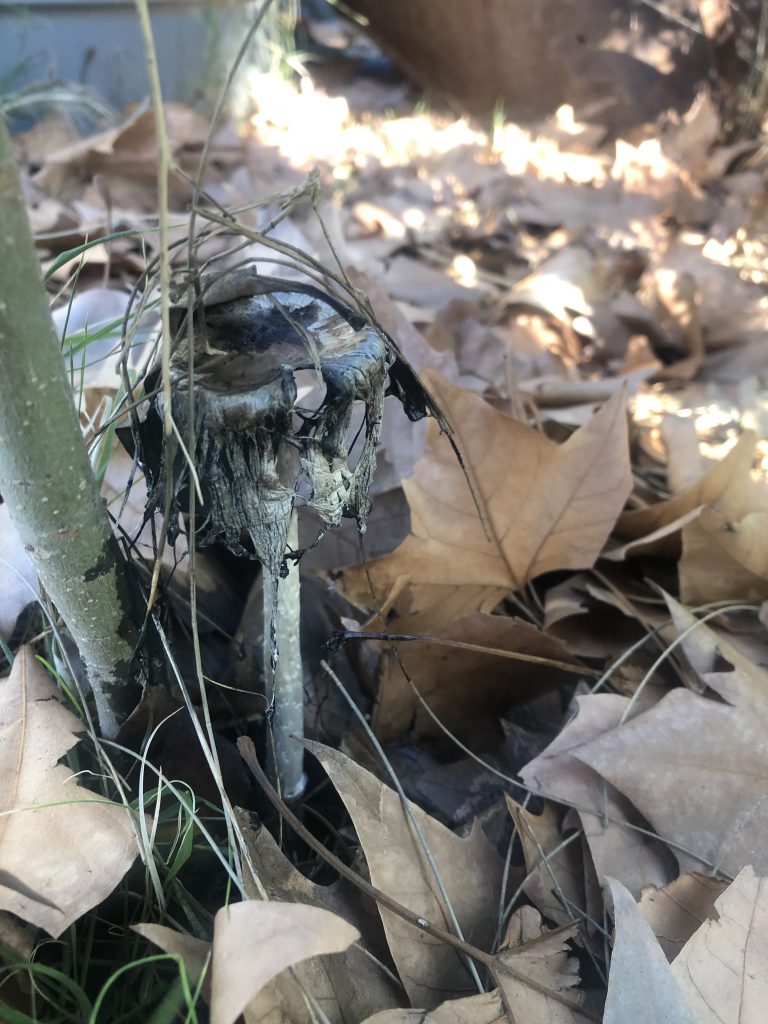
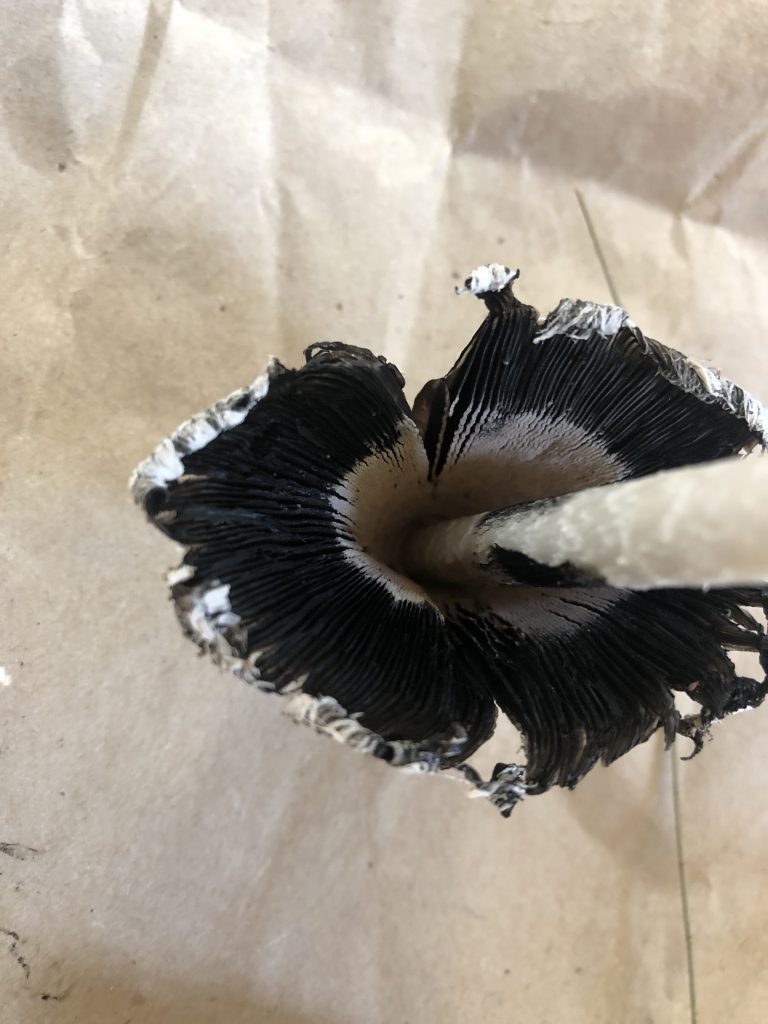
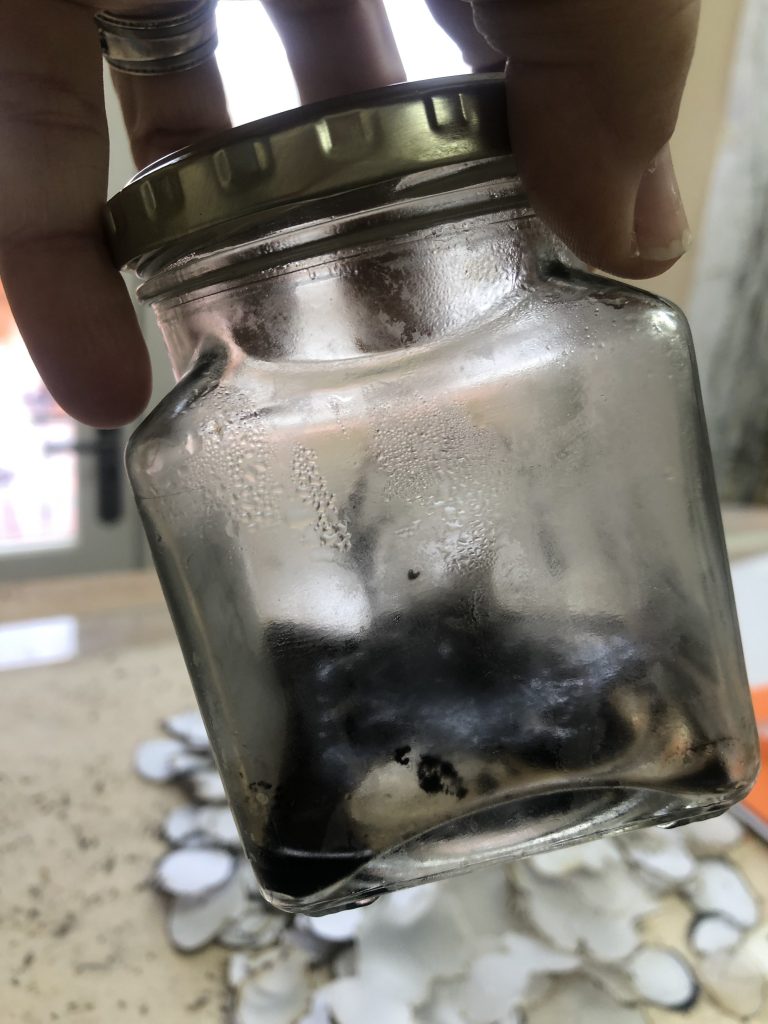
It is important to share that whilst I am learning and exploring my mind goes to work of Cy Twombly, who is a strong influence and as I look at my explorations of how I see mycelium as inspiration for painting. It is fifty-two feet long. Twombly worked on it for over twenty years, symbolising a journey through life and toward drifting into death. I think this will stay my biggest inspiration as it reminds me of time passing, spores left behind, decay, living and dying. It is about life.
On the Gargosian website I read the following
“I think of the painting’s movement as falling. . . . It cascades and it exits on the left. The painting is about life’s fleetingness. It’s a passage. It starts on the right and as you move to the left it just goes out.” Untitled (Say Goodbye, Catullus, to the Shores of Asia Minor) is a painted and written trace of life, of our being here, and of our bidding farewell—for Twombly, “a passage through everything.”
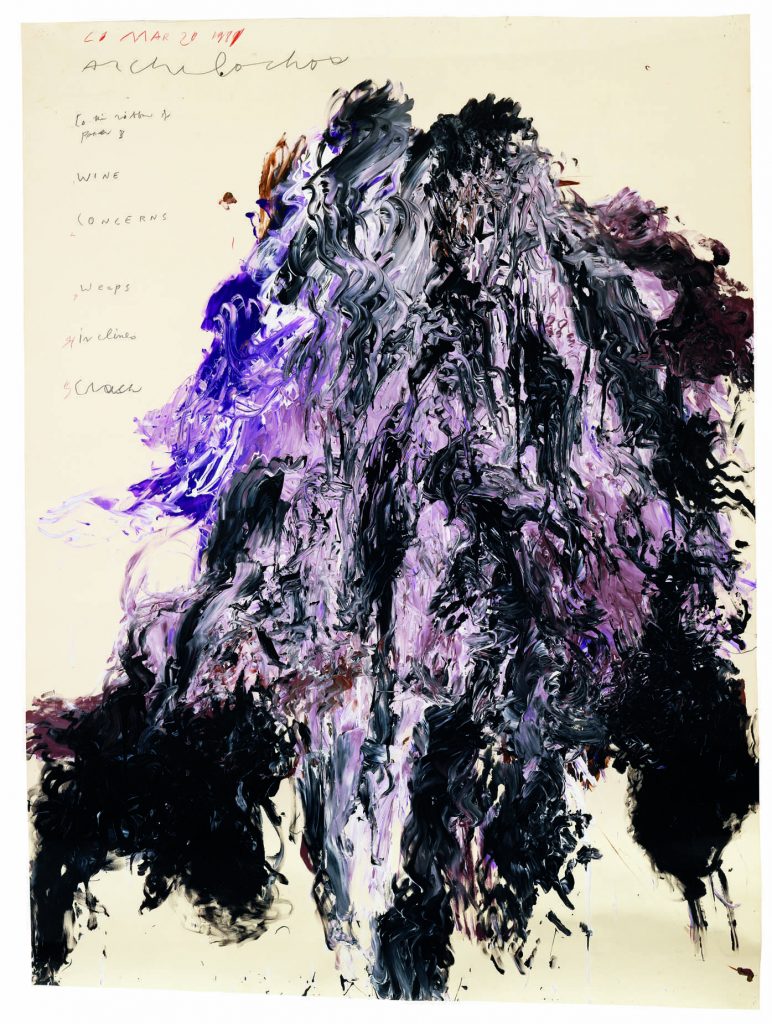
List of illustrations
Fig. 1 Stander, K. (2022) Forraging a Shaggy Ink Cap [photograph] In possession of: the author: Langvlei, Riebeek West.
Fig. 2 Stander, K. (2022) @ Vleitjies [painting with Shaggy Ink Cap ink] In possession of: the author: Langvlei, Riebeek West.
Fig. 3 Stander, K. (2022) Ink kap ink [Photograph] In possession of: the author: Langvlei, Riebeek West.
Fig. 4 Stander, K. (2022) Foraged Big Sheath [Photograph with permission of Me M Filander] In possession of: the author: Langvlei, Riebeek West.
Fig. 5 Stander, K. (2022) Exploring painting with mushroom ink [painting on paper] In possession of: the author: Langvlei, Riebeek West.
Fig. 6 Stander, K. (2022) Shaggy Ink cap decaying [Photograph] In possession of: the author: Langvlei, Riebeek West.
Fig. 7 Stander, K. (2022) Shaggy Ink Cap [Photograph] In possession of: the author: Langvlei, Riebeek West.
Fig. 8 Stander, K. (2022) Ink in bottle [Photograph of shaggy ink cap ink] In possession of: the author: Langvlei, Riebeek West.
Fig. 9. Twombly, Cy (1989) Untitled (Gaeta) [Oil on canvas] At: https://gagosian.com/media/gallery/press/2018/Yau_John._Cy_Twomblys_Extravagant_Synethesia._Hyperallergic_March_25_2018.pdf (Accessed on 21/11/21).
Bibliography
Sheldrake, M (2020) Entangled Life. Penguin Random House Publishers (p 238)
4.2. SPORE PRINTING
I also consider how the mushroom spores can make their own ‘drawing’. I read that part of identifying a mushroom in the wild is to collect the species and take it home, cut the stem and place the cap on white paper, close with a glass/plastic lid and leave for 24 hours.
My first spore prints were made with mushrooms I bought at the supermarket and kept under a glass dome on a shelf in our pantry. I had no idea that the spore print would be brown and show off well on the white paper. My mind whilst thinking about the marks (spores) left by the mushrooms goes to when one works with nature, how much of the work made is due to the vibrance of the matter. I look at these prints as a type of Botanical print. I wondered if I can consider making cyanotype prints of the spoor. Here my material is natural, and the work is its mark-making left behind.
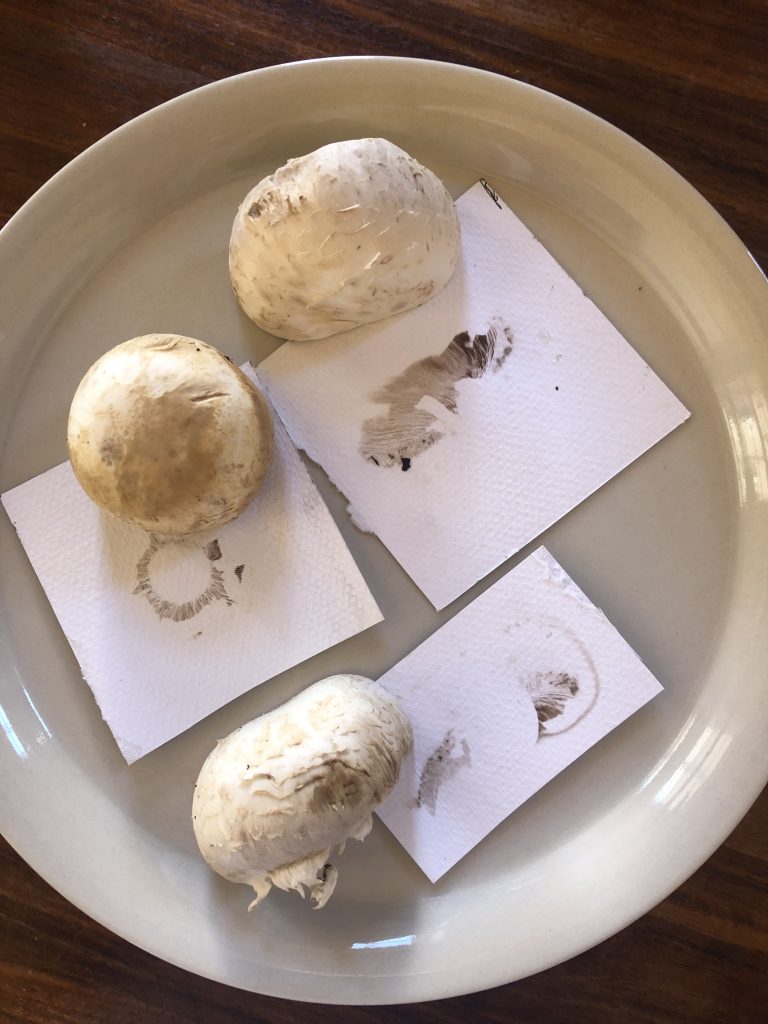
I will add the work I did with spore prints here, but they were done much later in my making and explorations with mushrooms as material, as I could only start foraging much later into the year.
FORAGING DURING THE WINTER OF 2022
More opportunities to come in contact with wild mushrooms came when our winter rains started to fall by July 2022. I had by now made friends with a foraging couple who was willing to take me along on foraging expeditions in forests in nearby villages. I do believe this opportunity brought me closer to understanding the fungi as being a collaborative material – all of a sudden I was with the fungi, seeing them in their habitat, crawling down in mossy or leafy undergrowth trying to spot them. I could see, touch and smell them in their own habitat. I learned that they pop up overnight after good rains, and started finding them outside my house on short walks around the dam, in front of our home, or foraging for edible ones in the pine forests. I was thankful that by now I had an idea of the root of these fungi, explored mycelium in my making, and could now enjoy these fruits, visually and physically (eating and documenting images). I started using an Application on my phone to help with identifying and documenting the Fungi I saw. This made me aware of the place where mushrooms grow – the natural habitat it needs to survive in became a new awareness and knowledge for me. I feel the entanglement developed stronger here.
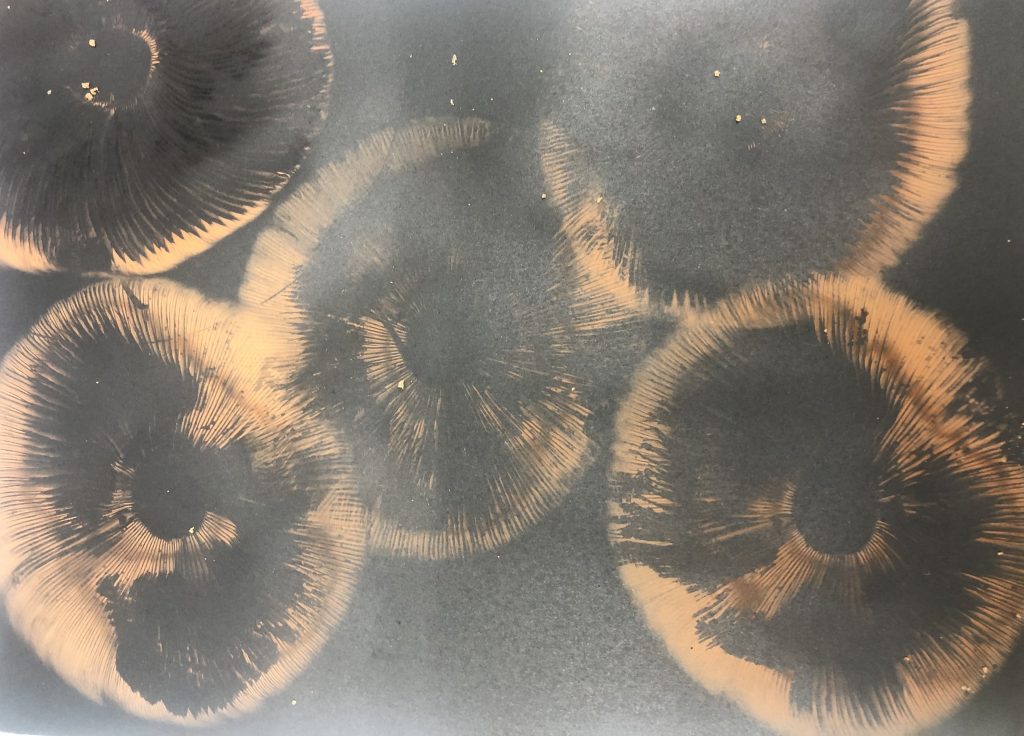
More spore print-making opportunities arose from my direct contact with fungi and I learned that spores were a good way to identify mushrooms. I started wondering about my walking connecting with foraging and if I could see it as an embodiment of the land as well as that the land has productive femininity. As my making continued, I consider the idea of dealing or working with the invisible – spores are not seen, I know in the print we see the symmetry, which is microscopically small and different with each mushroom.
Below is a work where I used a mushroom as a print repeatedly on a small round canvas. I used a Shaggy Ink Cap I found here, under a tree on our farmyard.
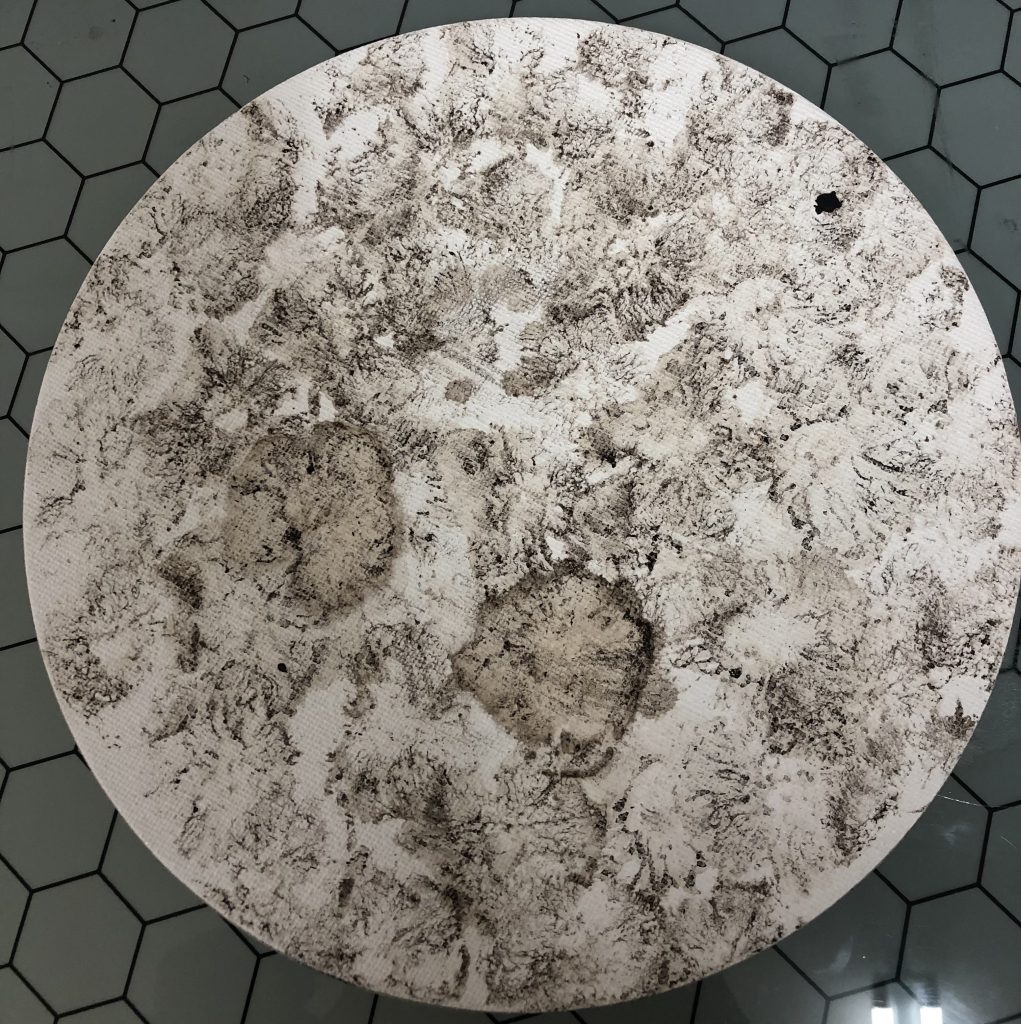
I painted into the work with mushroom ink.
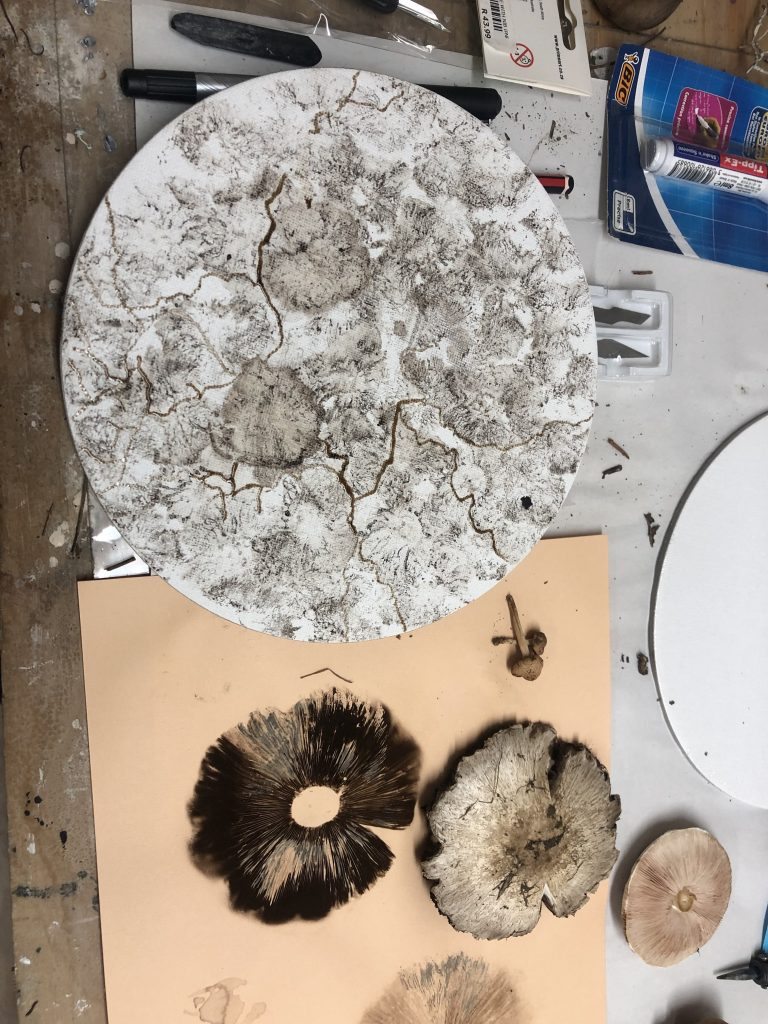
By now I could imagine spore prints as a continuous making process to consider in this project. I have come to understand that mushrooms have different colour spore prints, varying in colours from dark brown/black, purple, to pinkish, cream and white. I was never really interested in specifically working with edible mushrooms, my interest was mostly aesthetic and noticing places where they occur. From Mycology I did learn to observe the form of fungi with much more care. My own homegrown Oyster mushrooms brought the possibility to work with the material and I would say the spores I collected in the image below are much more the outflow of my collaboration with this living organism. I used aluminium foil to make prints of the spore, mainly for further explorations of cultivating more oyster mushrooms.
The temporality of marks became fascinating whilst comparing my finger marks with the spore prints. The work also leads to the materiality of paper as an art medium and the ways in which materials manipulate it with these beautiful marks and textures left on it. I also wonder if I could again, refer to Part One of the course and view these spore prints (as a consideration)of other things that perform for me. My gesture was only to place them in the media. I felt that I gained something of the understanding of agential realism which Karen Barad writes about. (see my blog Project 4, Part One of the course material)
It also took me to work I did in Part Two of the course around mark-making as well as later in the course where I considered painting without paint and my relationship with materiality. In this work, I used my wet fingers and dipped them into gypsum and water to create marks which resembled the natural shapes I was painting at that stage. I find it interesting that by looking back at these works I see the influence of mark-making and the different materials I explored. Now I look at these spores with a different eye – I see that they represent the ‘volume of a fungus’. It says something about the fungi that becomes a subject as well as material. I now look at how this experience shifted my making from painting to this new relationship with agency. I consider the mushroom print as an act of the object being printable in itself. It also made me aware of temporality and place – when I look back at all the images (documentation) I have, they are like memories of place and time.
Reading Entangled Life, I regularly find inspiring quotes to work by. I can think of them as provocations to inspire my making.
“Regardless, imagination forms part of the everyday business of inquiring. Science isn’t an exercise in cold-blooded rationality. Scientists are—and have always been— emotional, creative, intuitive, whole human beings, asking questions about a world that was never made to be cataloged and systematized. Whenever I asked what these fungi were doing and designed studies to try and understand their behaviors, I necessarily imagined them.” and later ……” Rather, I wanted to let these organisms lure me out of my well-worn patterns of thought, to imagine the possibilities they face, to let them press against the limits of my understanding, to give myself permission to be amazed—and confused—by their entangled lives.” (2020:25)
List of Illustrations
Fig. 1 Stander, K. (2022) First spore print attempt [Photograph] In possession of: the author: Langvlei, Riebeek West.
Fig. 2 Stander, K. (2022) Spore prints of Big Sheath Mushroom [paper and mushroom spores] In possession of: the author: Langvlei, Riebeek West.
Fig. 3 Stander, K. (2022) Sporeprints WIP [canvas and mushroom spores] In possession of: the author: Langvlei, Riebeek West.
Fig. 4 Stander, K. (2022) Sporeprints [canvas, mushroom spores and ink] In possession of: the author: Langvlei, Riebeek West.
Bibliography
Sheldrake, M (2020) Entangled Life. Penguin Random House Publishers
4.3. CYANOTYPE PRINTING
By early January spore making has shown over the next two days to not work out….I find almost no marks on the paper and canvas. I therefore resorted to using cyanotype printing and prepped a few paper supports. I have afterwards come to the conclusion that shop-bought mushrooms contain fewer spores due to the time of picking.
Below is a collage of prints I made with sundried mushrooms. The fresh mushroom is too wet to make a proper print and will not interact with the chemicals used in this process – I learned this my working with storebought mushrooms.
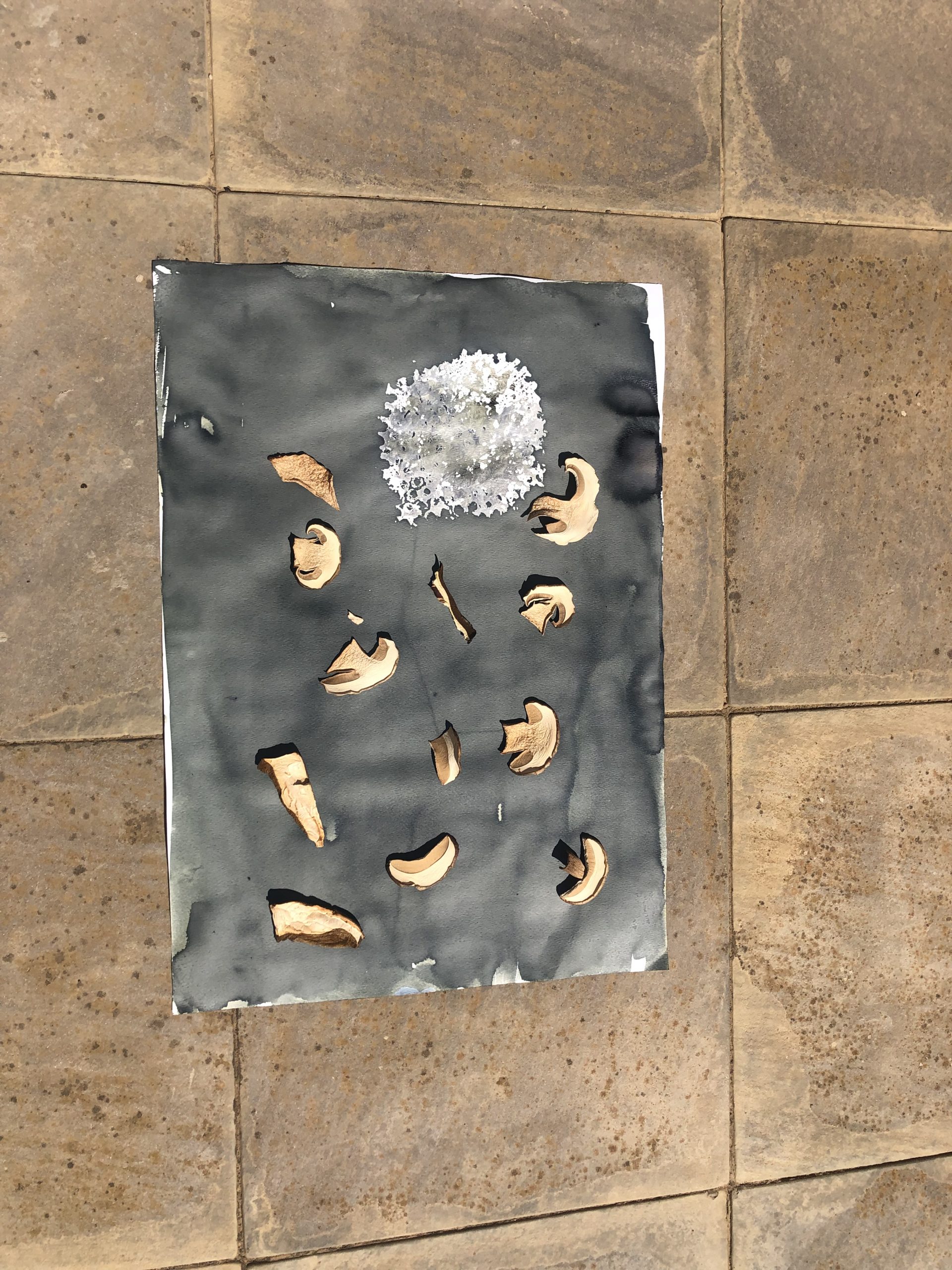
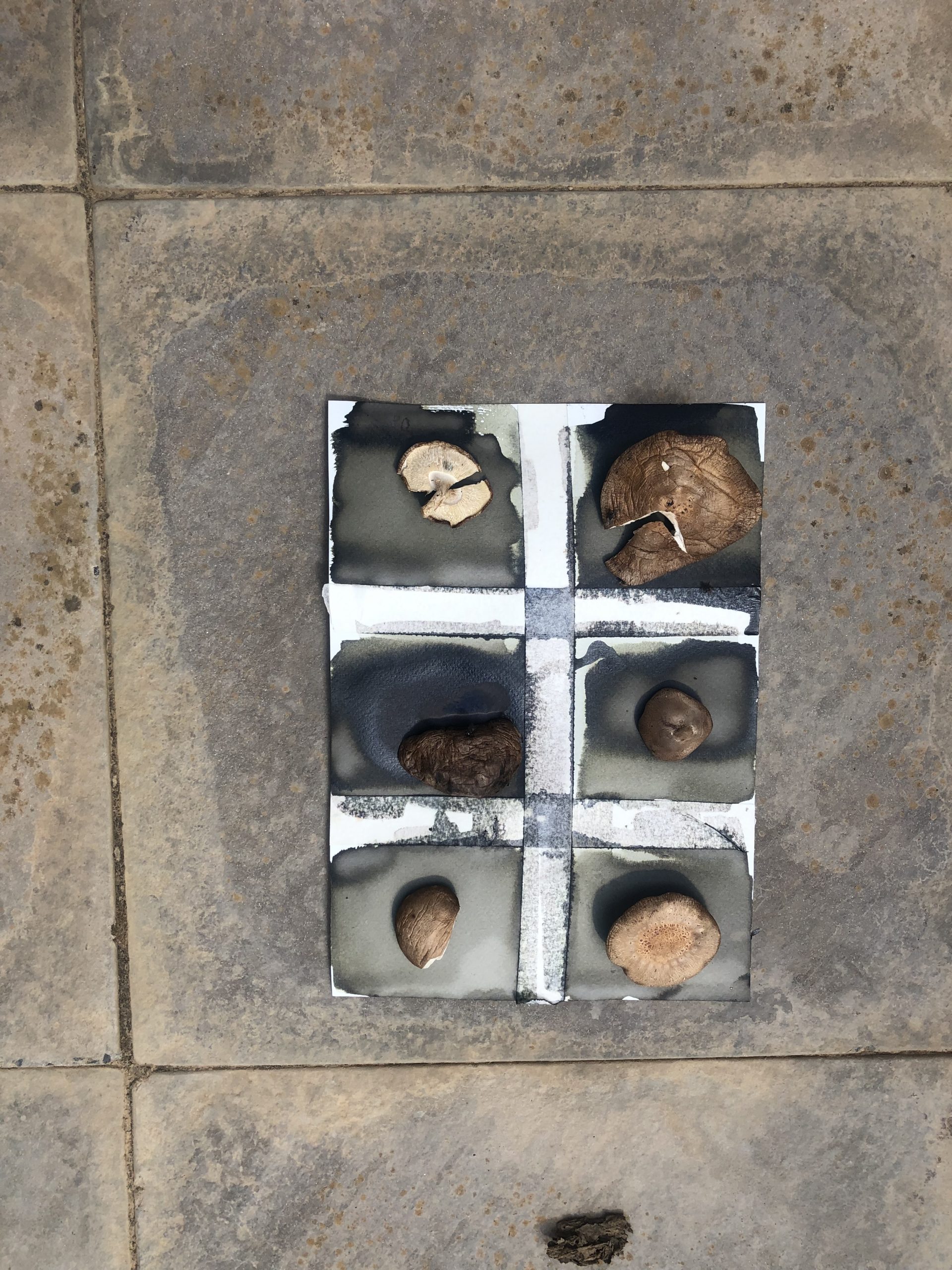
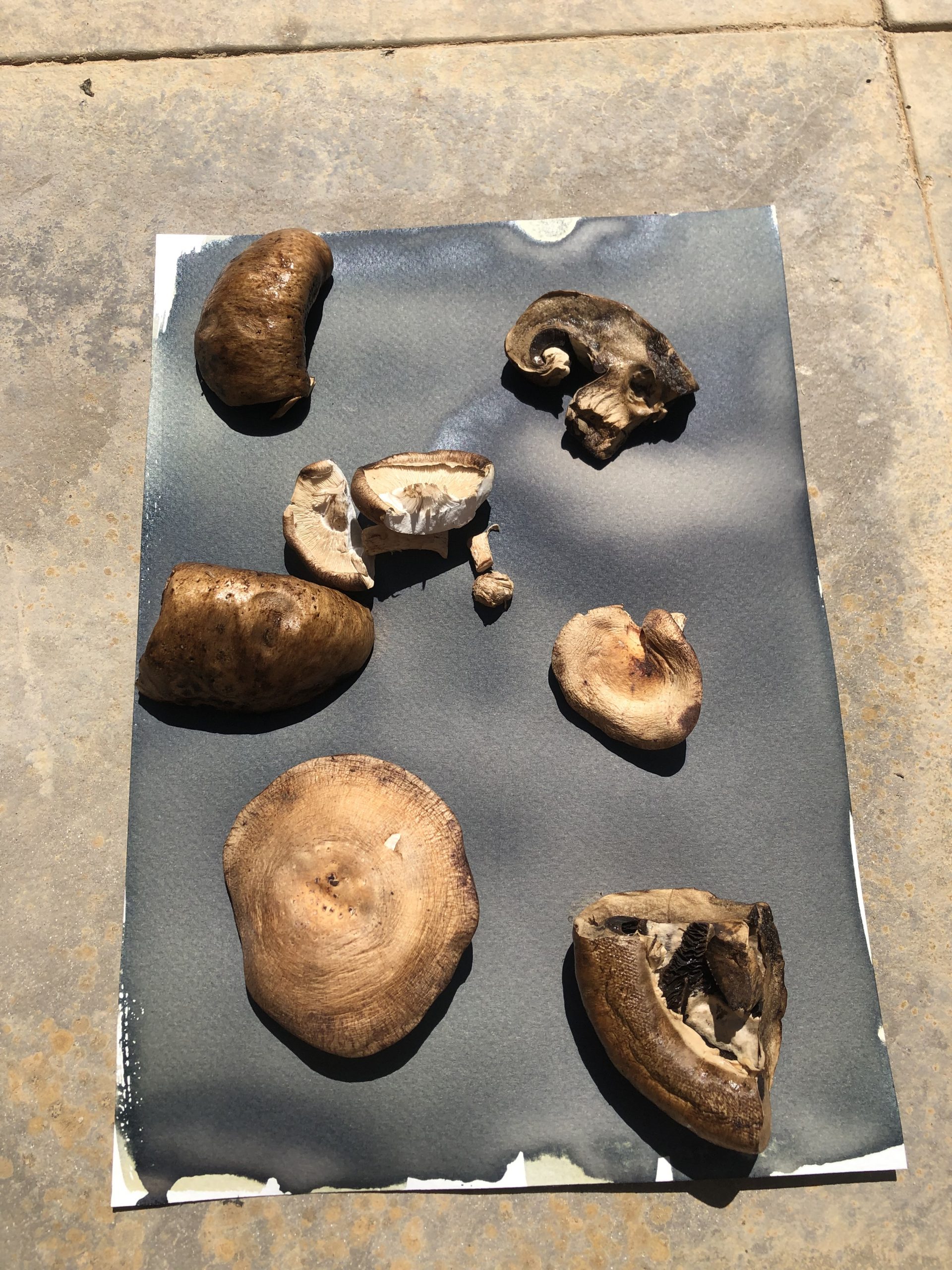
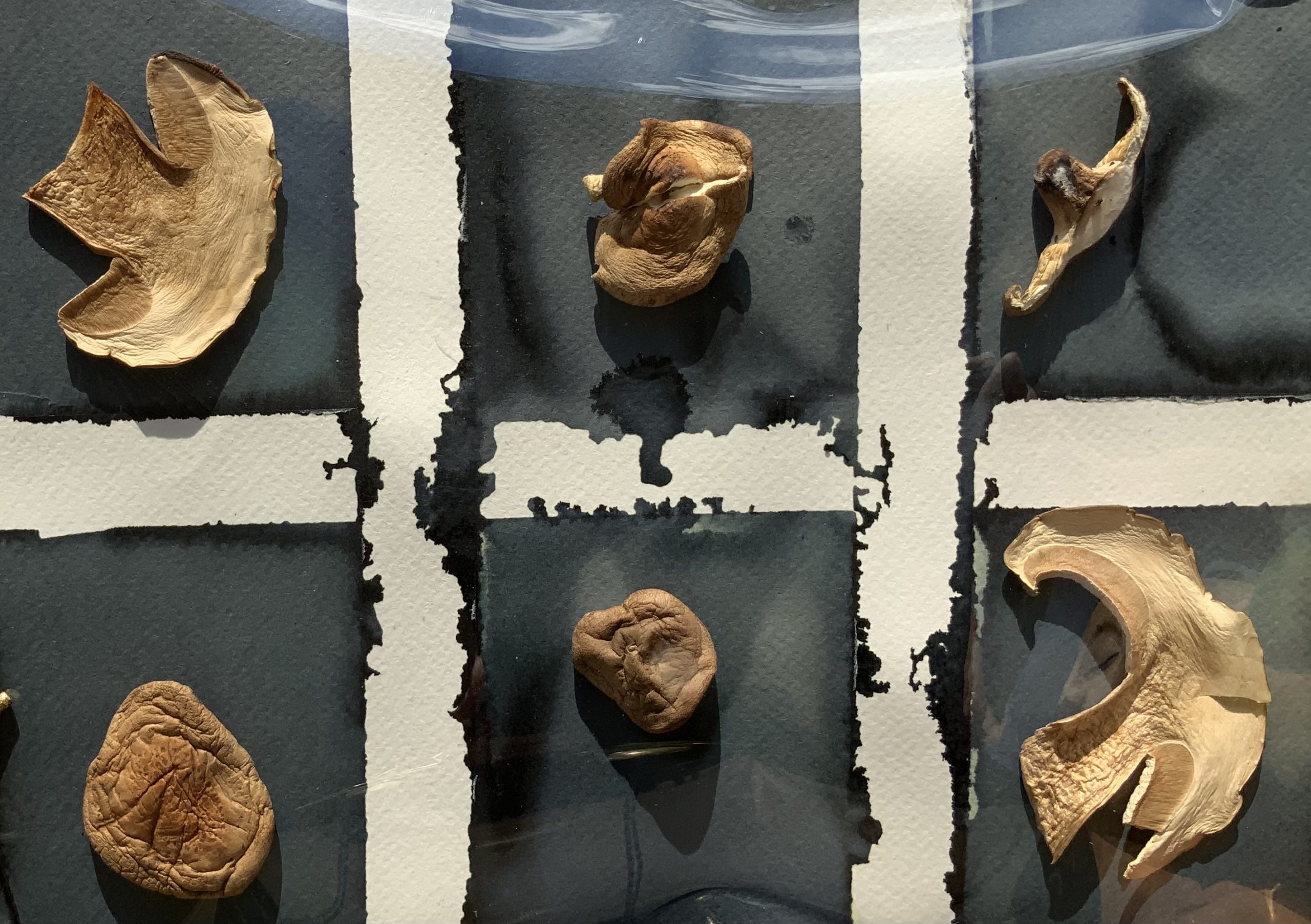
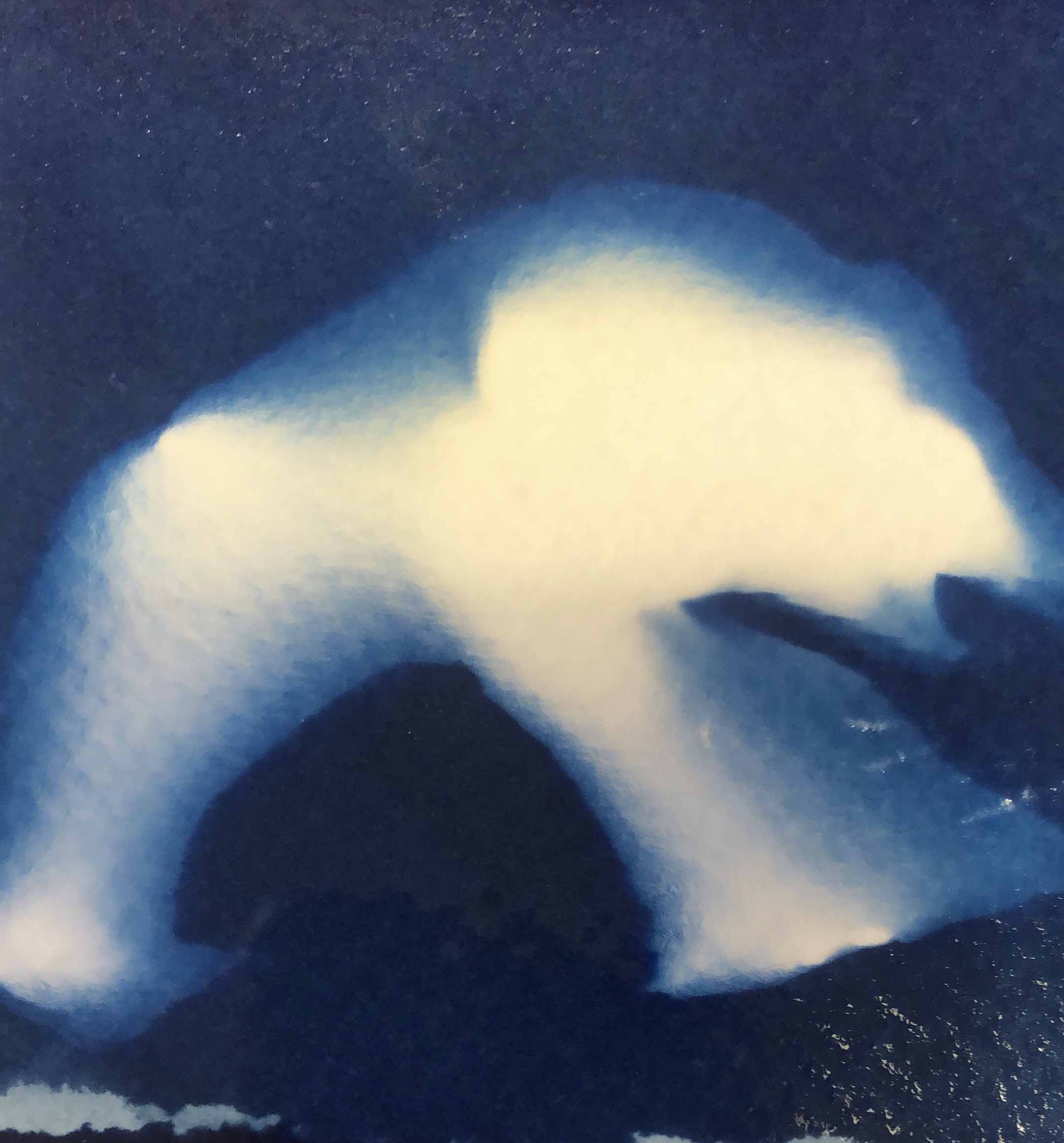

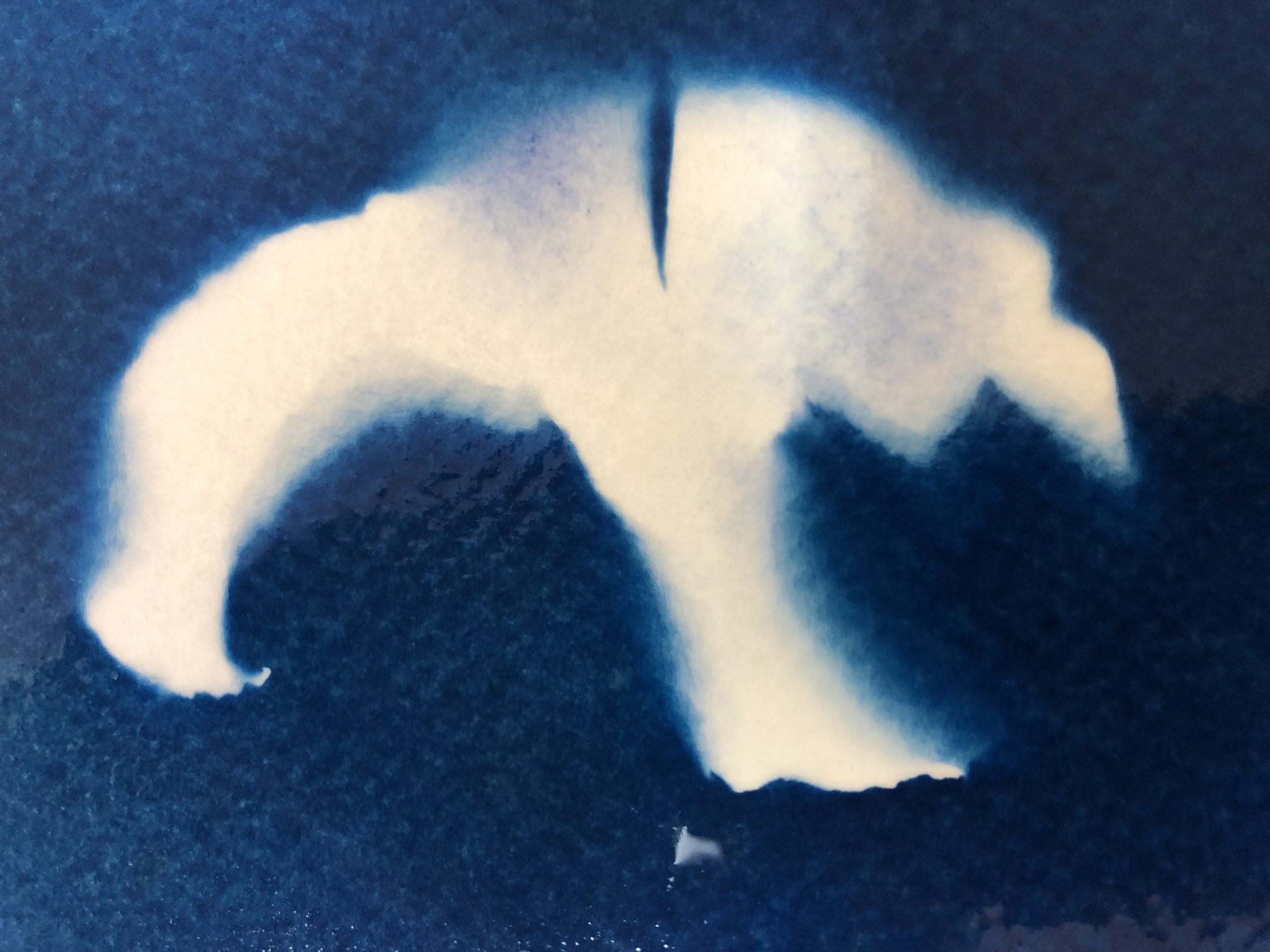

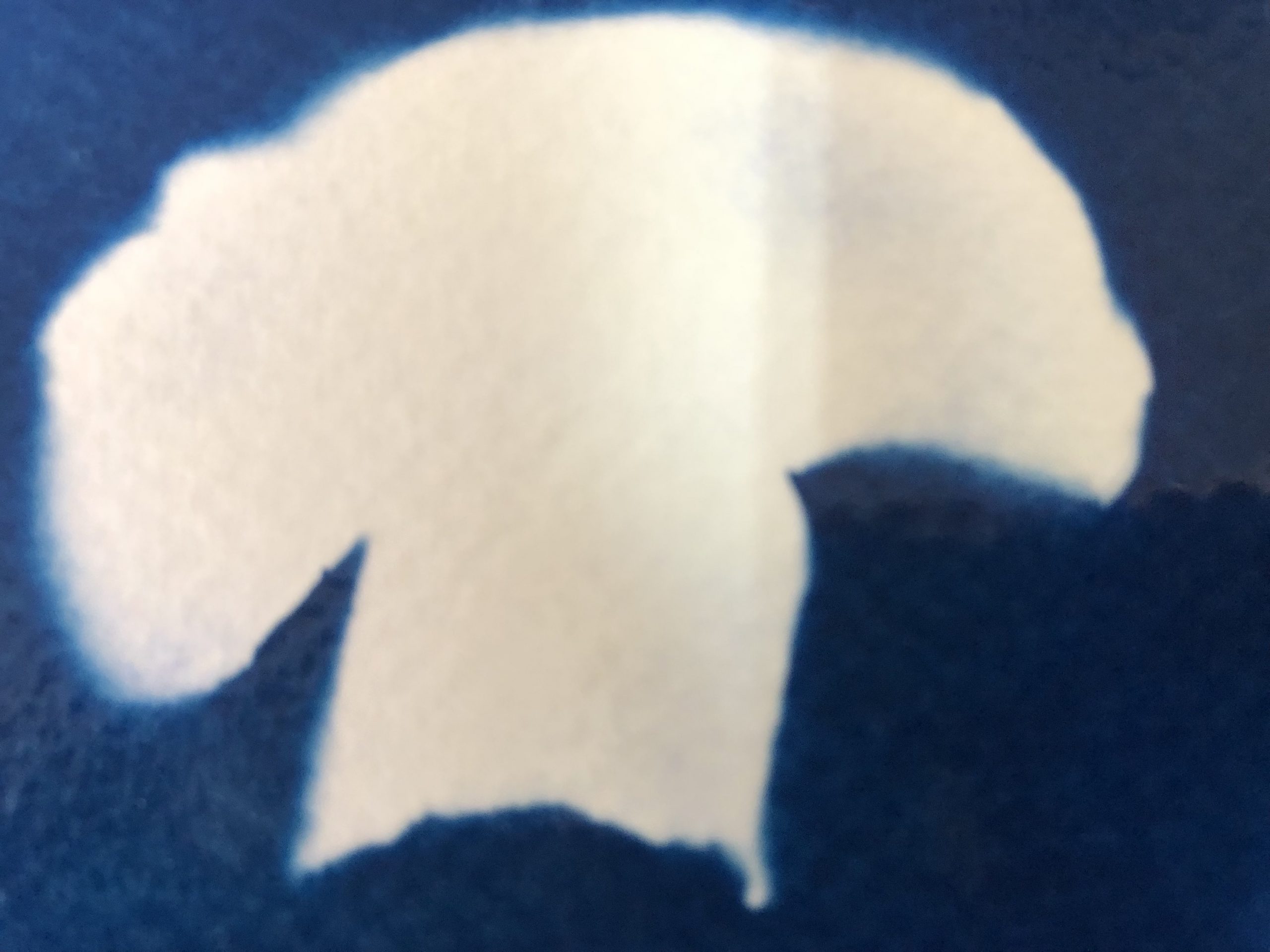


A local artist commented on a post on Instagram about these prints that the blurriness of the prints makes them moody and mystical. I do like this interpretation! Could there be an opportunity to think about these forms in terms of how a viewer would experience them if I imagined them in a gallery/exhibition space?
4.4. MARK-MAKING WITH OTHER MATERIALS
As part of the course work where I was asked to consider painting without paint (Project 4 of Part 4), I looked at coffee markings, used mayonnaise, starter dough ( bread yeast) pigments and lichen. Coffee markings and using it as a ground to develop work looks appealing as developing ideas for a Still life. I do like the colour shades in the works above and can see that drawing or painting into it can work. I continue to explore charcoal as a medium and enjoy the tonal qualities of the markings on the surface.
In the gallery below I also share other explorations which opened up other materials and also the possibility of using lichen. During summer I will not have mushrooms to work with, and have to consider material for the rest of the season, lichen seem to be the ideal medium to explore.
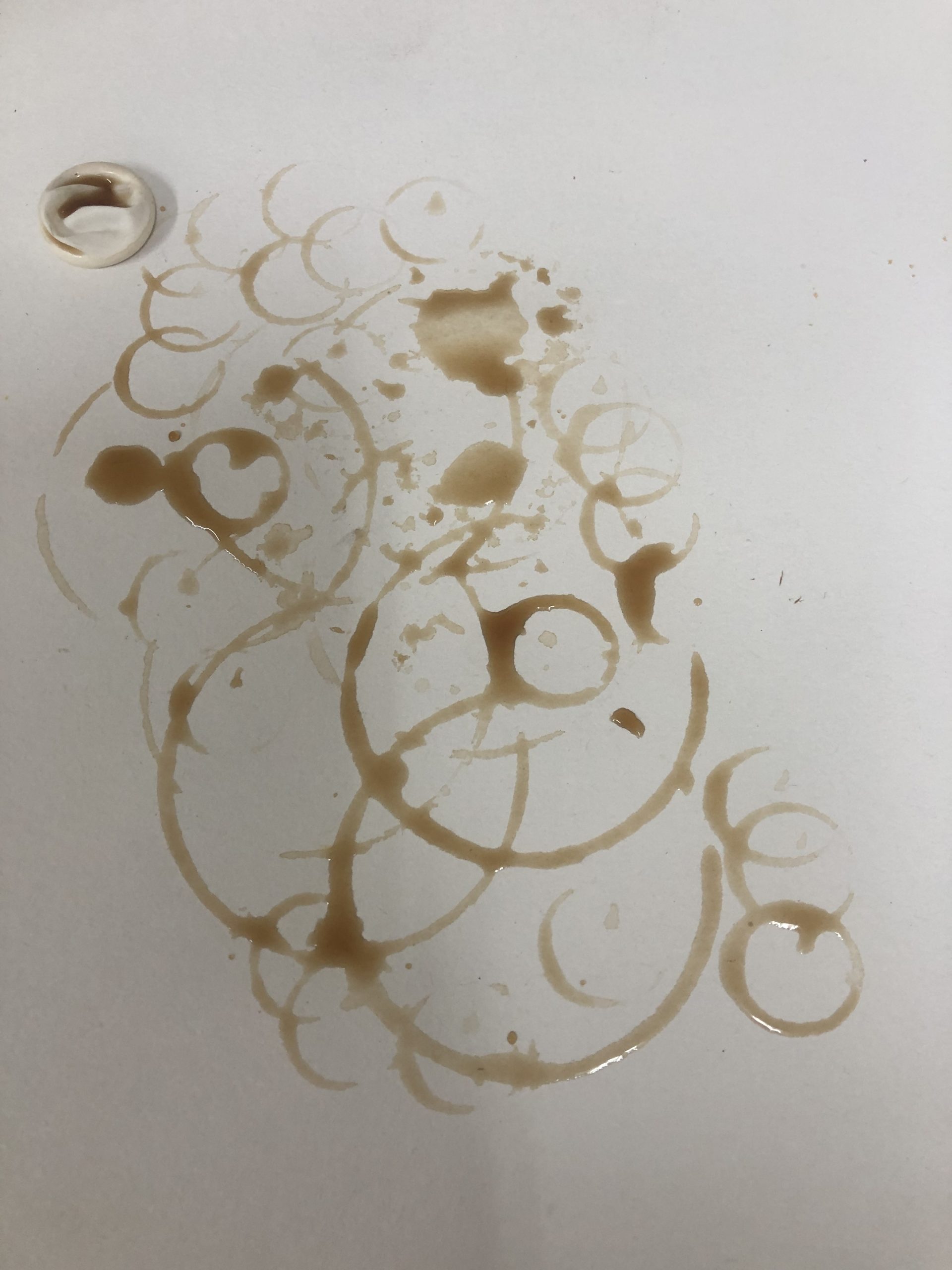
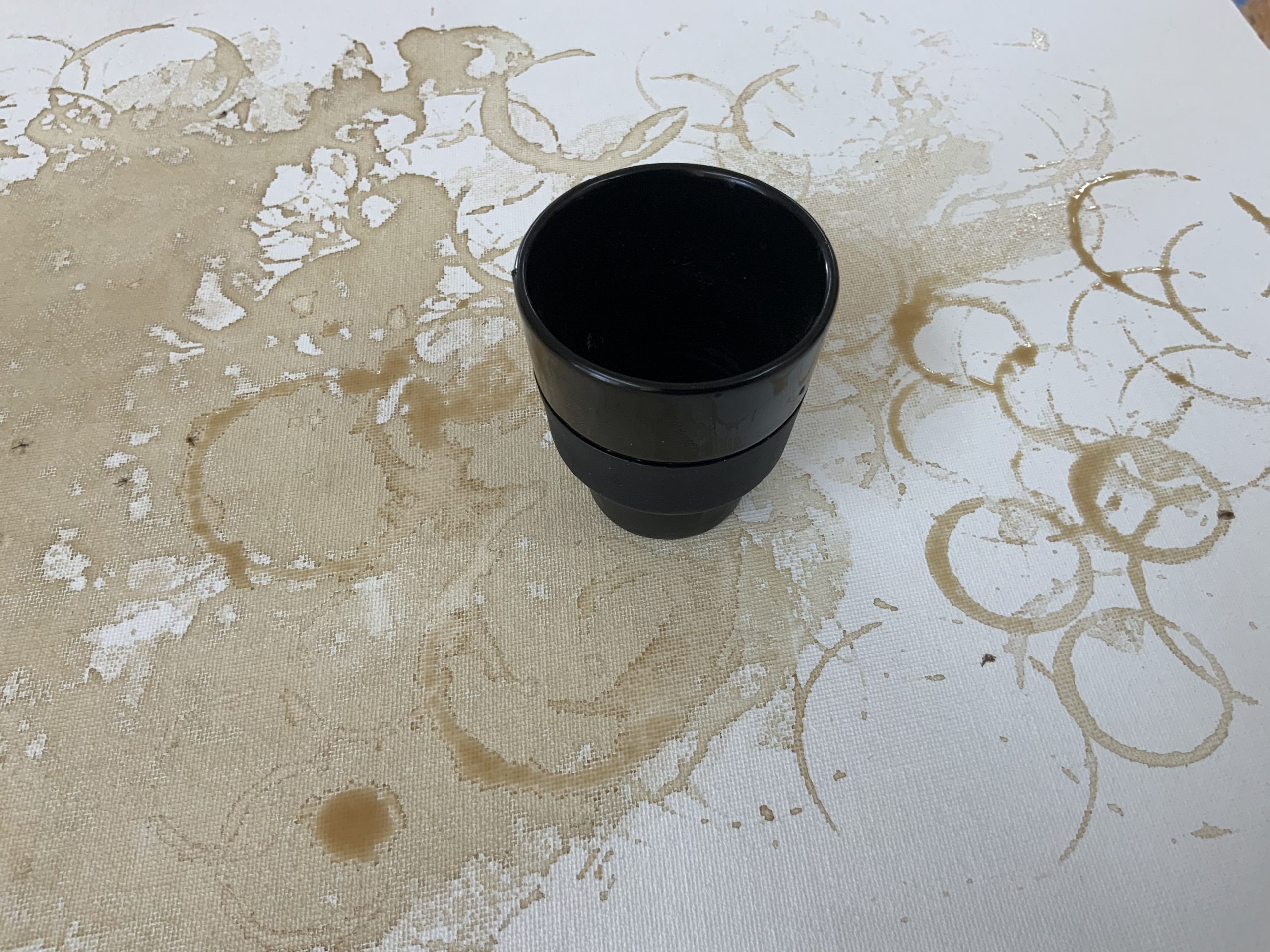
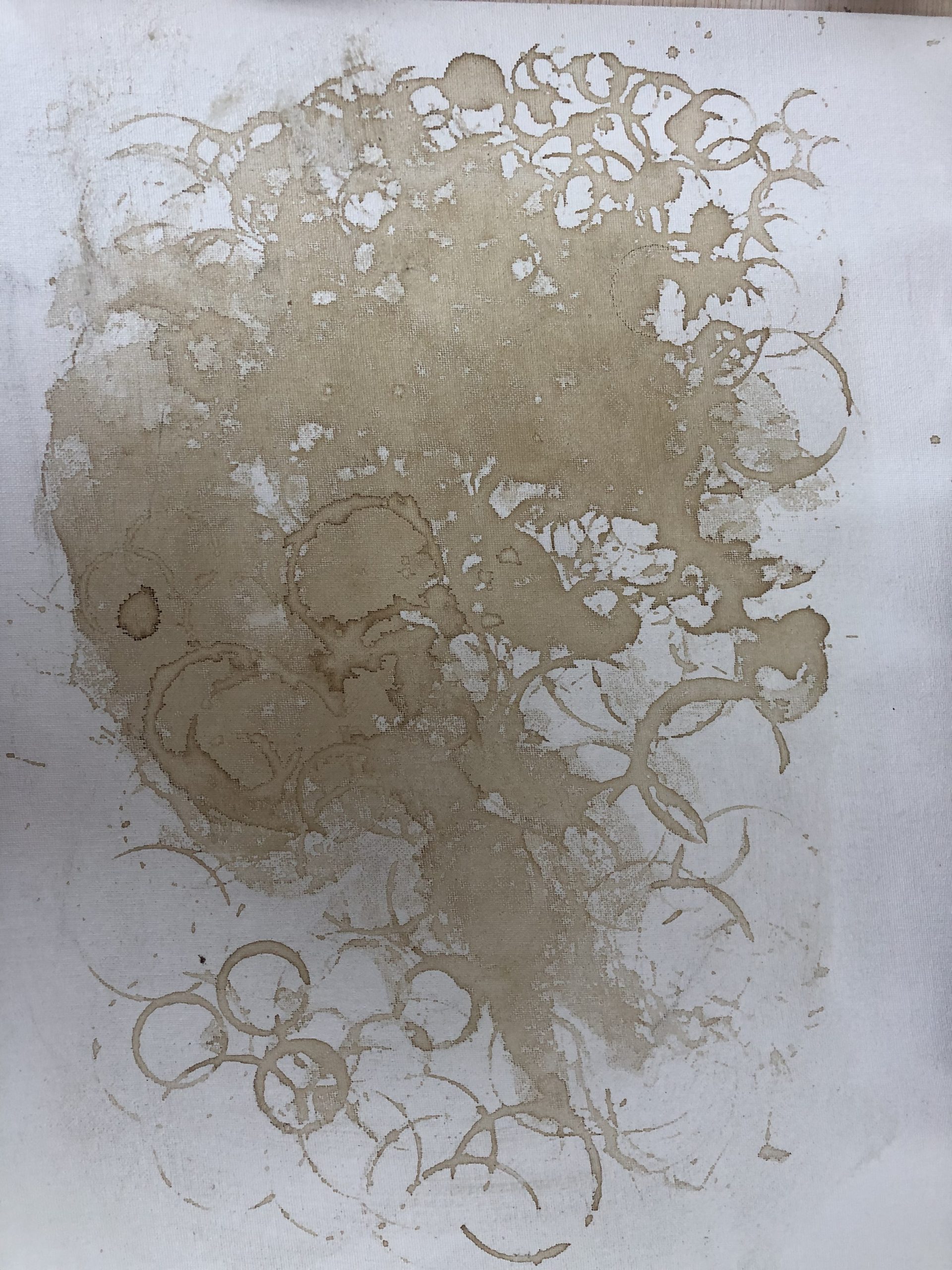
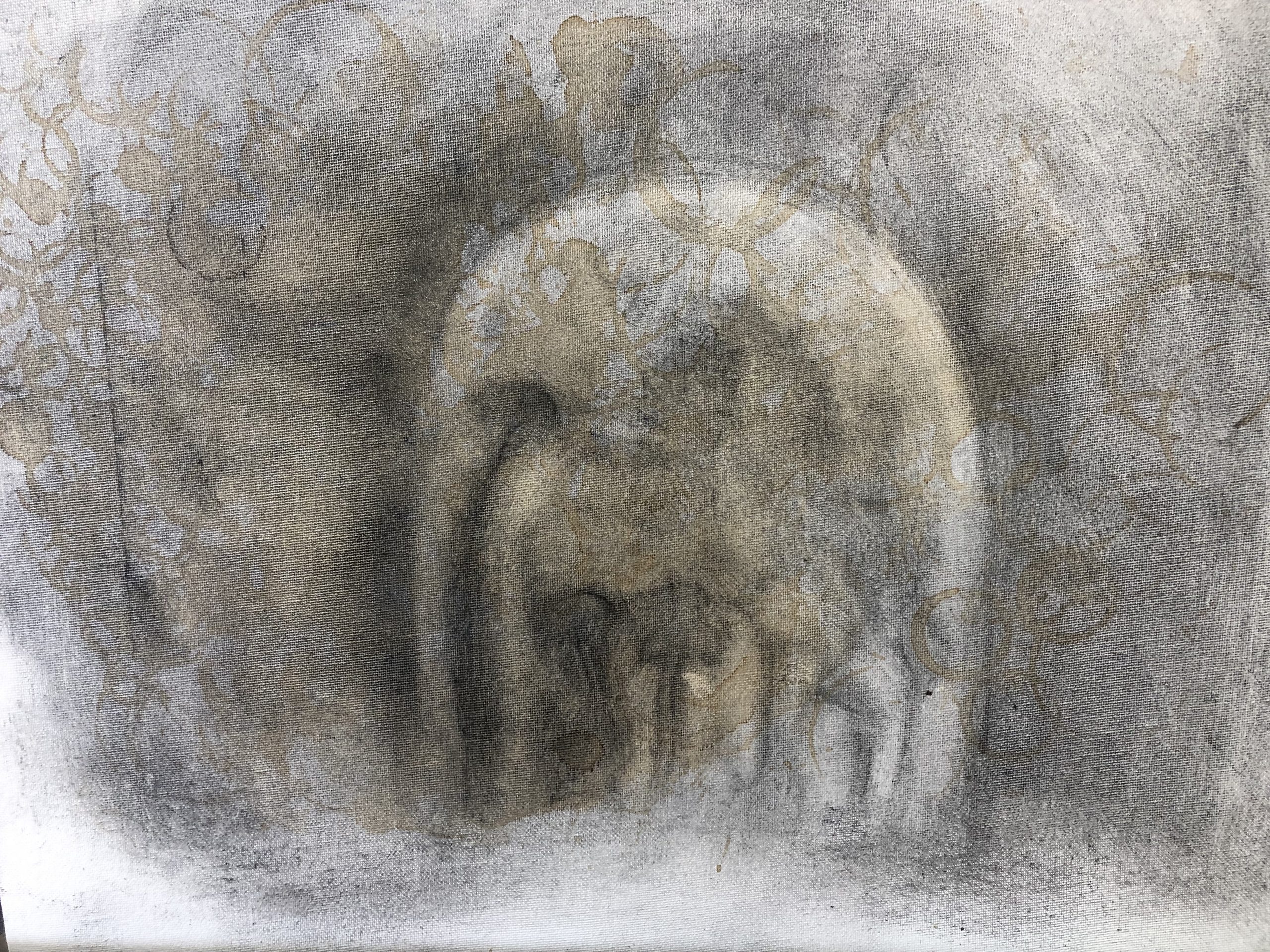

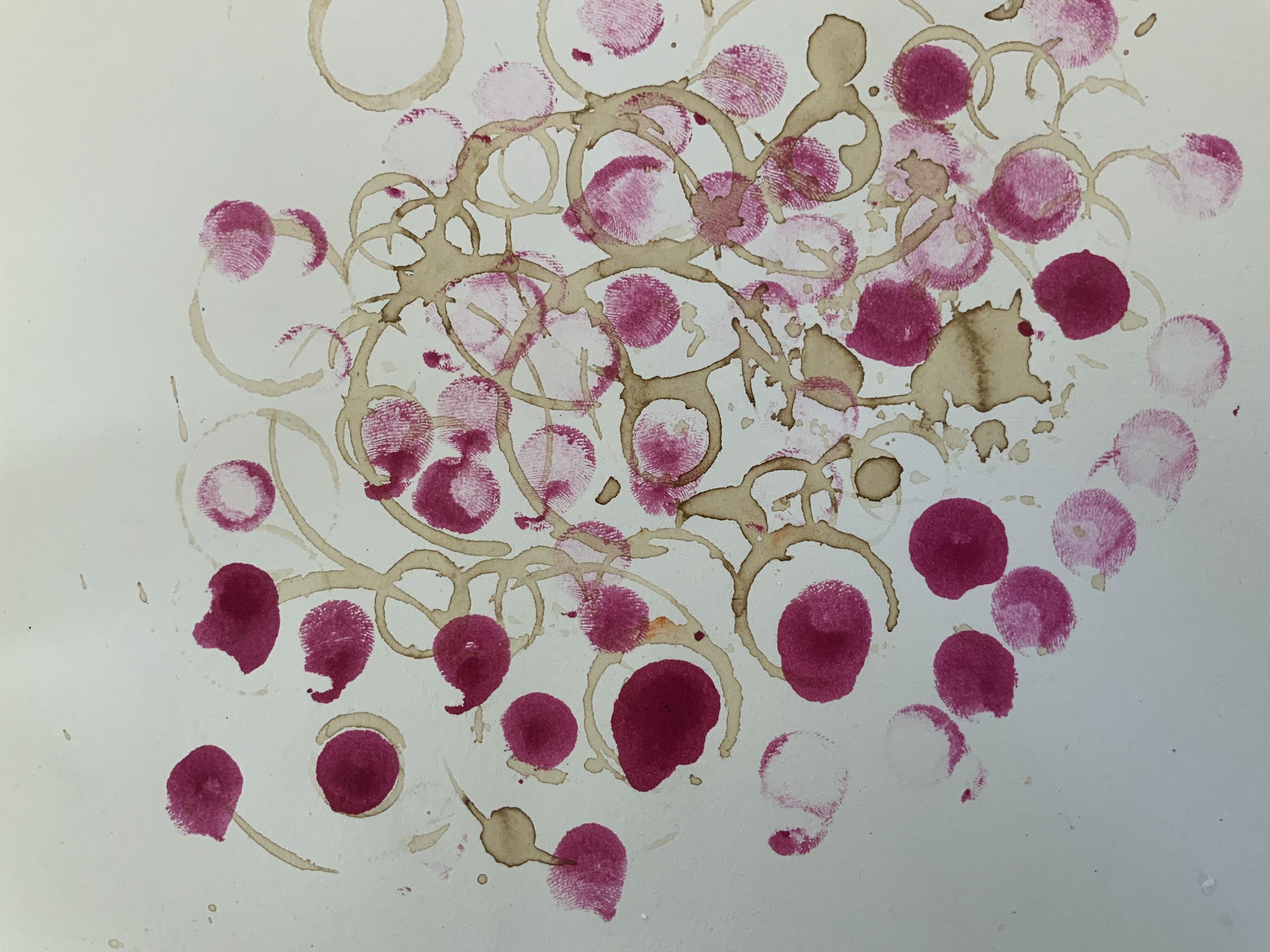

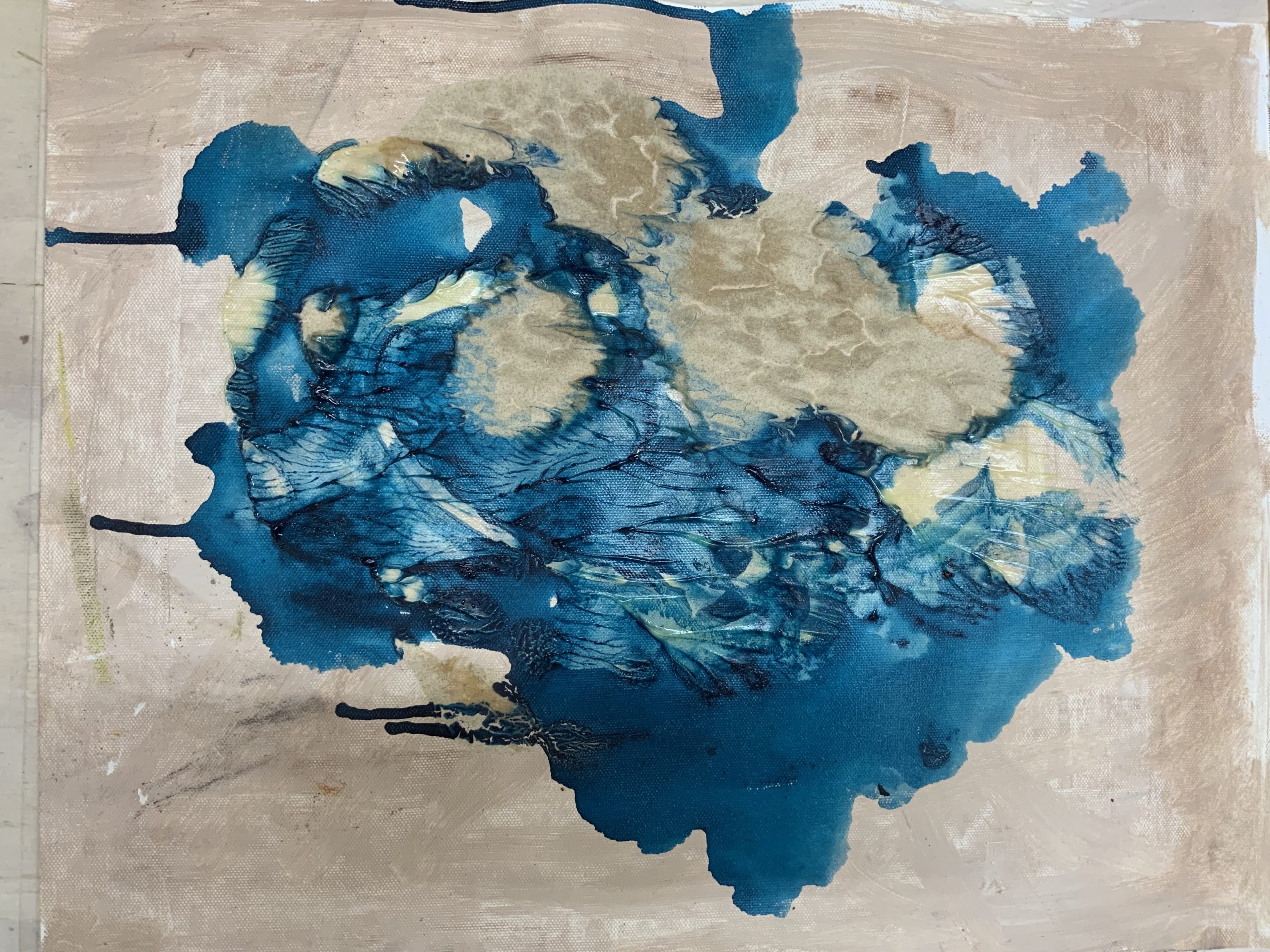
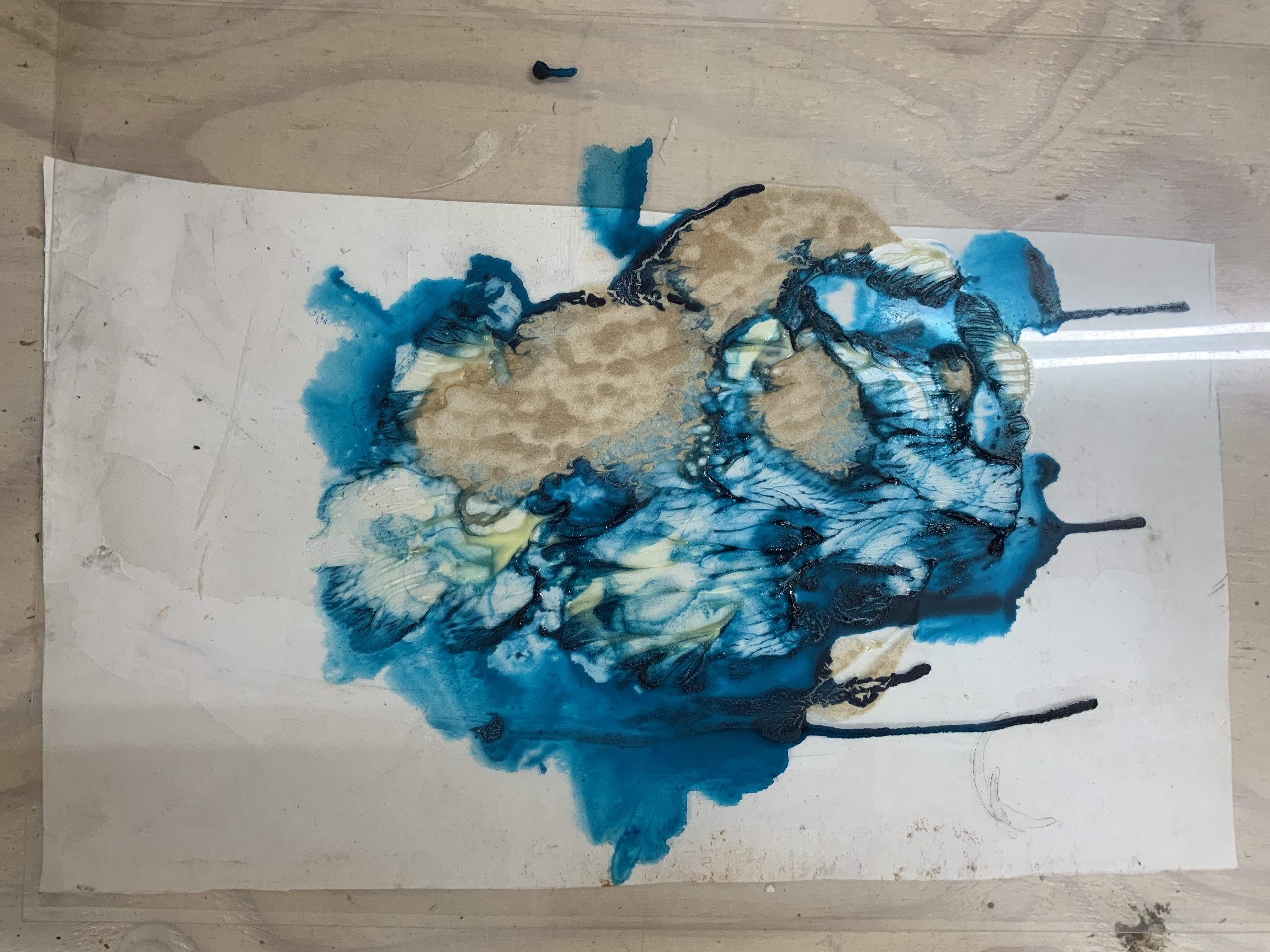


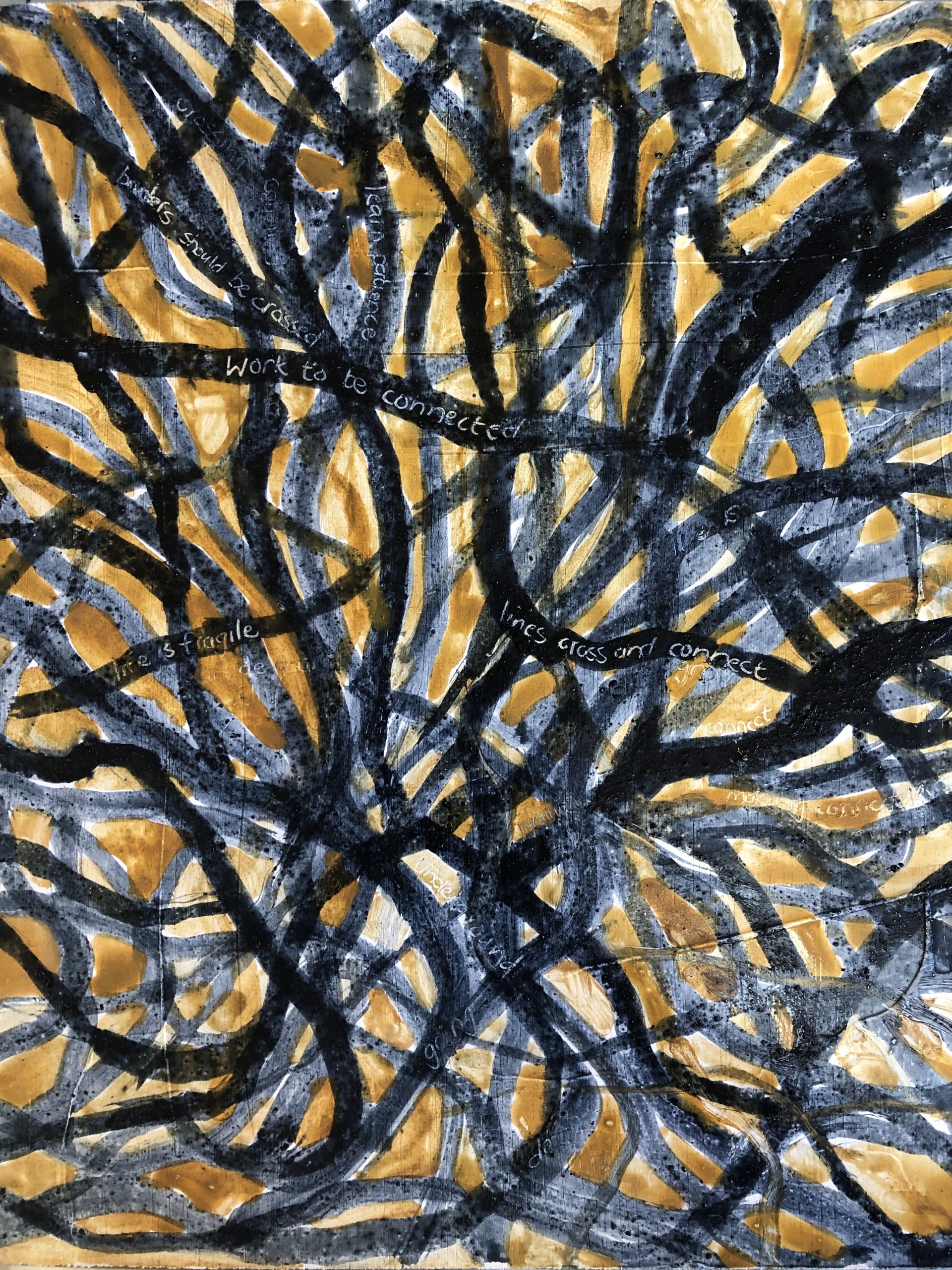

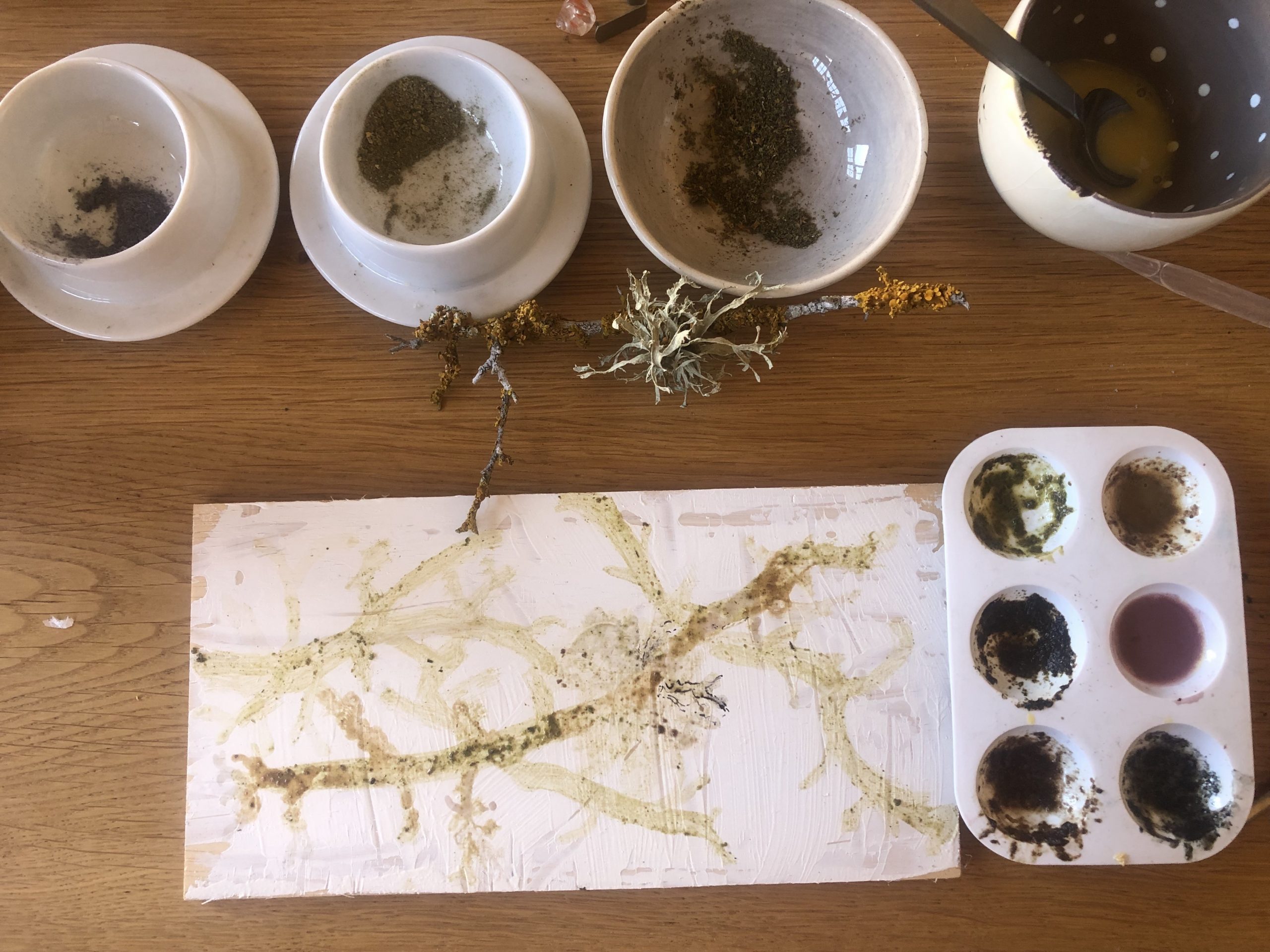

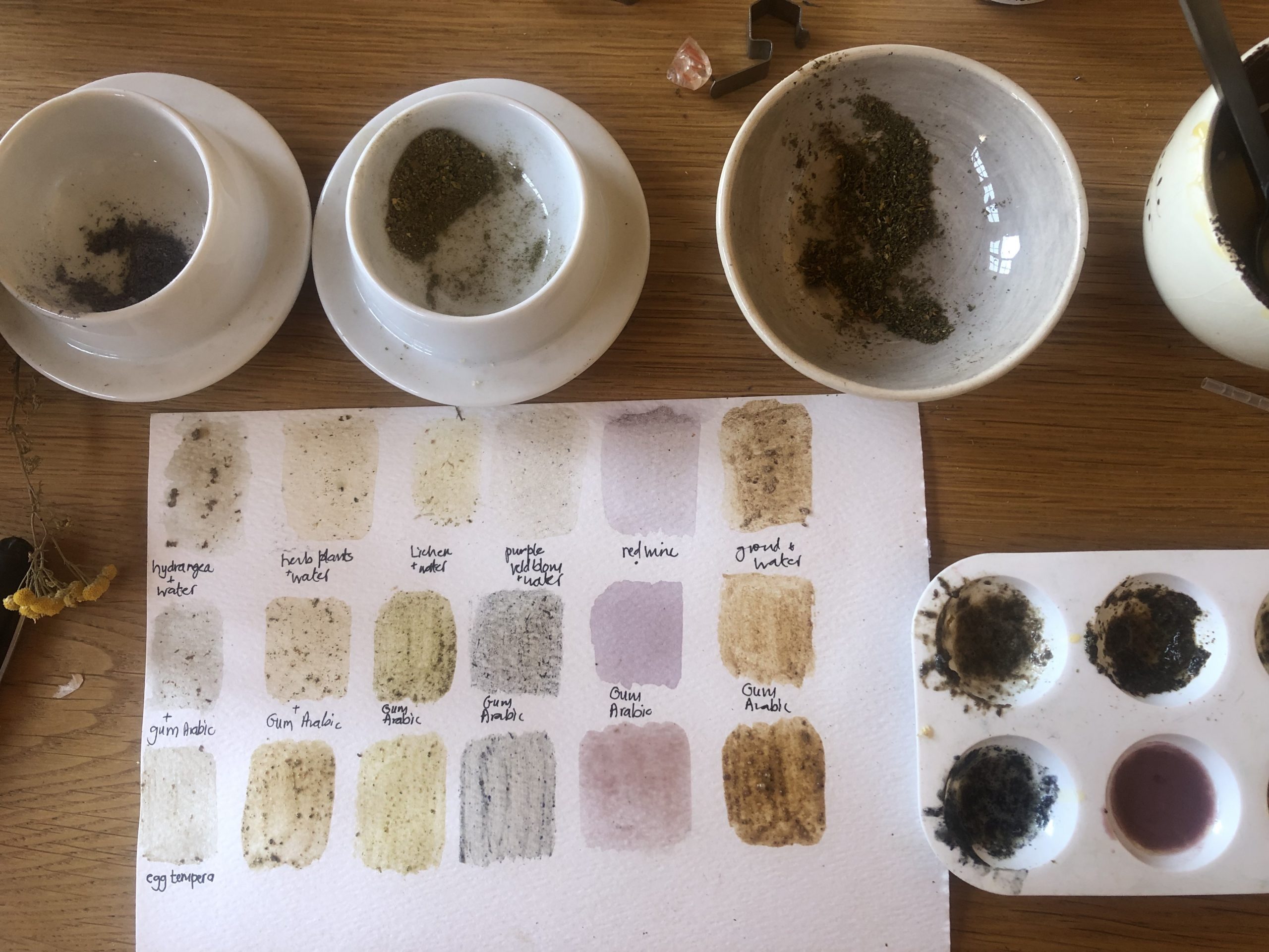
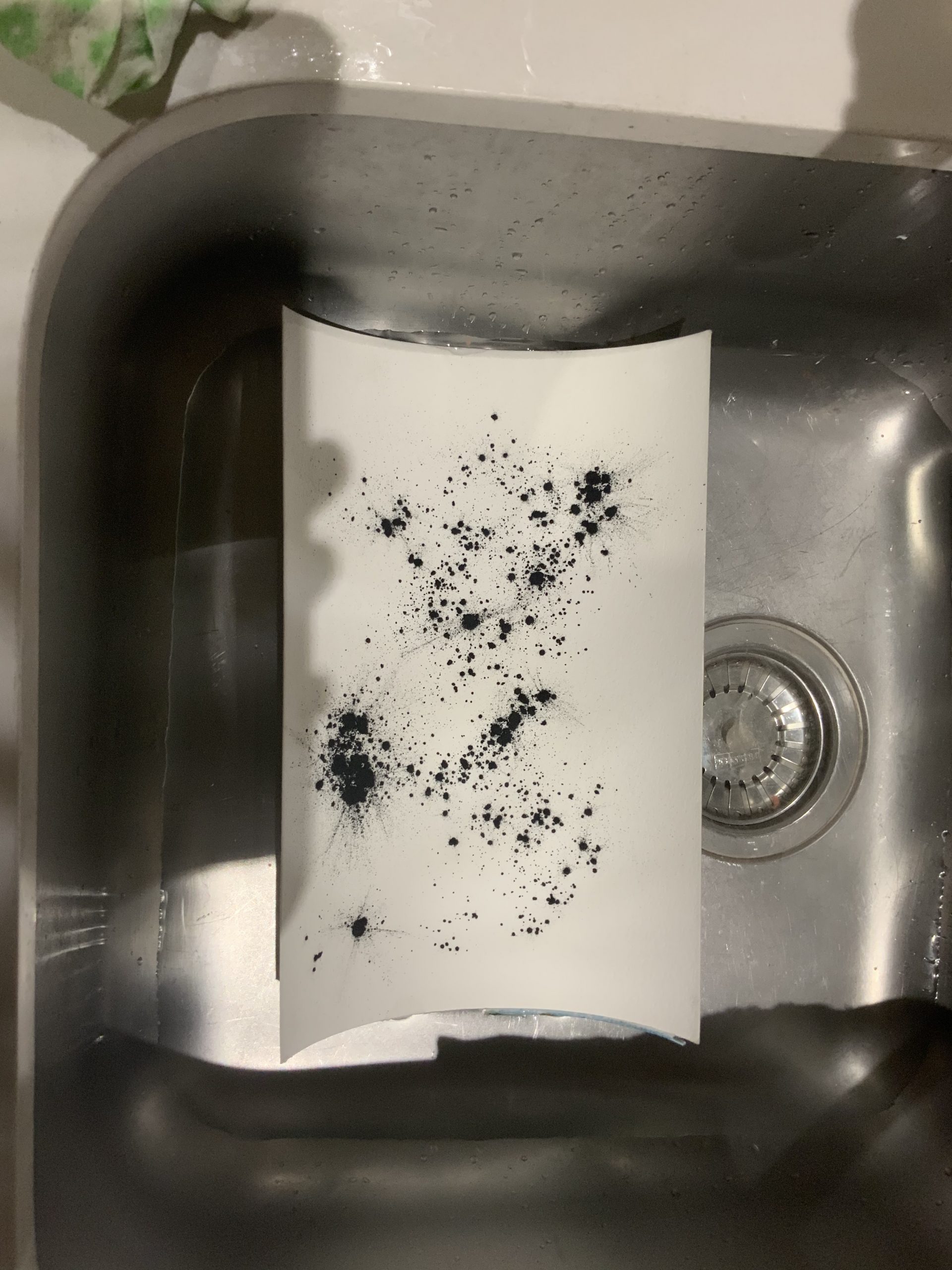
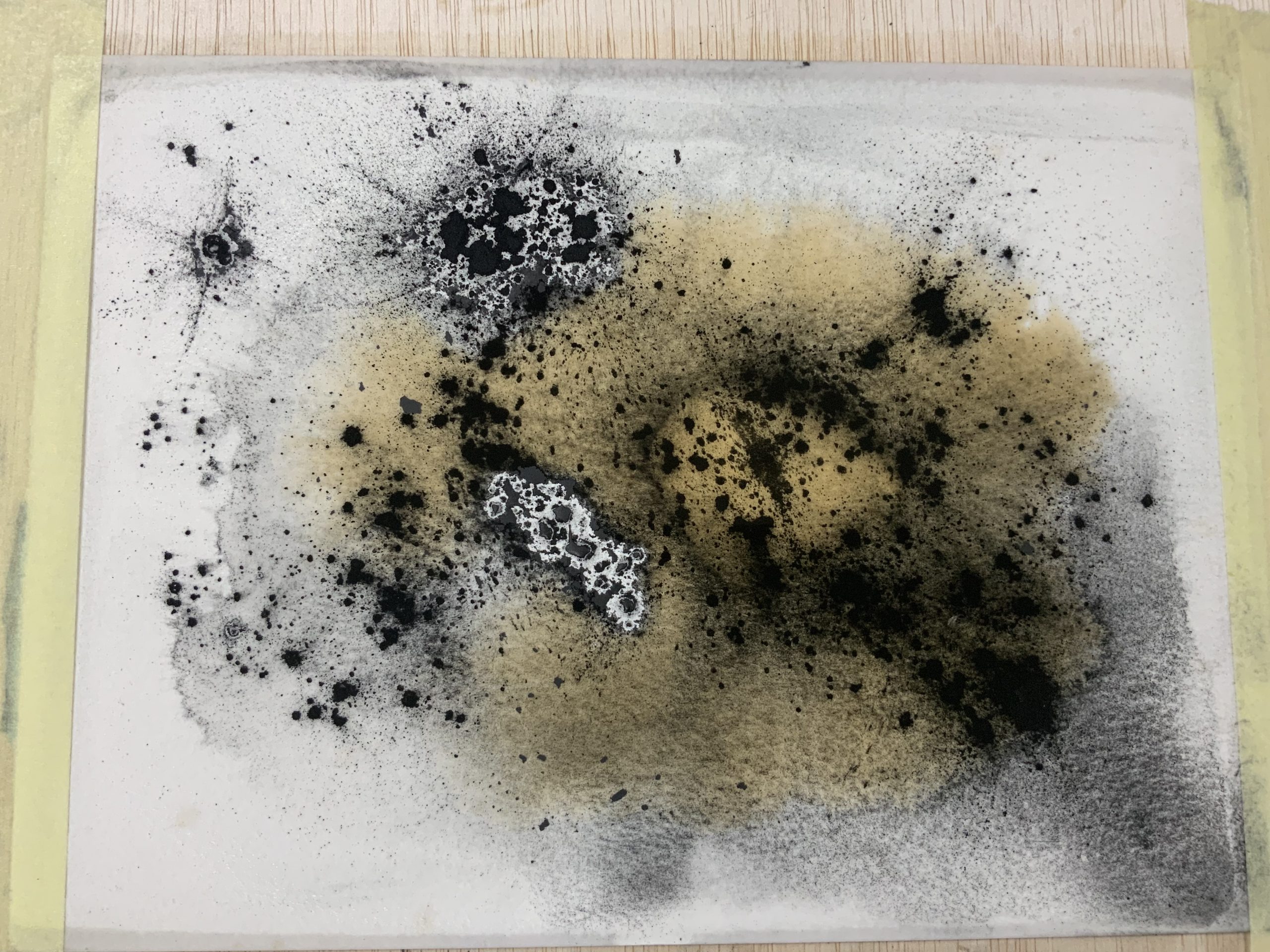

As part of Project 4, Painting without Paint in Part Four of course I tried to find natural pigments as close to where I live. I could consider using plants such as beetroot, red cabbage, spinach leaves, onion, and the spice turmeric. On a local weaver’s website, I found images of using natural dyes from lichen, ferns, and other leaves. I also started following ‘botanical colours’, a group of artists, on Instagram after a lovely image was shown of dyes they made from the Velvet-footed mushroom (Tapilnella atrotomentosa)- it is possible to order dyes from them, they share recipes and books on this topic.
In our tutorial discussion about the work I did in the course around Part 4 my tutor commended my strong ideas which were developing as well as the range of media and processes I have been exploring in my making. It was suggested that I record this making process and learn more thoroughly. She found that I was skipping over my process, and did not show this layer in my research. Thinking about what I was doing, I focussed on outcomes, namely that I could create organic shapes reminding me of mycelium and or mushrooms and fungi and that I became interested in thinking about resolved work. My visual research into the Fungal Kingdom influenced how I made images with the materials I have been exploring – it became clear that in the process of making I found relations with the research in the PP. I was also becoming increasingly aware of my entanglement with fungi and how I will need more time to explore this. By now I recognised that I would like to explore this as my body of work into the last part of my studies.
I find that the PP is giving me the opportunity to learn about my own creative process, how I develop ideas, and create, record, and analyse them. I could start using the learning from practical making sessions with OCA tutor/head of fine arts, Caroline Wright when we worked with pigments and later with egg tempura. It opened up materials and how I could use them in my making. I prefer the naturalness of these materials.
MUSHROOMS AND MATERIALITY
I had an interesting conversation with an artist friend about our joy to visit nature and the ‘need’ to be surrounded by beauty (which nature always provides, we are keen birdwatchers, love trees, fynbos, plants, and animals of the wild) and that art and science find links in our work. I like to think it is about understanding; we need to investigate and experience this understanding in our making process.
Below is a work I found whilst researching online. The artist is Anne Carnein and here she worked with textiles and wire. I love how the work shows the ‘underground growth’ of the mushroom as it becomes a sculpture.
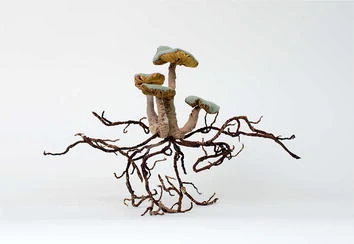
I am positively influenced/inspired by my fellow students reading Sheldrake (Entangled Life) alongside me, as well as our meetings with regard to this reading. In the group, there are scientists who explore their creativity alongside (textile and creative arts pathways) me and I think the cross-contamination is such a productive space for me to move in alongside them. When Annette and I looked at locating a title for our collaborative digital work, she referred to the work as ‘involution’. This word was introduced by the anthropologist, Natasha Myers (later I read of her in Sheldrake’s book.) I think what I am understanding is how we can use language to explore the non-living on its own terms, by reimagining ourselves to the non-living. It could also be seen as a form of reciprocal relationship and a co-becoming. In my case I look at fungi and hopefully also at lichen and that the resources I will be using lead to mutual benefits, being me and my community I see myself working in, but I could also see it as part of being in a student group or artist collaboration. I
Later when our reading group continue with the reading of Entangled Life (Merlyn Sheldrake 2020) I get to consider my thoughts on the concept of the fungi I started with earlier in this blog. Sheldrake names his last chapter, Making Sense of Fungi (2020: 225-247) and here I ponder about the following comment he makes: ” The ways in which we try to make sense of fungi often tell us as much about ourselves as the fungi we try to understand.” (notes added on 12 August 2022)
It is clear that there are many metaphors for mushrooms, that we made it anthropomorphic, or as Sheldrake writes, ‘mycomorpnic”, but this refers to language, which has its limits. I feel art has so much more to explore if we use our imagination. I can look back at my learning experience with the WWW project in the OCA EU student groups as a symbiotic space where sharing happened across boundaries. My own research became very much fungus-like as I researched, walked, searched, found, connected with and looked at fungi in new places, made spore prints, talked to others, and wrote about it. I do think this left quite a complex trail (ideas in my mind) I could use to develop my practice and consider how fungi became part of my thinking and making, and that more possibilities opened up over time.
Book, Among the Mushrooms. https://archive.org/details/cu31924000476113/page/n29/mode/2up
LICHEN AND MATERIAL
The found log I used to innoculate the Reishi mushroom dowels I ordered earlier, became an inspiration for a painting as I waited for the weather to cool down before I could insert the dowels. I worked with oil paint and added impasto medium to the paint to create a textured effect for the tree stump.

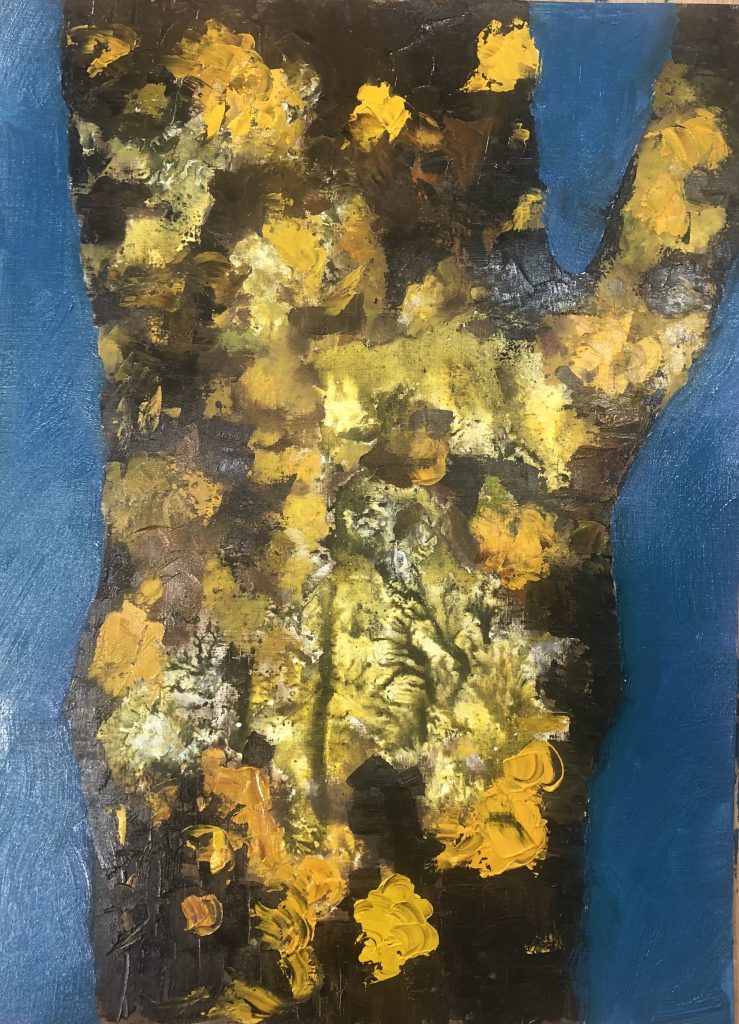
The painting of the log with lichen inspired me to go back to a self portrait I have made earlier and do more work on it.
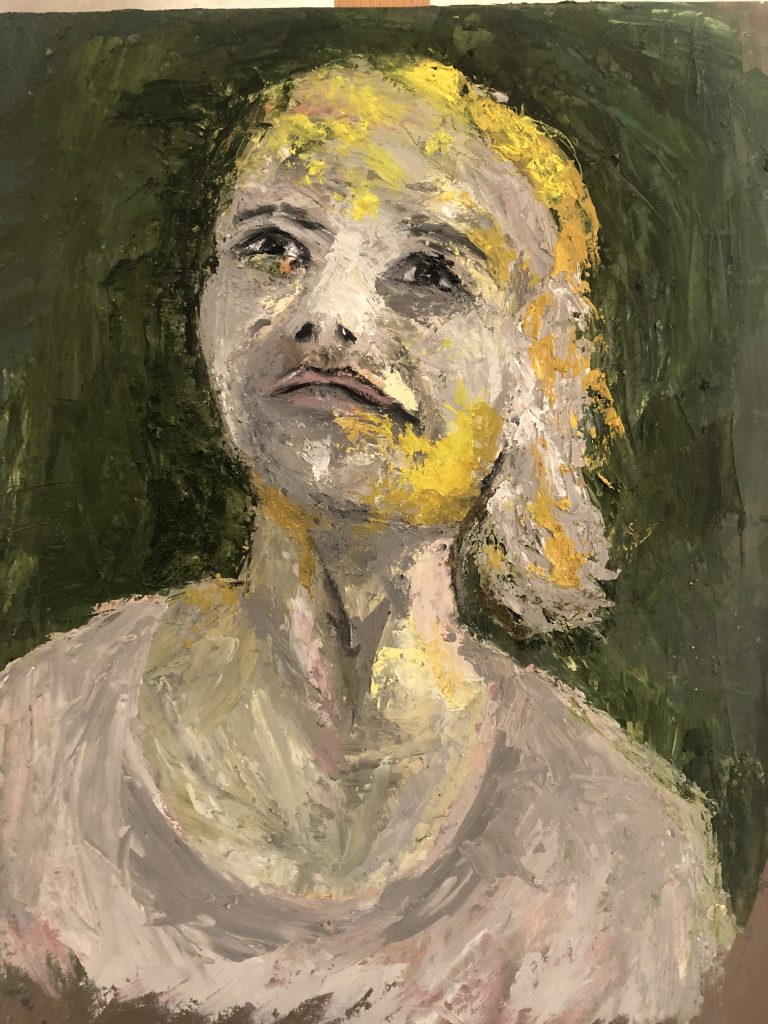
I cannot help but wonder: what if I try to innoculate the work with mushroom spore and keep it somewhere dark for a while?
MAKING WORK AS A COLLABORATIVE EXPLORATION WITH FUNGI
Part two of this project discusses the process of making with Annette Holtkamp, a fellow student in Textiles at OCA.(https://karenstanderart.com/parallel-project-for-studio-practice-part-2/)
Considering human-nature collaboration
I would call this part practical research-based work. I bought my first ‘starter pack’ (7 May 2022) to grow oyster-type mushrooms. The idea was that if circumstances were fine I could have edible mushrooms within 5-8 days. I shared the process on social media – mostly with images showing the daily growth and sharing process. The ‘log’, or the host, was made with woodchips and bark and tightly sealed in a plastic bag. It is covered with mycelium and the bulging growth was visible. After soaking it in water for about 15 minutes I made a small cut where I saw some bulging, which is the growth. The growing process started on 10 May 2022.
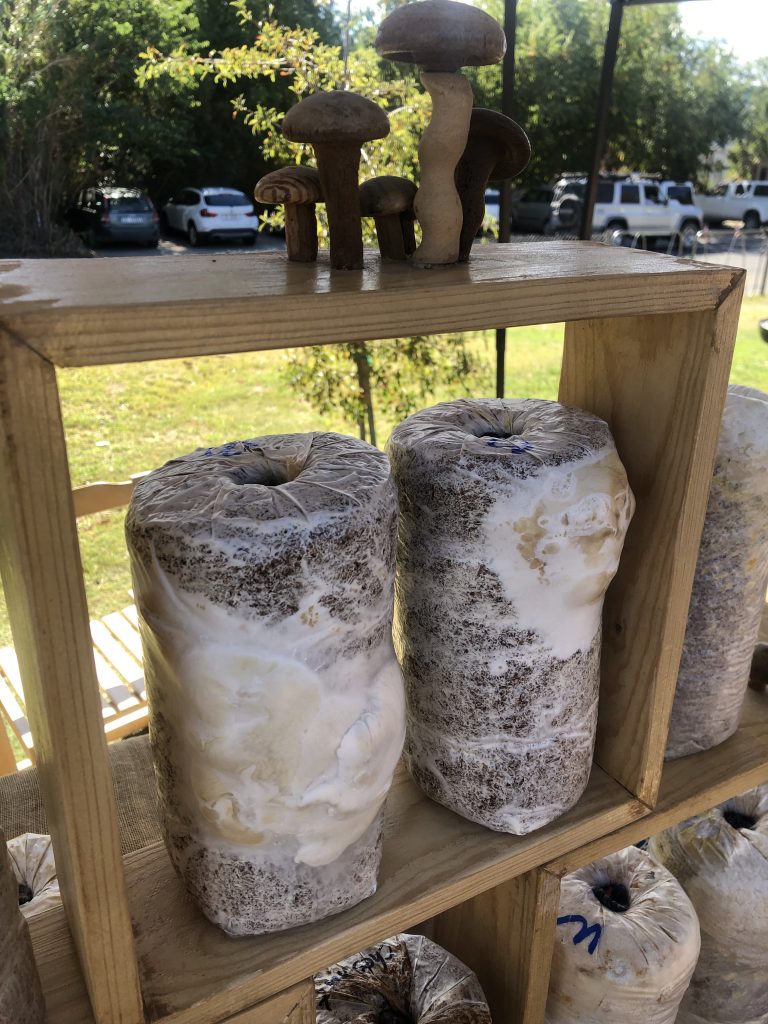
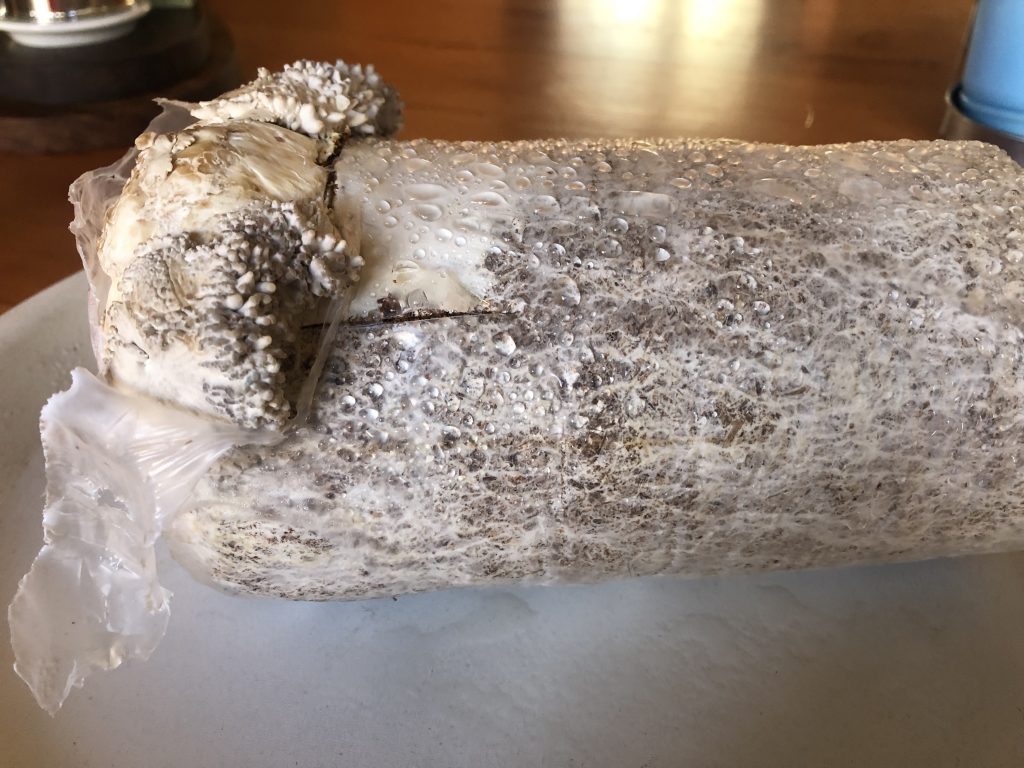
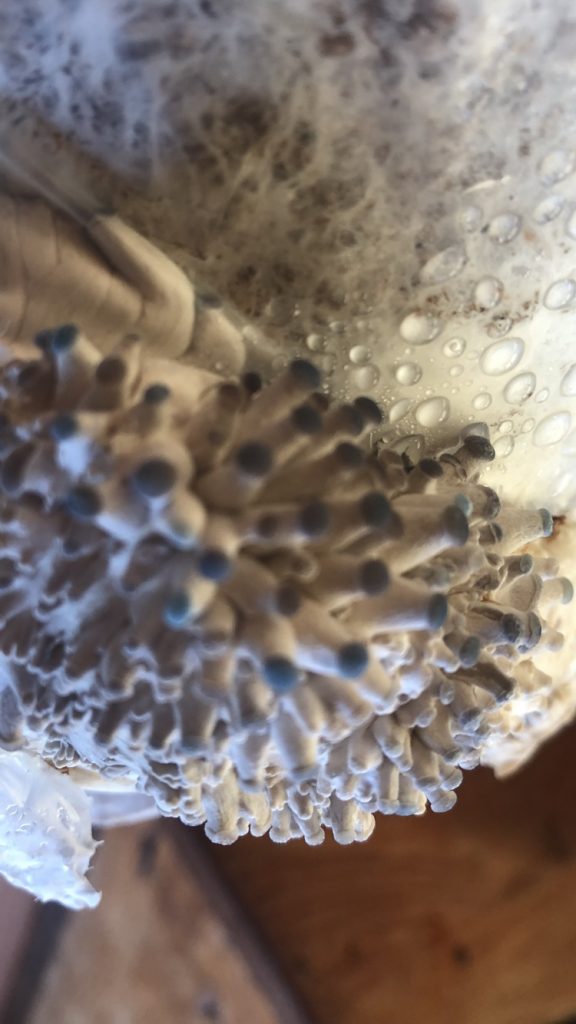
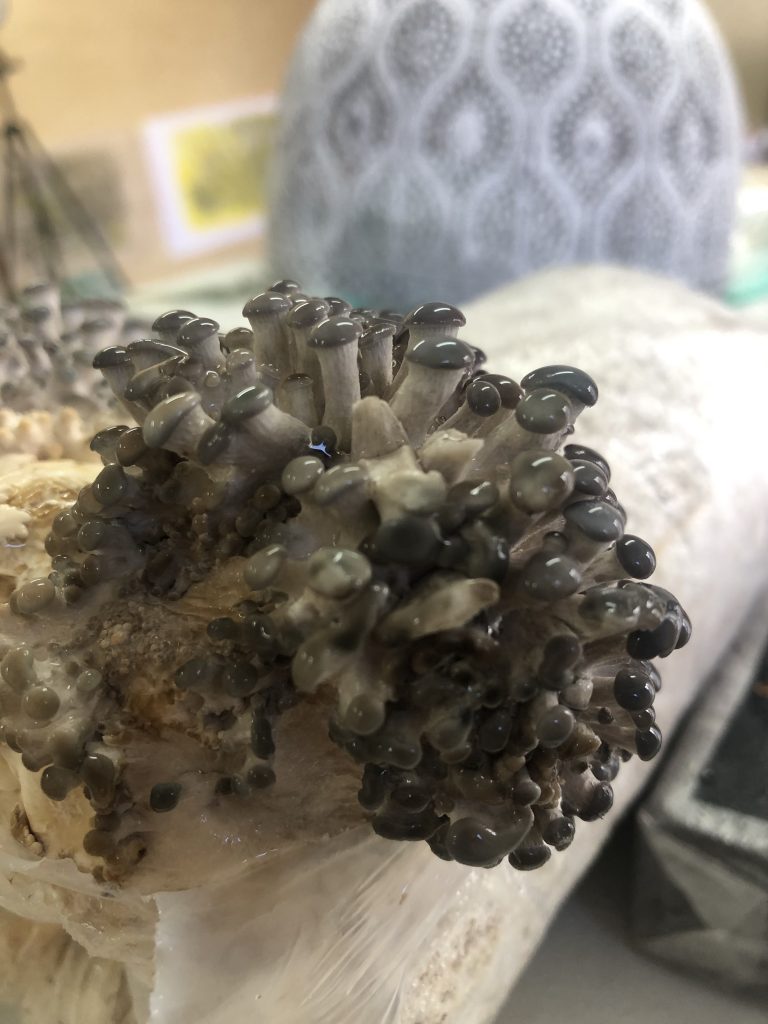
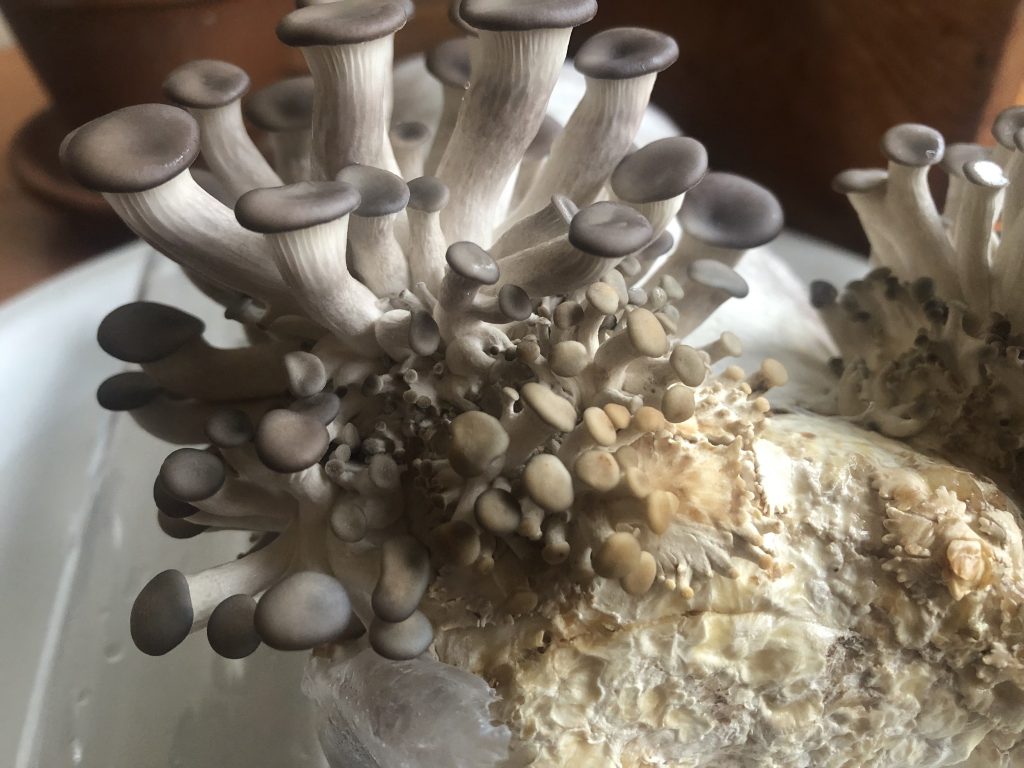
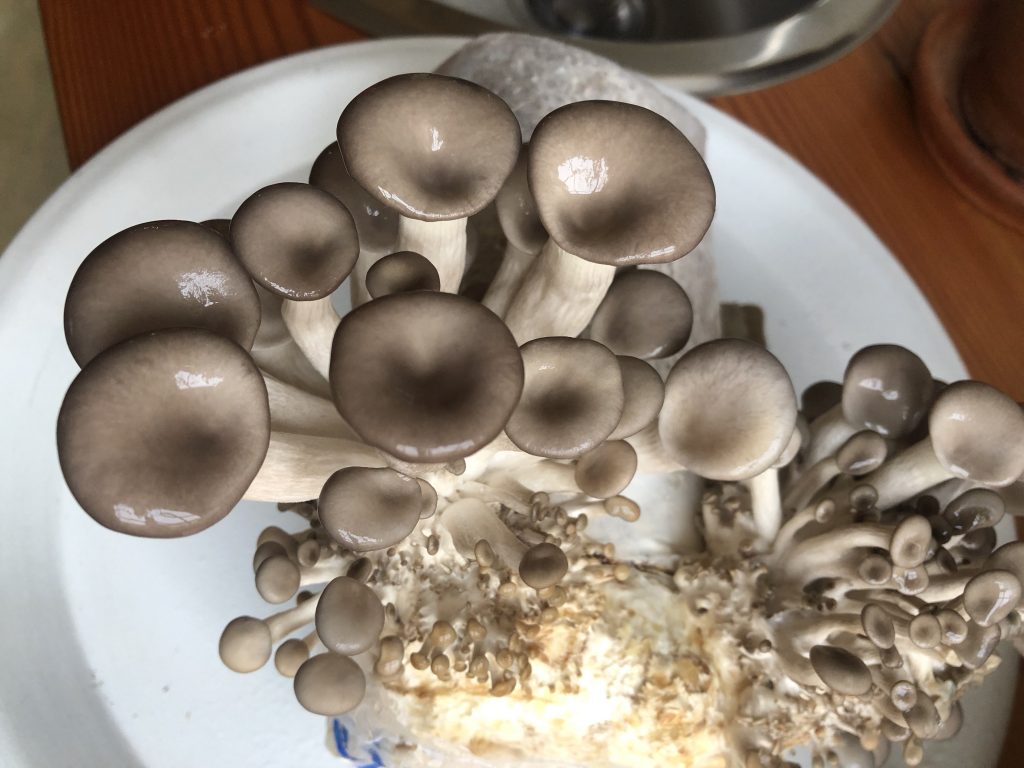
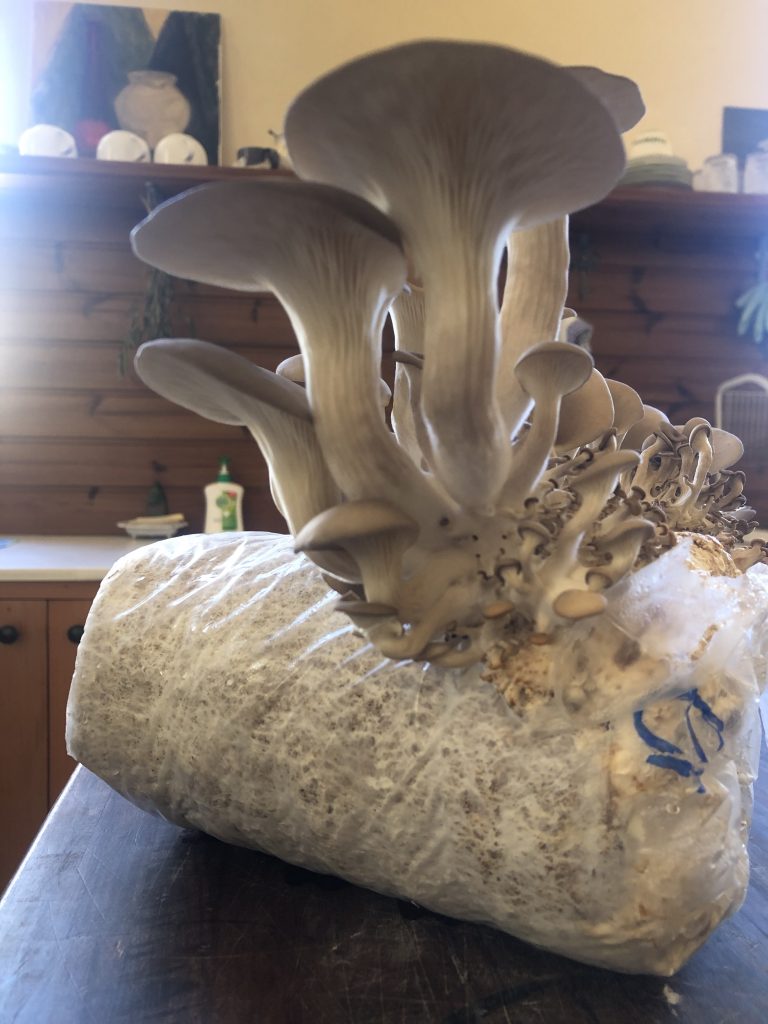
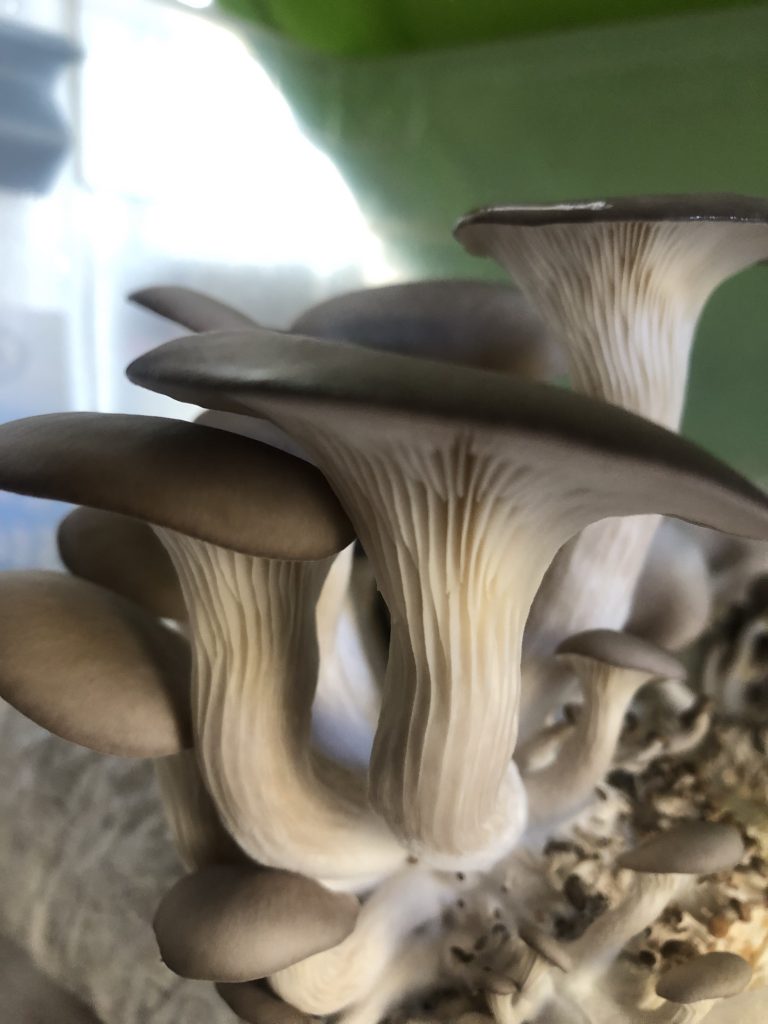
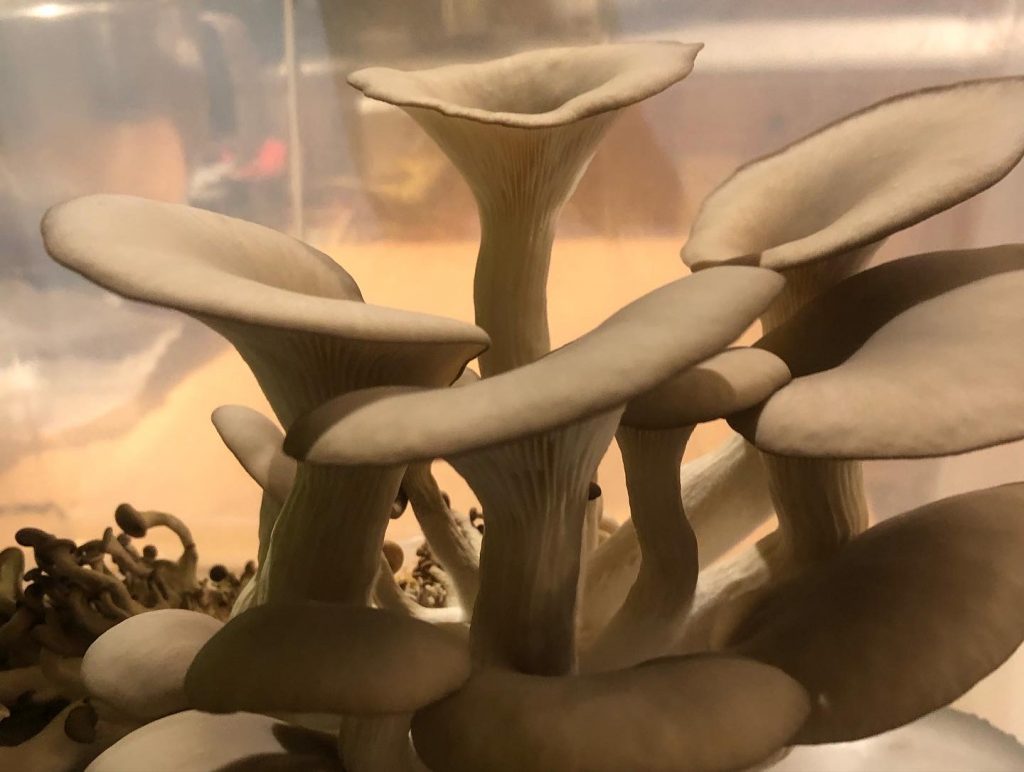
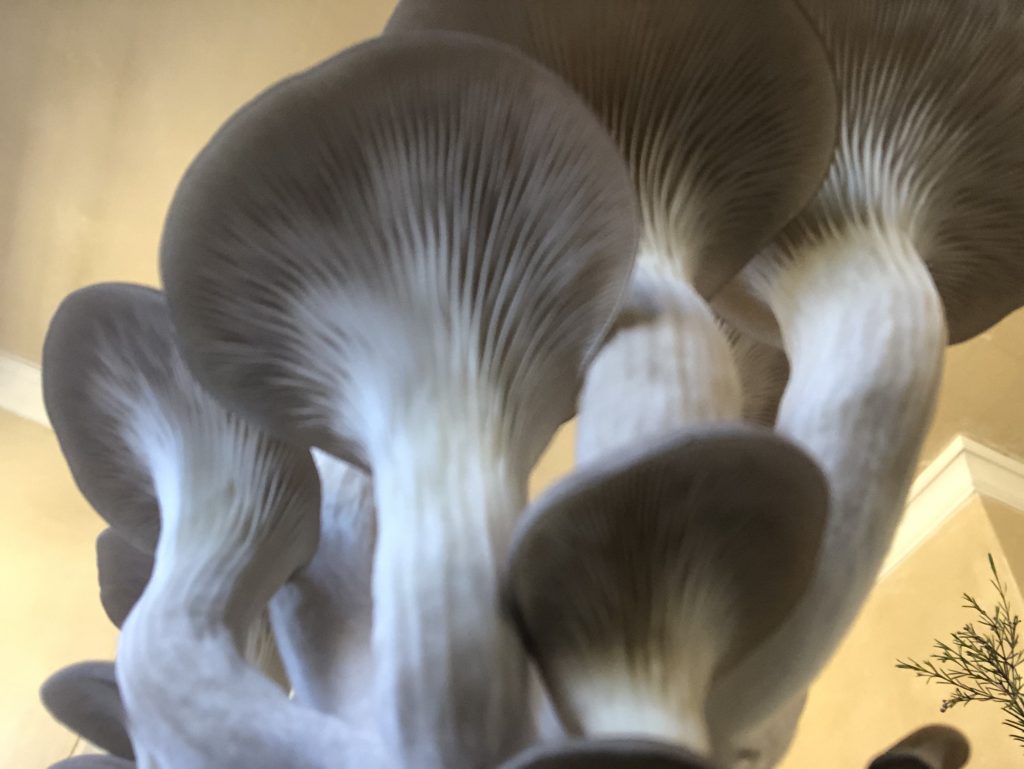
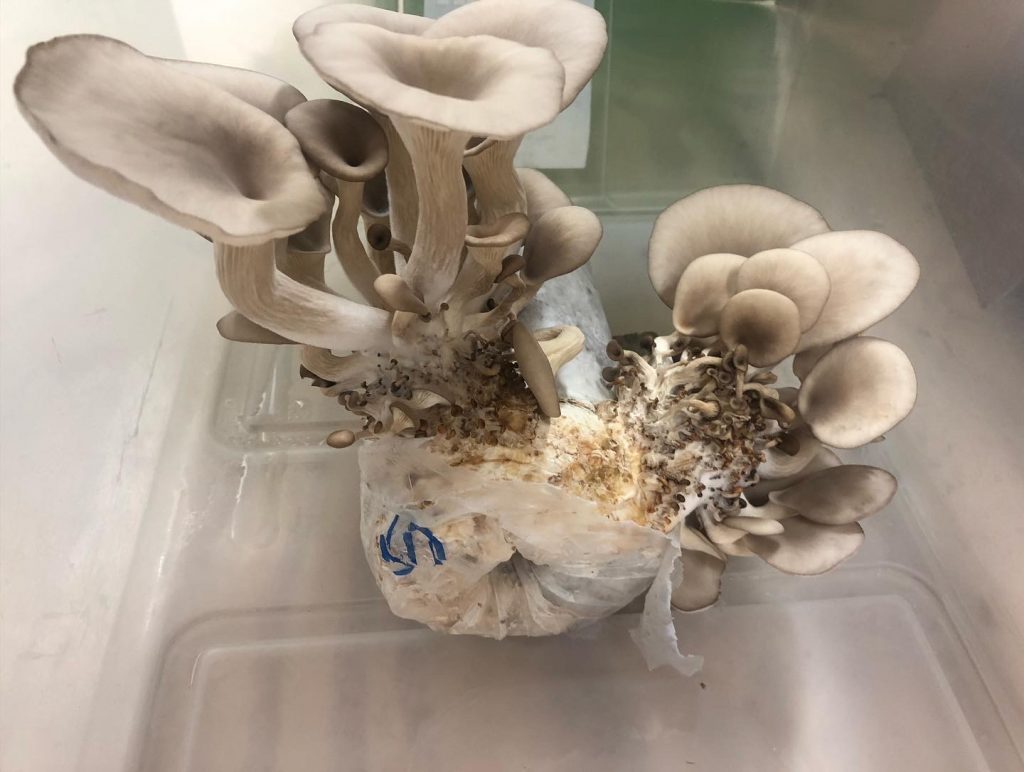
For the next 7 days, I sprayed the growing medium with small mushrooms blooming, regularly with water, not allowing it to dry out. Soon the mushrooms started showing and the growth over the next 8 days was an exciting and wonderous process to follow. The daily sharing on my social media grew into good interactions with followers and I made new connections with people with similar interests in art making and working with mushrooms. My experience of this growing process made me aware of how many people are interested in mushrooms, not just as food. Comments on the beauty and captivating process were good to read and interact around.
On 16 May we prepared to cook our first homegrown mushrooms. Inspired by the growth of the above mushrooms, I did a mushroom study with charcoal and soft pastels and wanted to spray water onto the work. When I started cultivating my own oyster mushrooms, I had to spray a mist of water regularly into the growing mushrooms, to create a type of highly moist environment which encouraged the flowering and fast growth.
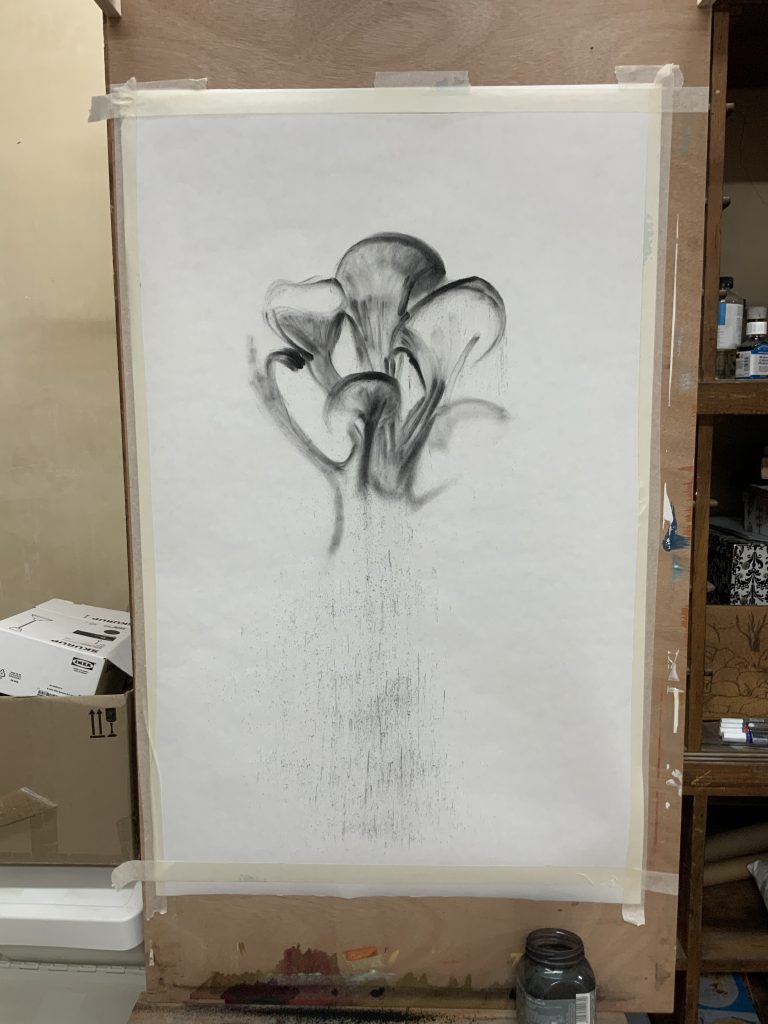
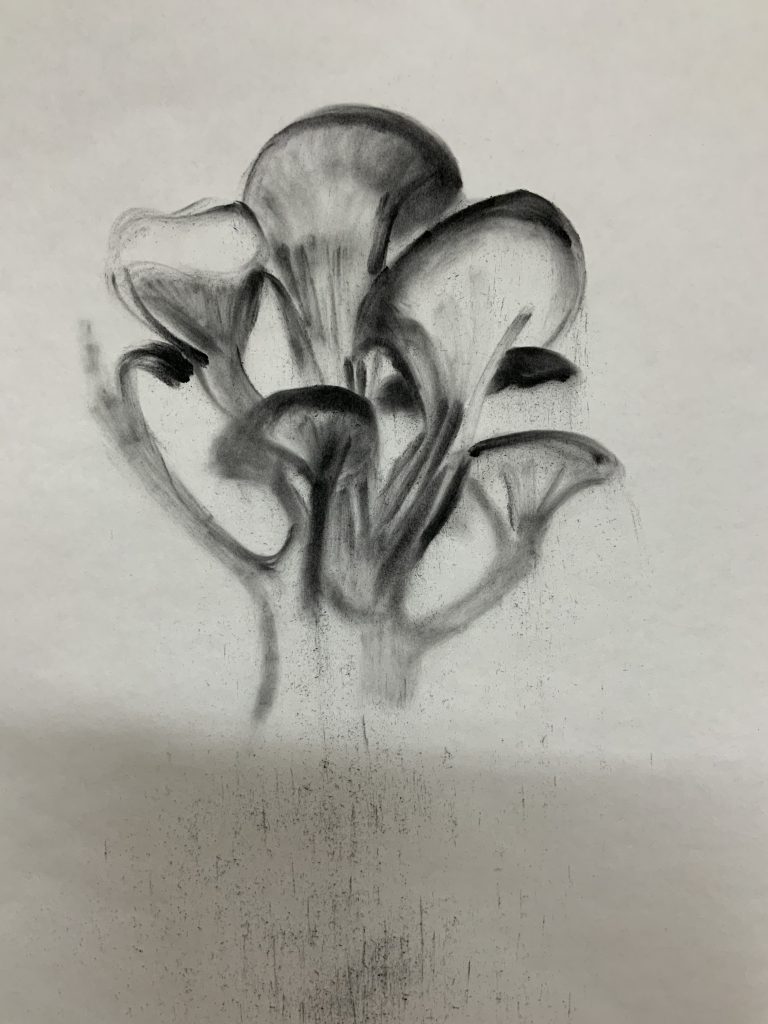


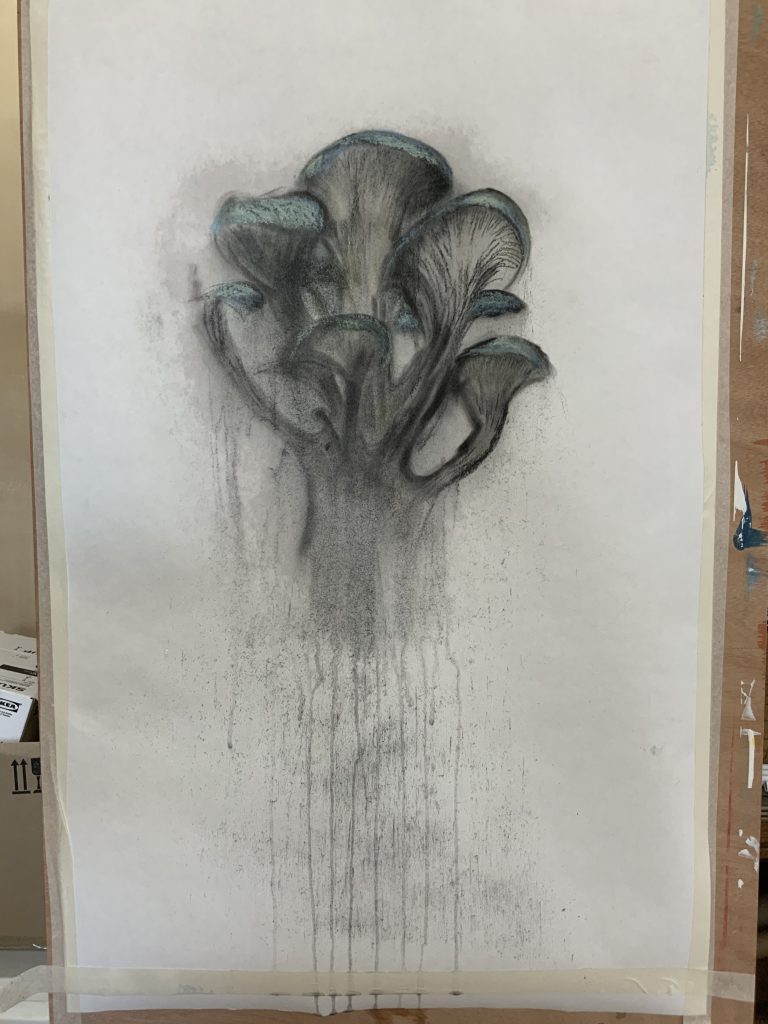
By now I was also starting to get a vision of sharing and documenting more of my learning and experiments, with an exhibition of some sort, in mind. I have prepared some growing medium with coffee, rice and wheat, as well as with paper. I feel it is important to state that this was a moment when I realised I need to continue with this project into level 3. I share a work of artist, Cornelia Parker, with the idea of it being a reminder of these thoughts I had and not to lose my dreams and momentum. This installation is part of a current exhibition at Tate, which started on 18 May 2022 which I saw on IG) This greenhouse has been painted on the inside with chalk from the White cliffs of Dover, and is titled, Island. I learn that this artist is always working in collaboration.
I can visualise my little greenhouse as a space of exhibiting in the future. I do like the idea of it being like a little herbarium and I would use light to display it.
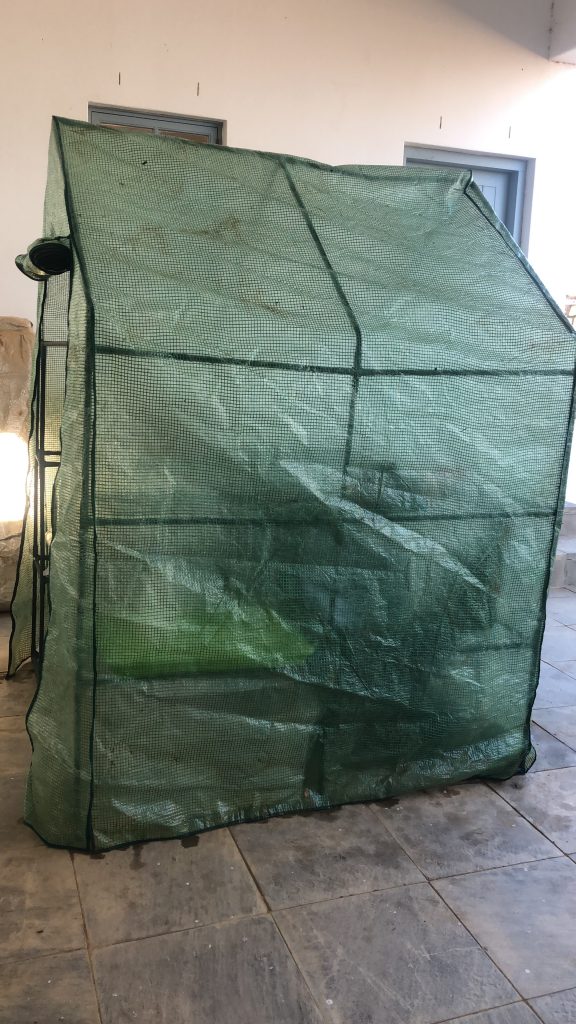
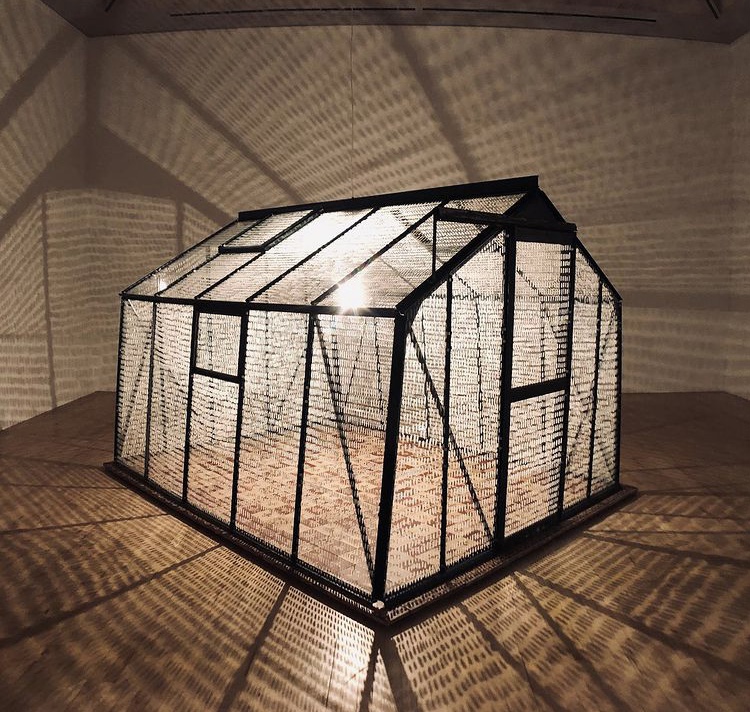
In Part four, Paint as Material and at Parts of a painting, I started looking at making acrylic skins and in this way exploring the paint as a material in its own right to articulate surface and that begins to describe form.
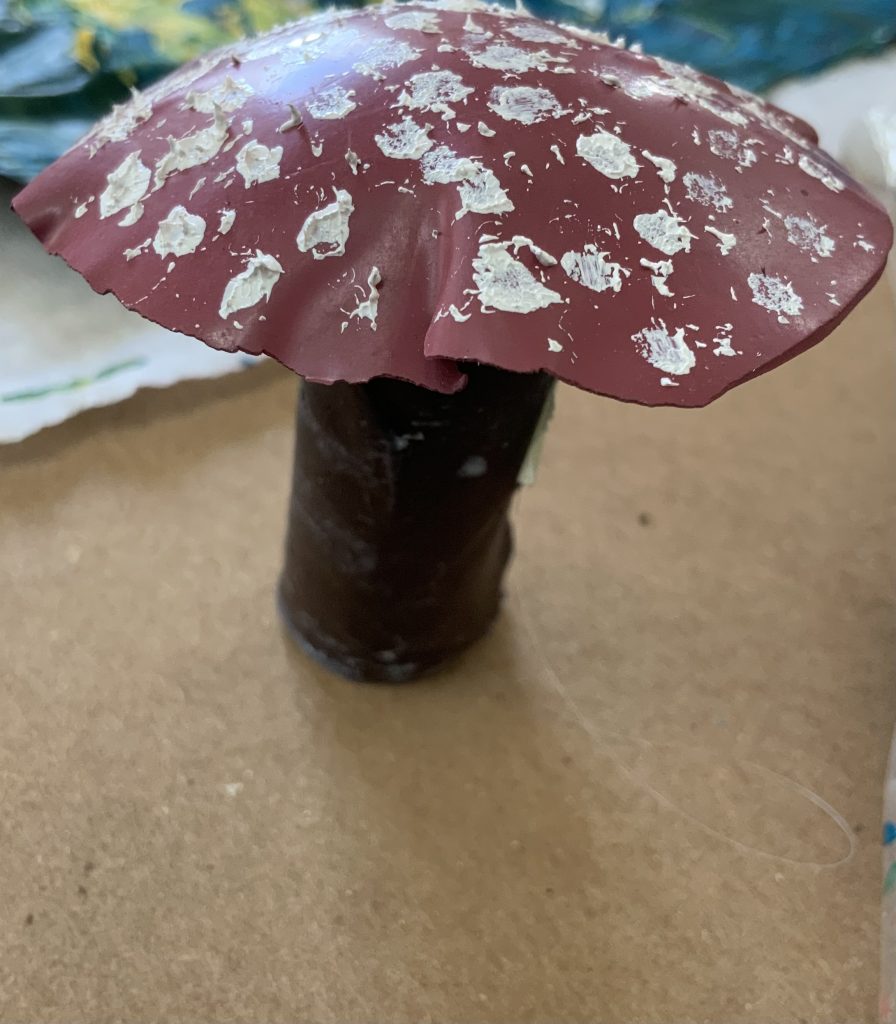


Merlin Sheldrake continued to be influencing my thinking and making. I have started to follow his YouTube channel and I learned that he has used a copy of his book to be devoured by Oyster Mushrooms. This opens ideas for our collaborative work and how we can deconstruct it after the exhibition. I start to research possible options to consider.
I also think of the choice of material I work from and feel strong to develop my own mycelium and create forms/objects. During these ‘brainstorming’ times to think about my making, I became more aware of the relationships I think about, namely between that of nature and my own art-making, about arriving and leaving, life and death, life and culture as well as the real and the imagined or fictional. Looking at this making opened my ideas to how I could use a surface to grow mushroom on and that could be part of a body of work for this part of my course
Documenting the artwork with growing mushrooms
I do believe my process of growing mushrooms at home, opened the way to cultivating my own relationship with fungi. I experimented to use coffee grounds, rice and grain, and wood shavings as growing mediums and explored more cultivating, by growing other species of edible mushrooms over the next weeks.
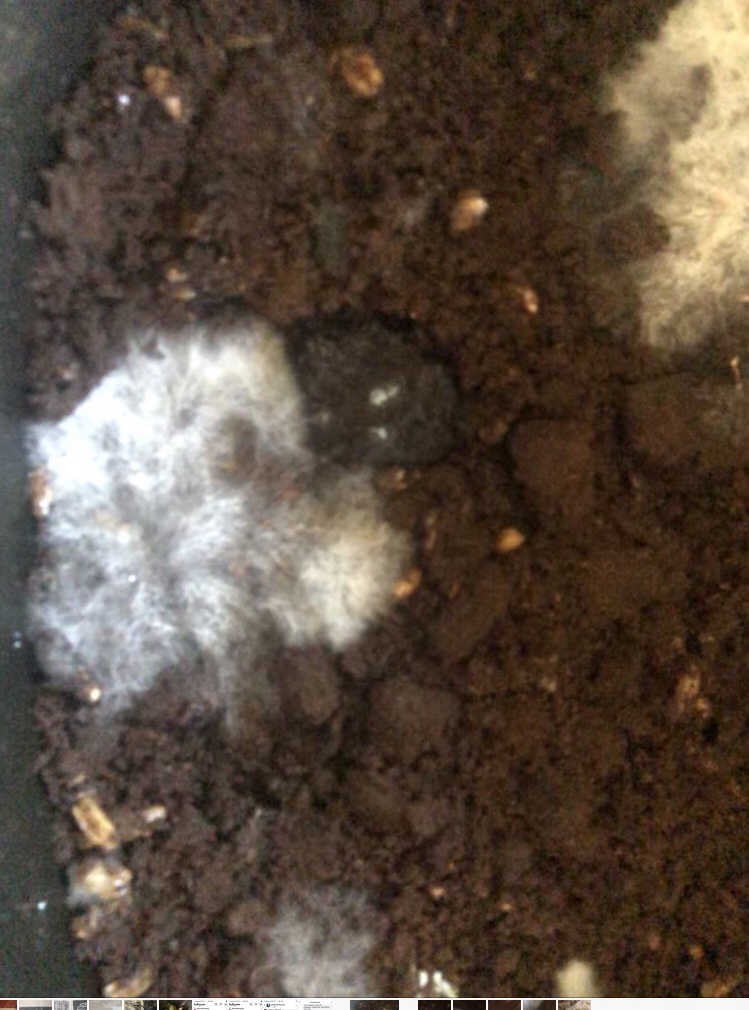
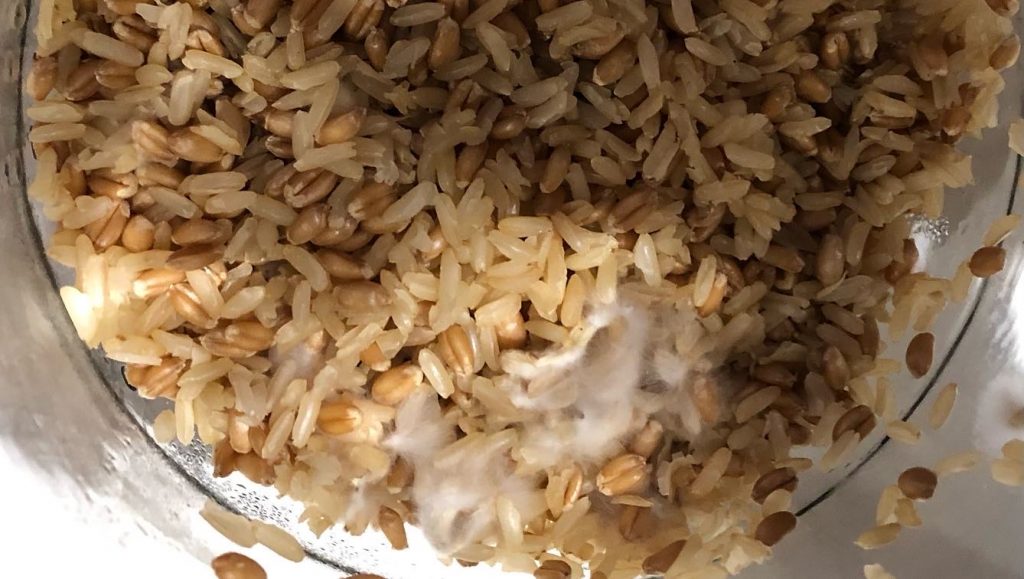
The log was inserted with the reishi dowels and placed in a shady and wet place outside my studio.
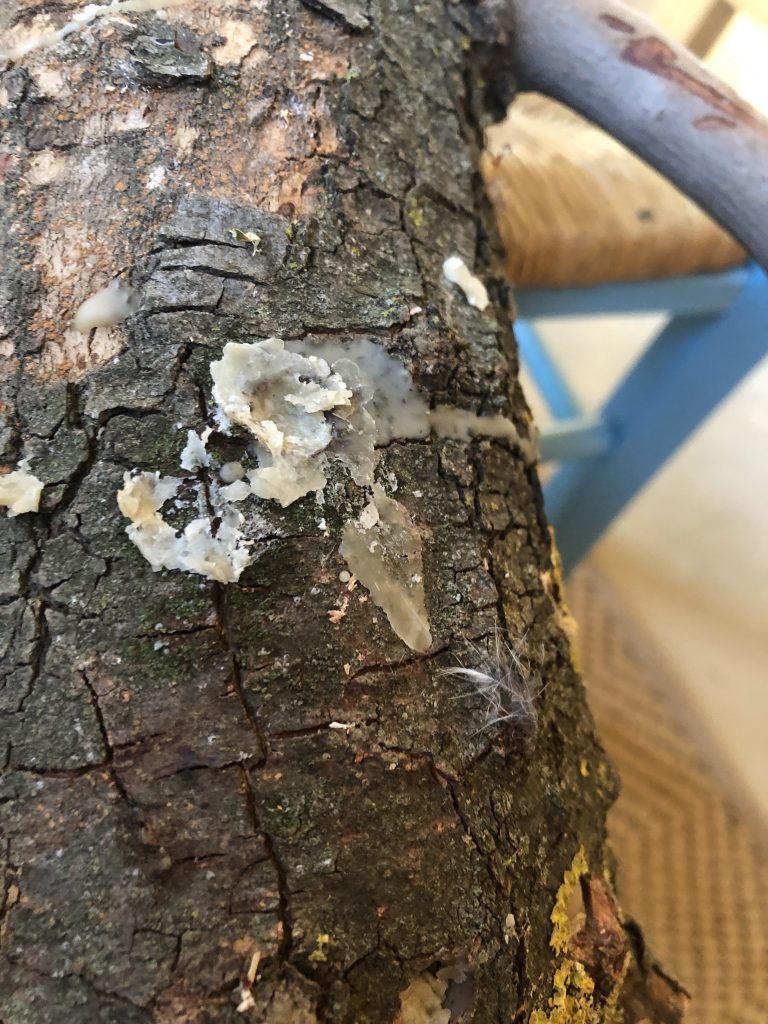

Deconstructing with fungi
This led to exploring my own work to be used as a ground for the mushrooms to grow on. I had to add other growing mediums onto the sterilised straw. In the conversations between Annette and me, it became clear we wanted to place our collaboration objects back into nature after the planned exhibition comes to an end. As a final stage for our collaborative project with the OCA Eu group, Annette and I decided to deconstruct our work; but the mushrooms have to do this part of the work. I could arrange that her parcel with made mushrooms is sent to me by a family member who was visiting Europe from late August to early September 2022. The outcome could be to explore it as a place/space where we could later have the works decay and or consider each other’s environment when bringing the separate works into one. We live in diverse areas and it would be interesting to see how this can develop. When we had this discussion earlier in 2022 it was becoming warm in my area and even my veggie patch outside my studio looked less and less like the place you would search for a mushroom, but I do believe the mycelium is doing its work underground. In Europe, it is a cold season.
On 11 June 2022, I placed a small printed copy of the digital collaborative work between me and Annette Holtkamp (to be used in our online exhibition) on a growing medium inside a plastic container. This would me my ‘trial’ for our final work. I kept it dark for the mycelium to flower and started spraying it regularly with water. I made small incisions where I could see some growth in the mycelium trying to come through the artwork.

On 12 June the first Oyster mushrooms started to push through the work.
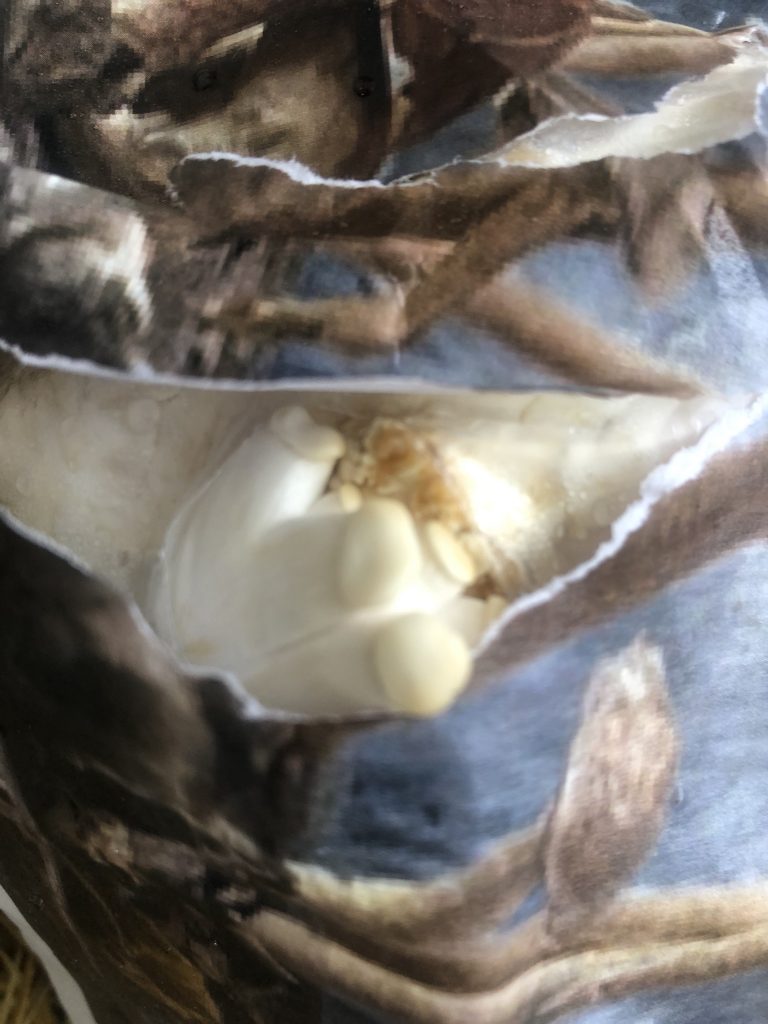
On 13 June one could see the caps of a second variety starting to flower in a light brown colour, and they turned darker over the next days.
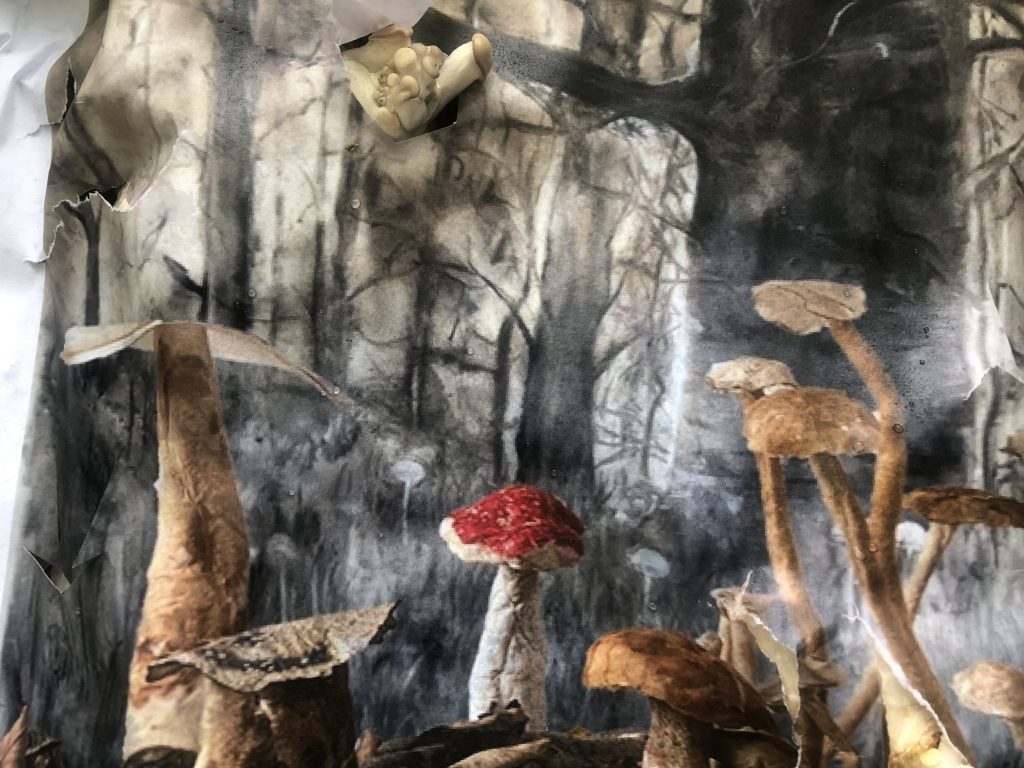
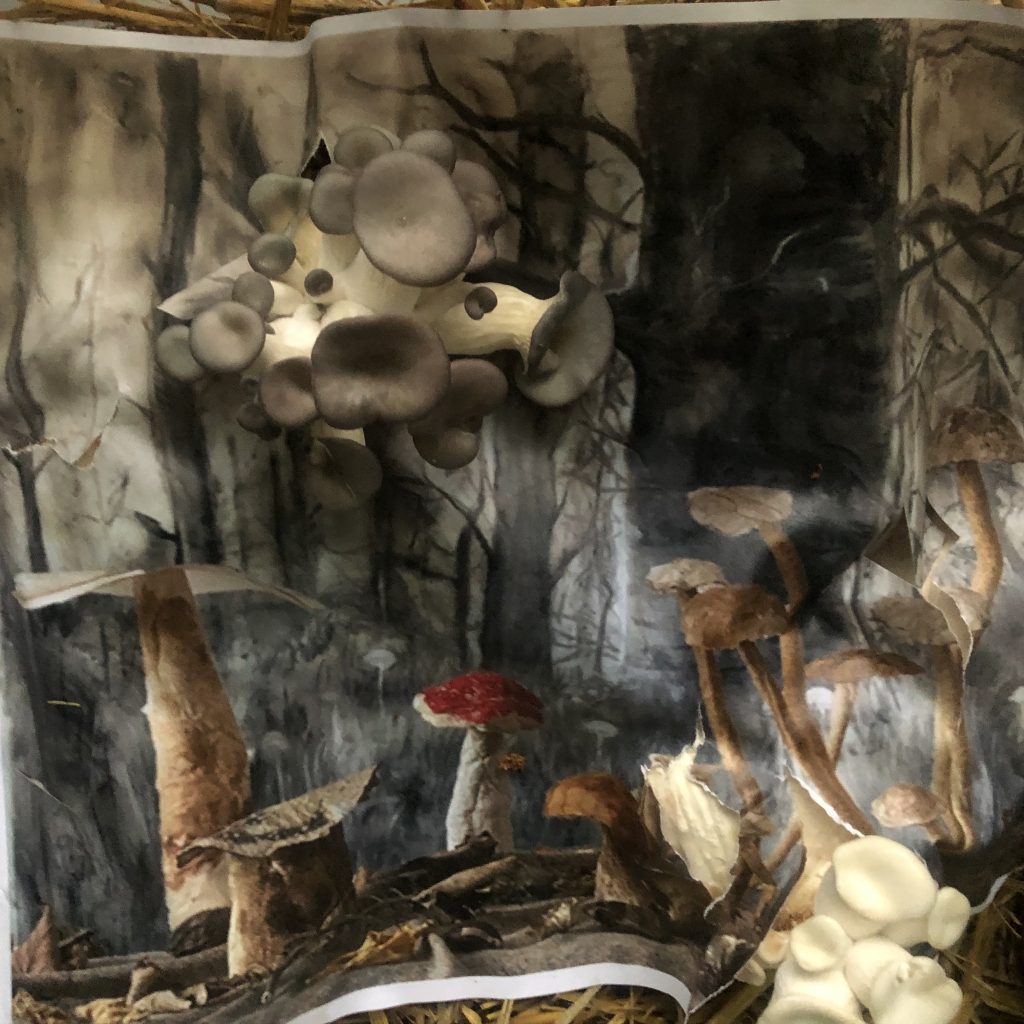
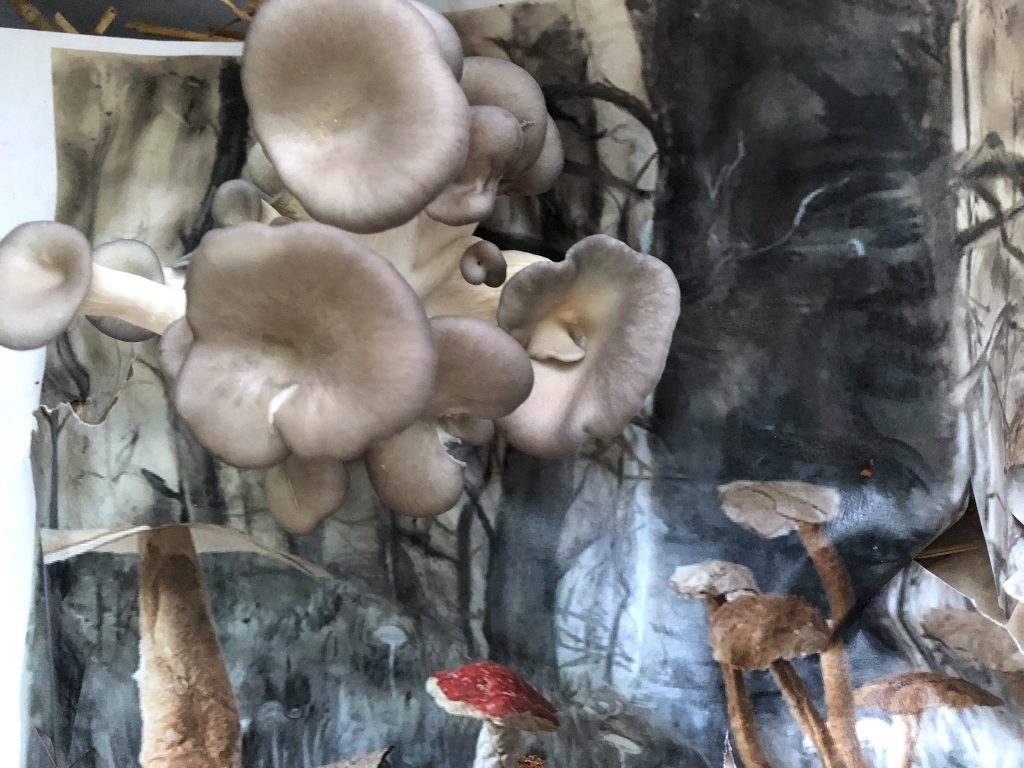
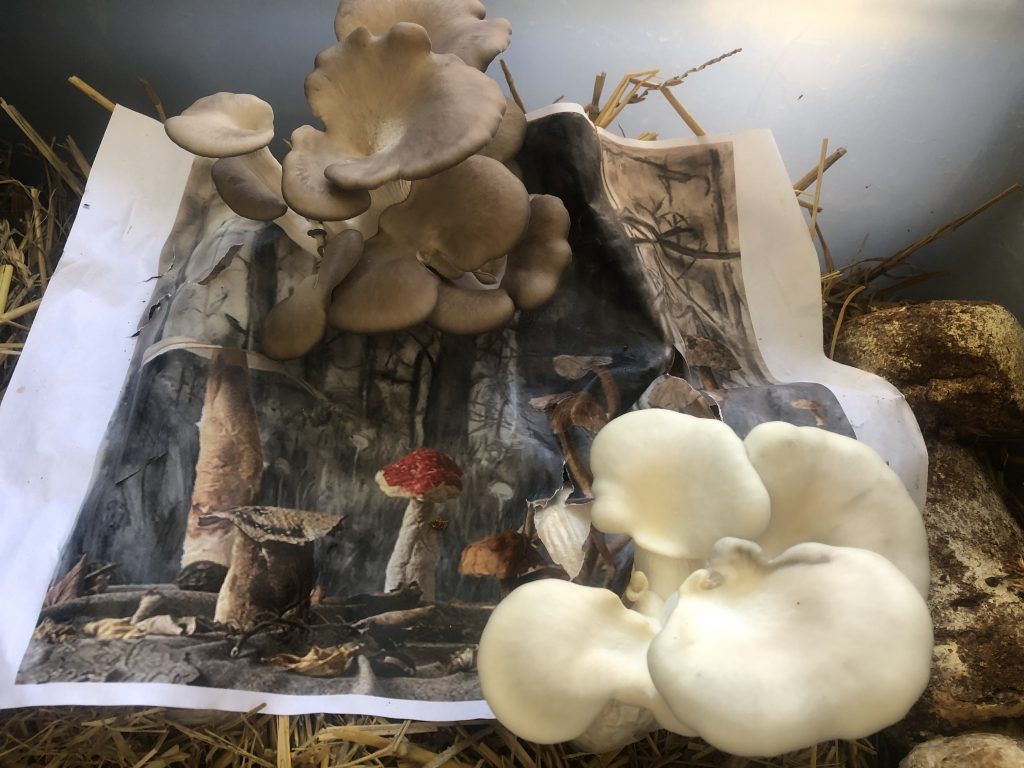
On 20 June these mushrooms were harvested and ready for eating. We made a risotto dish and added the fried mushrooms. I kept the work on the medium to see how this will develop over time. The work was kept wet and moist and soon started to become very fragile.

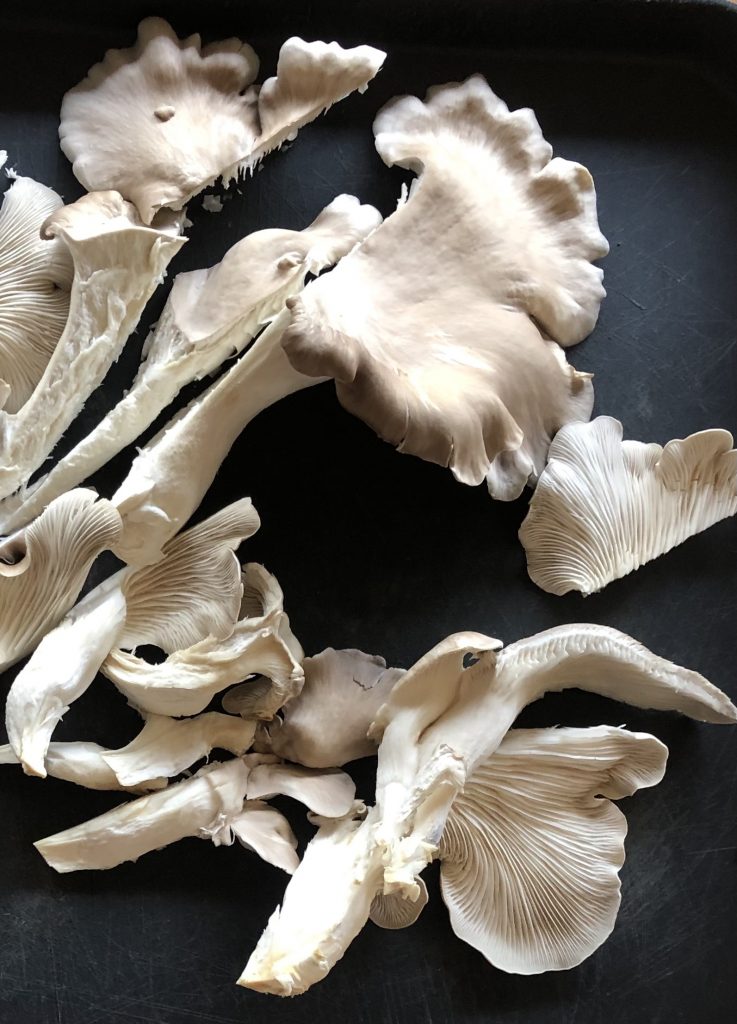
I continued to keep the work on the growing medium with the intention to grow more mushrooms into the paper. This caused the work to become wet and hopefully also get spores onto the surface. I understand this work to be a long-term process of growth and eventually decay. Reflecting on this process one does think of death and decay, role mushrooms play in nature, but it also made me consider where this work really stands as art. It started as separate makings and then ‘morphed’ into a digital work in a digital space. The process I shared here is a type of simulacrum of the reality of artists working in collaboration, but removed over space or distance and work never really coming together. It is also a story of deconstruction and the role of mushrooms in the process of decaying.
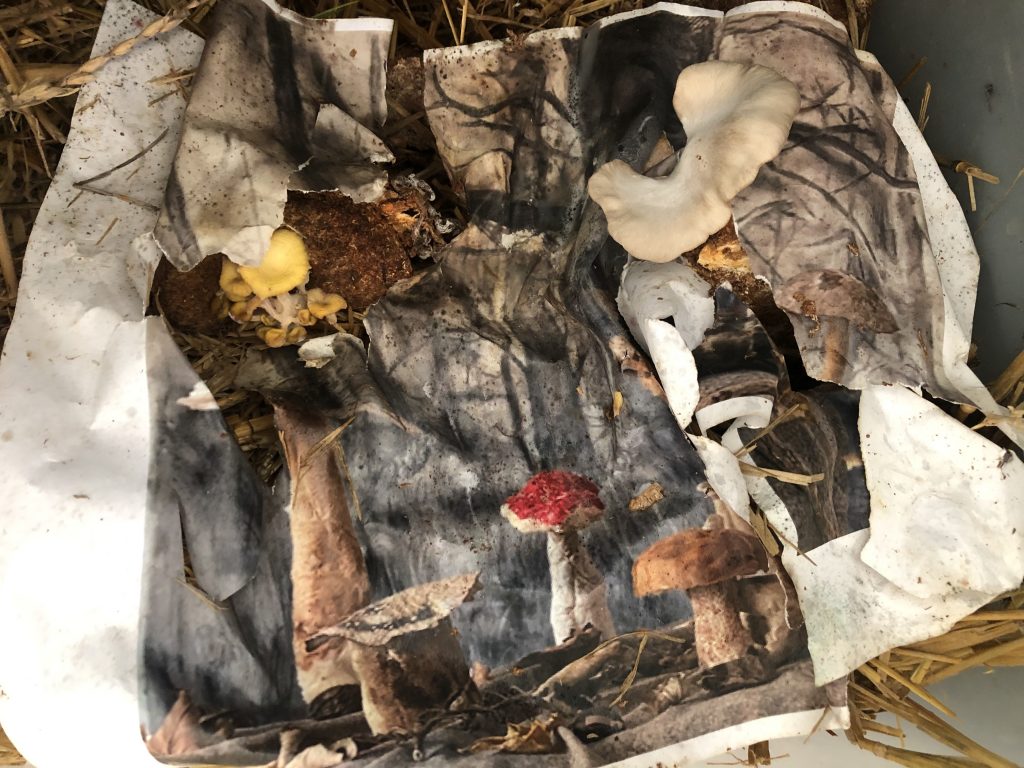
I continued adding substrate to the work in the hope it will be completely deconstructed over time. Below are images taken in the last week of August and on 1 September 2022. I decided to make a video of these images I have taken over time and share this as a documentary work for the upcoming assessment.
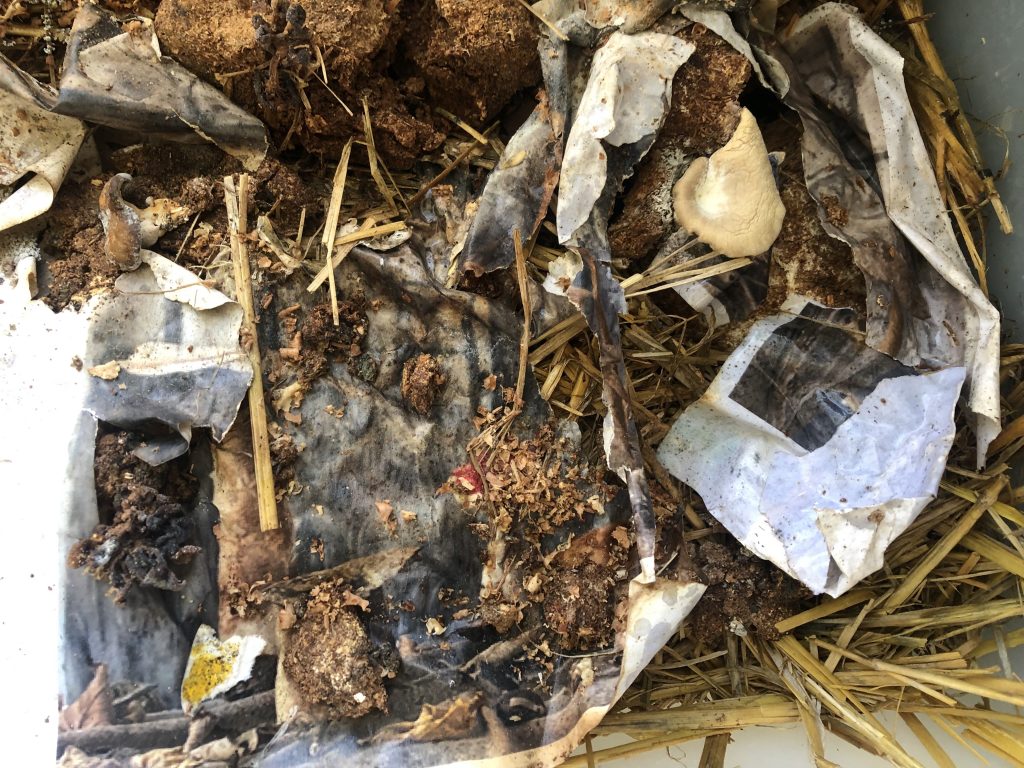
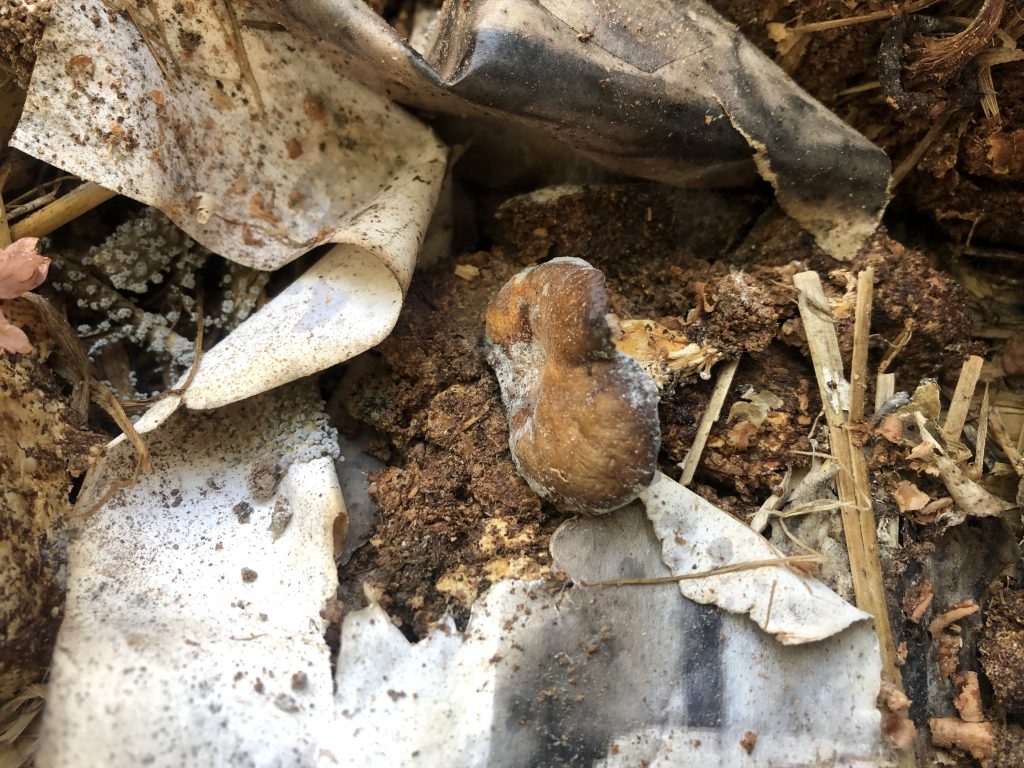
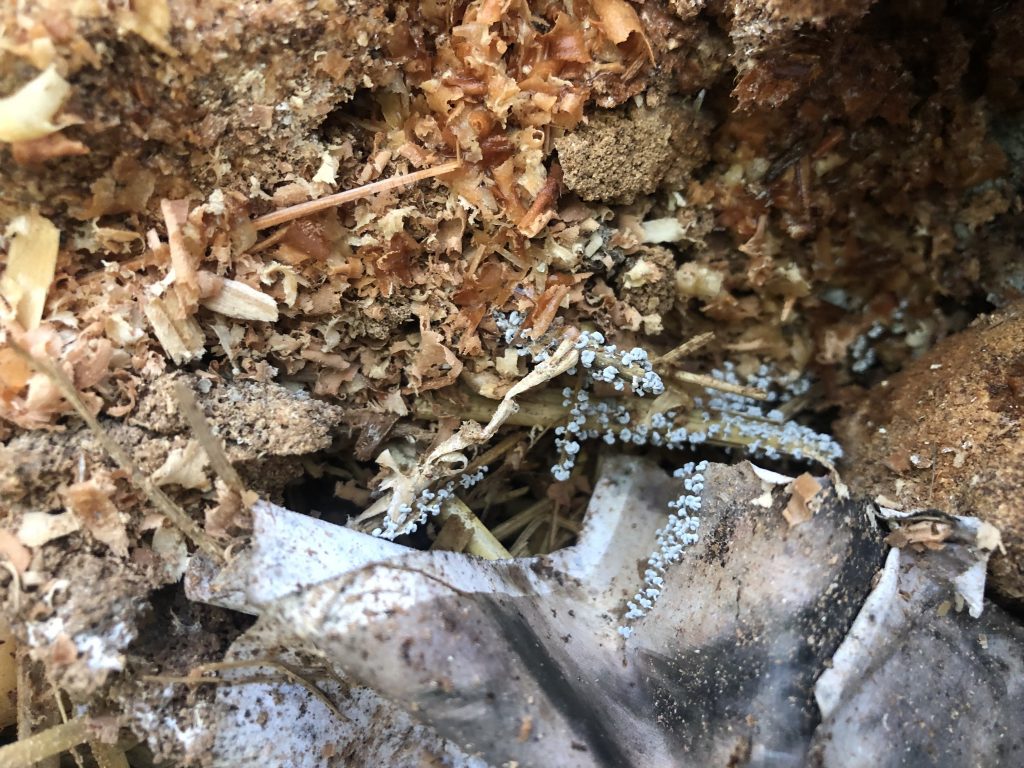
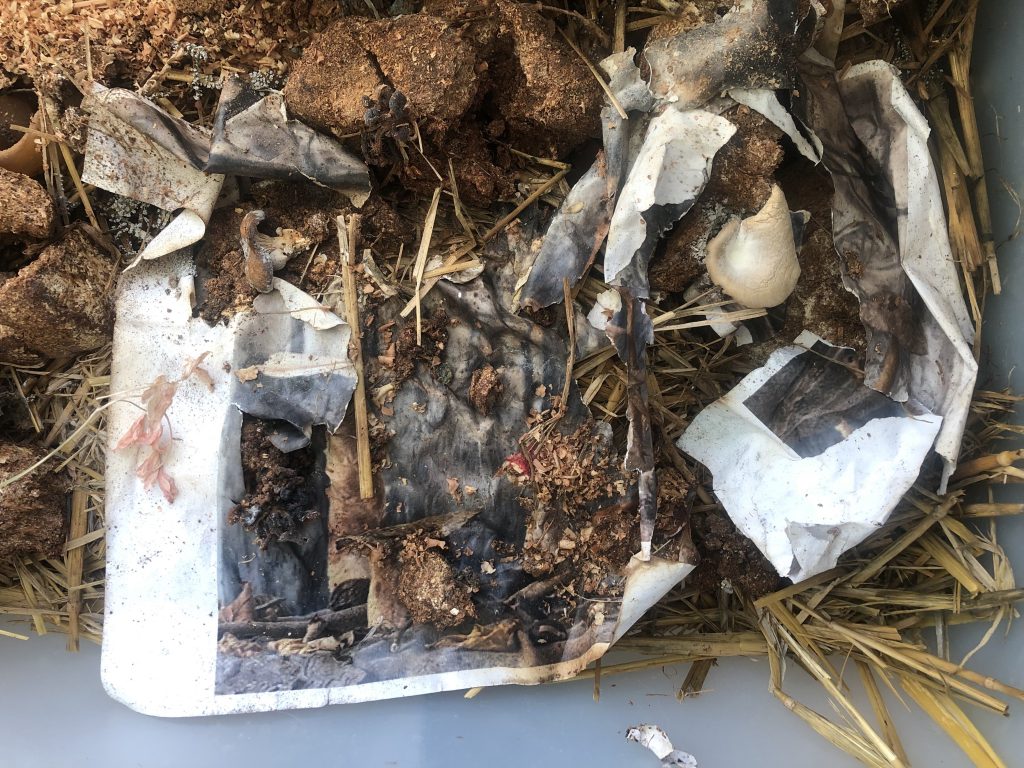
The following insert is a follow-up of Merlin Sheldrake I found on his YouTube channel. I have now come upon applications where the vibration of plants is translated to sound/music. I do like what Sheldrake has created as seen in the video below.
He wrote that the video and recording of the book being digested were made by the sound ecologist Michael Prime (Youtube: ‘Carbon Ladder’). The electrodes record the bioelectric activity of the fungus alongside its galvanic response (a machine resembling a lie detector). These data streams control a tunable oscillator. Michael Prime uses filters to shape the raw oscillator signal, but the fluctuations in pitch and rhythm we hear are a real-time sonic representation of the activity of the fungus as it eats the book. Grocycle.com inoculated and incubated the books.
In a recent workshop with OCA tutor, Dr Eccleshal, he recommended that I look at work by his PhD supervisor, Sharon Kivland. I found a book that immediately drew my attention as it relates to ideas I have with our Fungi Collaborative work, Involution, 2022. This work is called, Its Foul Weather in us All, which I learn is appropriated after the work of Marcel Duchamp when he in 1919 sent his sister a wedding present from Buenos Aires. He proposed that she leave a book outside, at the mercy of the elements, to be wind-warped and roughly read by its environment. It was referred to as the Readymade Malheureux. What I understand from the work below, is that it is based on The Tempest. (all participants received a copy) and the artists were instructed by the Italian artist, Ricardo Boglione, to leave the work outside in the weather. I like that so many things happened there – the books would become warped, soggy…. not read, cared for and kept on the bookshelf. Time, duration and the elements in nature would change it. I see possibilities for our Involution work to be done. This also motivates my idea to use text as a way to reconstruct my PP, or even deconstruct. Duration and time are the things of nature that make me feel small, I learn this from my experiments with growing mushrooms as food and possible art making.
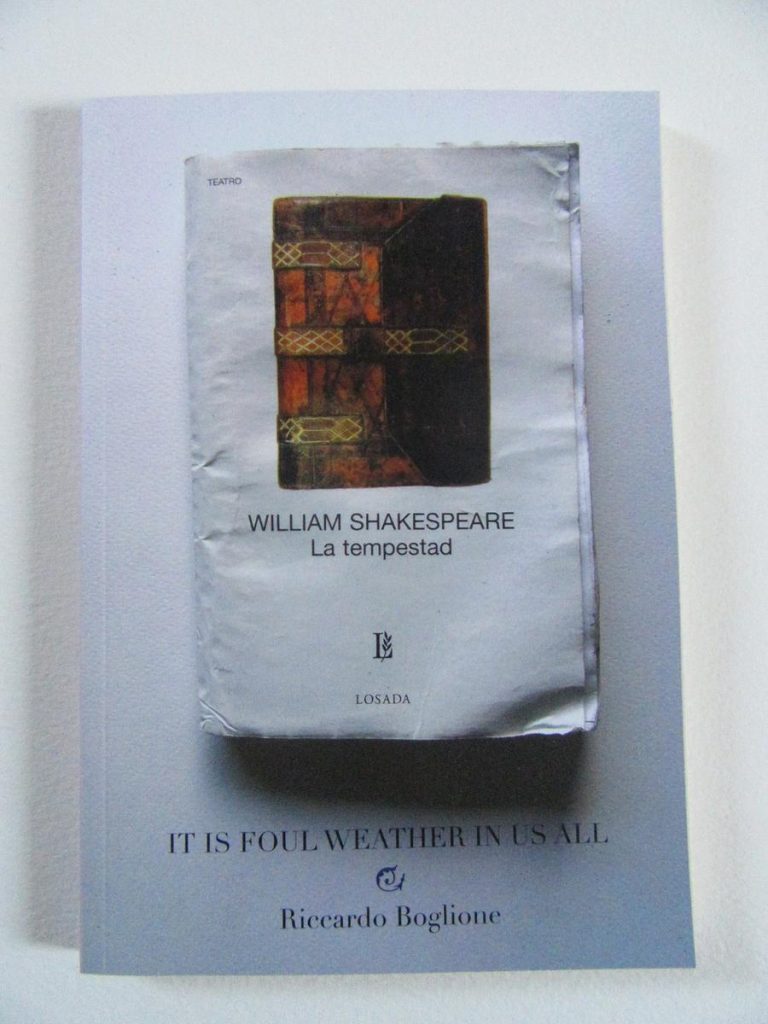
In the second week of September 2022, I prepared an area in my herb garden, next to my studio and used my own mushroom culture together with coffee grinds and wood shavings to create a growing medium that will be placed under our work. My daughter-in-law has arrived back from Europe and Annette’s parcel is now with me. Below are some images of how this process of deconstruction started. Annette and I will have a Zoom session with our group on Saturday 17 September where we will informally chat about our collaboration and will share this process with the group as well as show a short video of the images and process of starting the deconstruction. I suggested I make a short video presentation which tells a little about our process and make it enjoyable for the participants to see visually how the work came together and ended up as this deconstruction installation.
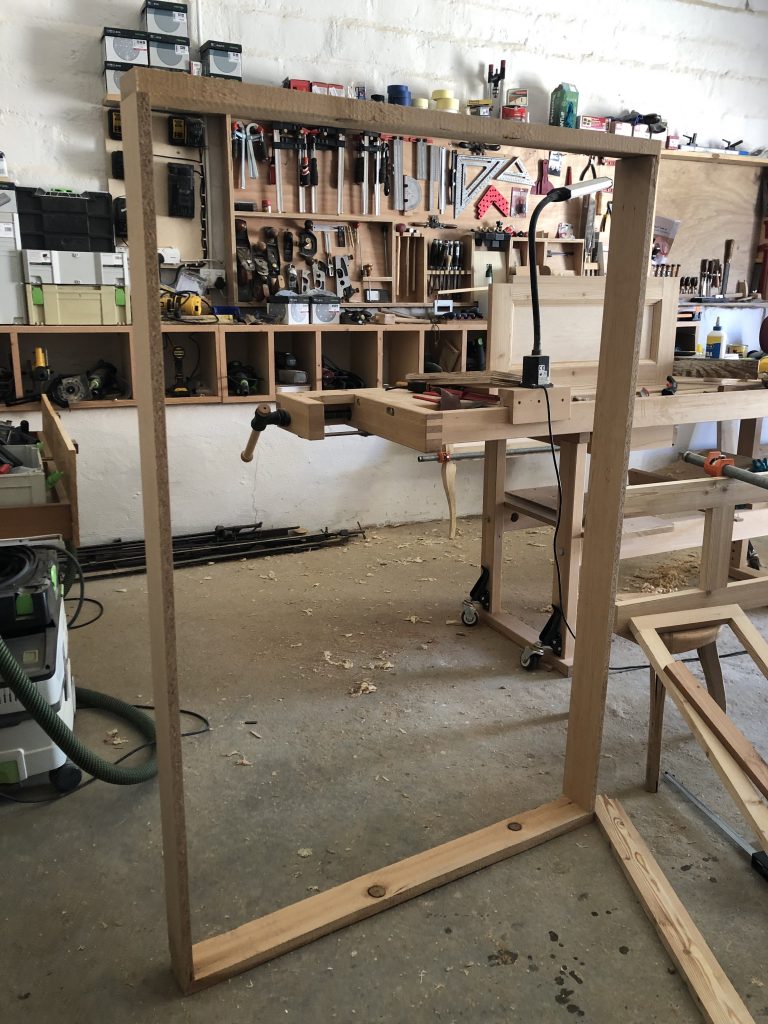
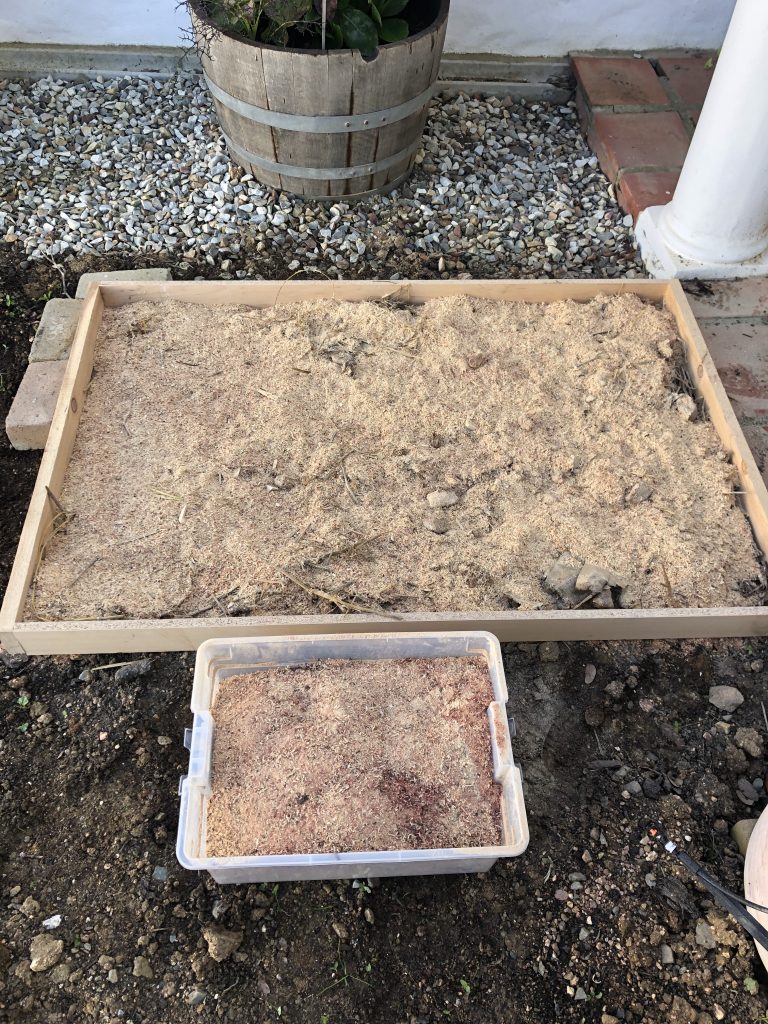
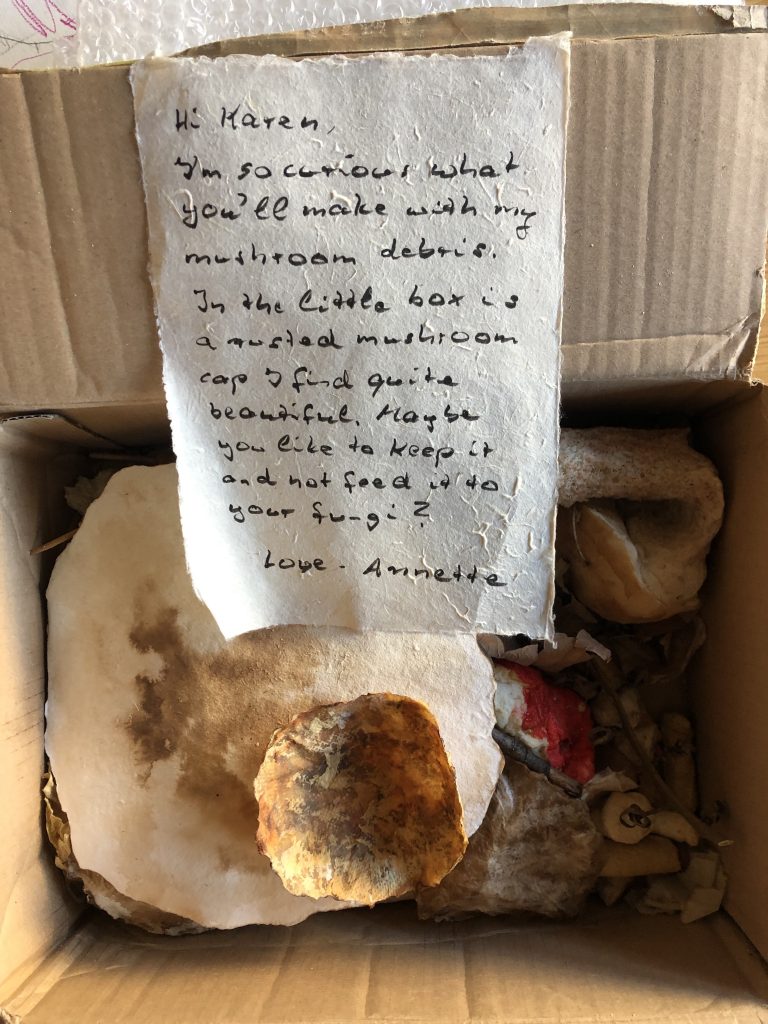
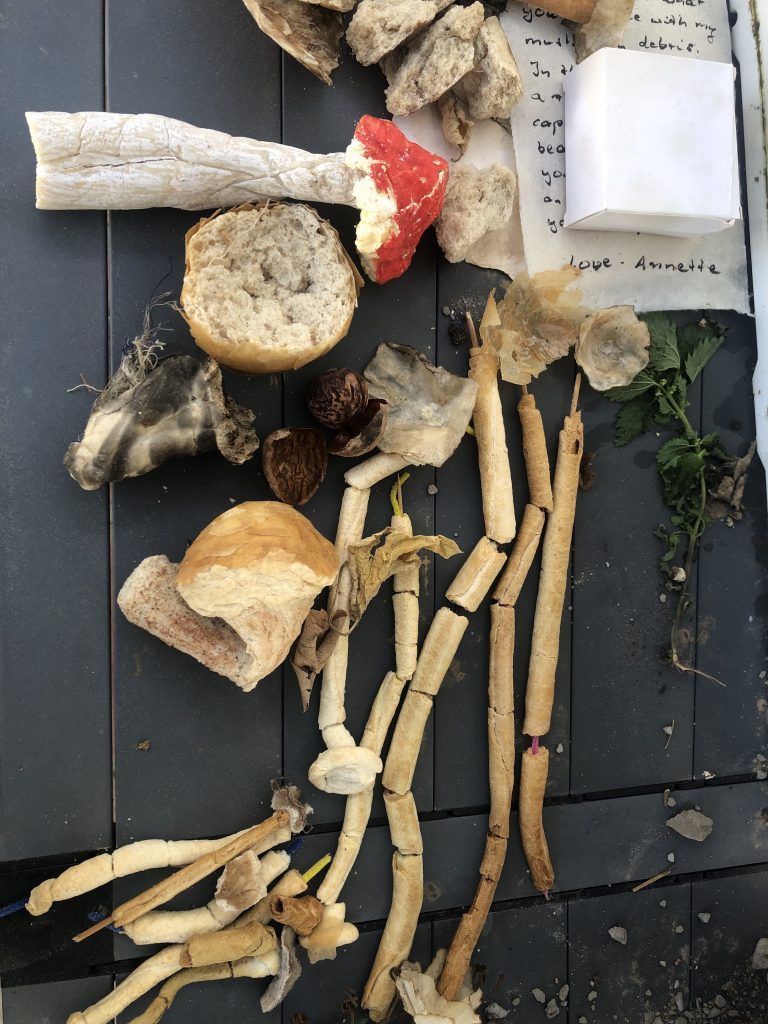
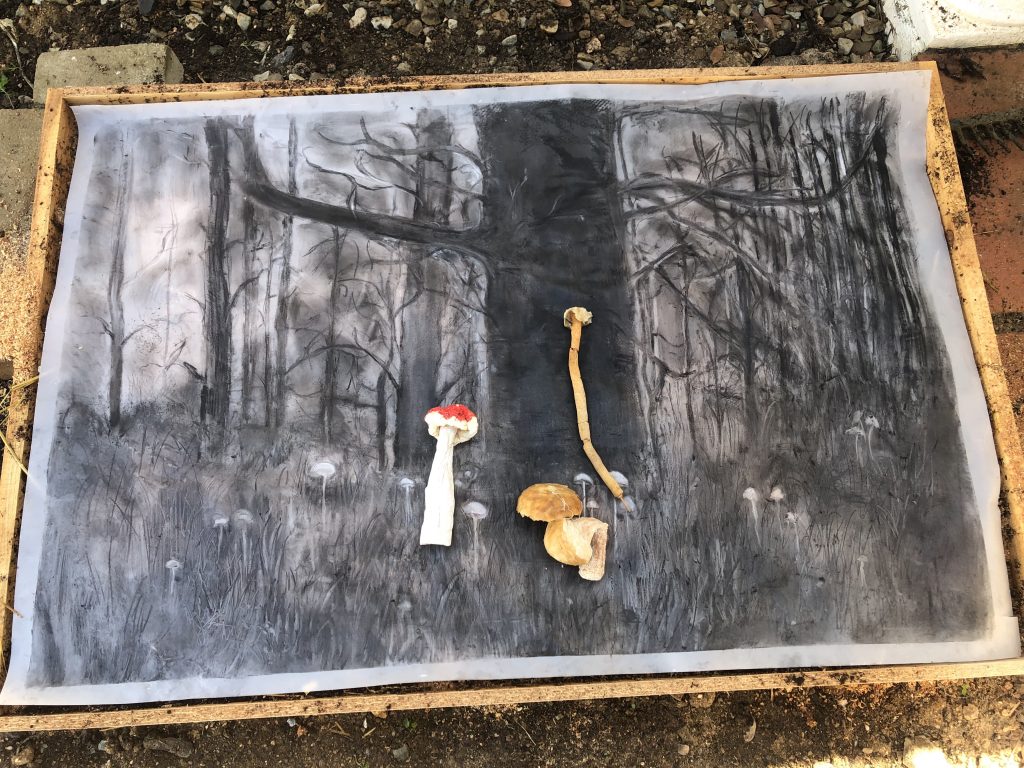
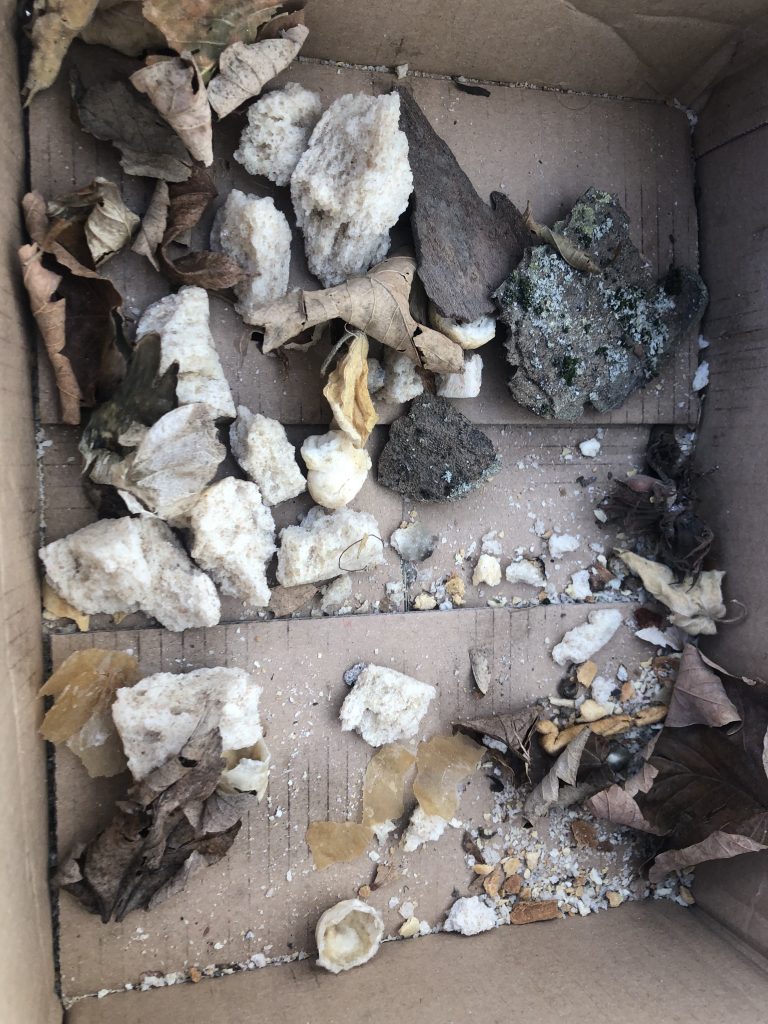
The process is recorded in a separate blog and can be accessed at: https://karenstanderart.com/decomposing-our-collaborative-work/
LIST OF ILLUSTRATIONS
Fig. 1
Fig. 2 Stander, K. (2022) Shaggy Ink Cap. [Photograph] In possession of: the author: Langvlei Farm, Riebeeck West, South Africa.
Fig. 3 Stander, K. (2022) @ Vleitjies. [Painting with ink from mushroom] In possession of: the author: Langvlei Farm, Riebeeck West, South Africa.
Fig. 4 Stander, K. (2022) Shaggy Ink Cap x 2. [Photograph] In possession of: the author: Langvlei Farm, Riebeeck West, South Africa.
Fig. 7 Stander, K. (2022) Shaggy Ink Cap [Photograph] In possession of: the author: Langvlei Farm, Riebeeck West, South Africa.
Fig. 5 Stander, K. (2022) Madelyn with Stubble Gill. [Photograph] In possession of: the author: Langvlei Farm, Riebeeck West, South Africa.
Fig. 5 Twombly, Cy. (1989) Untitled ( Gaeta). [Artwork] Viewed online at: Gargosian Gallery website At: https://gagosian.com/exhibitions/2018/cy-twombly-in-beauty-it-is-finished-drawings-1951-2008/ (Accessed on 04/11/2021)
Fig. 6 Stander, K. (2022) Decaying Shaggy Ink Cap. [Photograph] In possession of: the author: Langvlei Farm, Riebeeck West, South Africa.
Fig. 8 Stander, K. (2022) Ink [Photograph] In possession of: the author: Langvlei Farm, Riebeeck West, South Africa.
Fig. 9 Stander, K. (2022) Spore Prints of Big Sheath [Mushroom Spore print on black paper] In possession of: the author: Langvlei Farm, Riebeeck West, South Africa.
Fig. 10 Stander, K. (2022) First spore prints [shopbought mushroom spore prints on paper] In possession of: the author: Langvlei Farm, Riebeeck West, South Africa.
Fig. 11
BIBLIOGRAPHY